- Pontoon Boats

Personal Watercraft
- nauticalknowhow
- Nautical Knots
- Tools and Calculators
Types of Powerboats: 33 Types And Their Uses
If you’re new to the world of boating get ready for a surprise. There are far more kinds of boats than most people are aware of out on the water, and that includes powerboats, speed boats, motorboats or whatever you might want to call them.
For many people, “powerboat” is a kind of catchall term. Once upon a time people referred to boats in very basic terms. A rowboat had oars, a dinghy was a little boat, a sailboat had a sail and a motor boat has outboard motors and that was as detailed as most people got. But there are many different forms a powerboat can take and many different uses for them. So let’s take a look, alphabetically, at a list that may not be exhaustive but should cover nearly every kind of powerboat you’ll want to know about.
Aft-Cabin Boats
Aft-cabin boats have a room at the stern of the boat from which they get their name. An inboard engine is located at the center and you can access the helm with a set of stairs. These boats are used for cruising, especially if you plan to spend a few nights at sea.
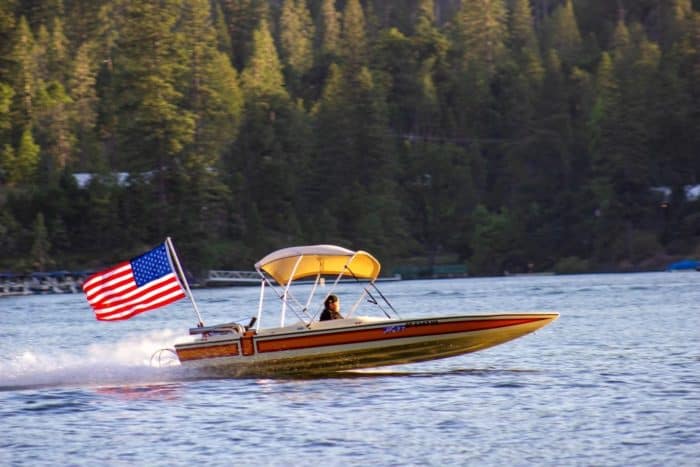
A bass boat is used for freshwater fishing in lakes and rivers. That doesn’t have to just be bass fishing. Usually these are between 14’ and 23’. They have a shallow draft and a flat deck as well as a low freeboard. You’ll often find a bass boat with a pretty powerful outboard motor and also trolling motors.
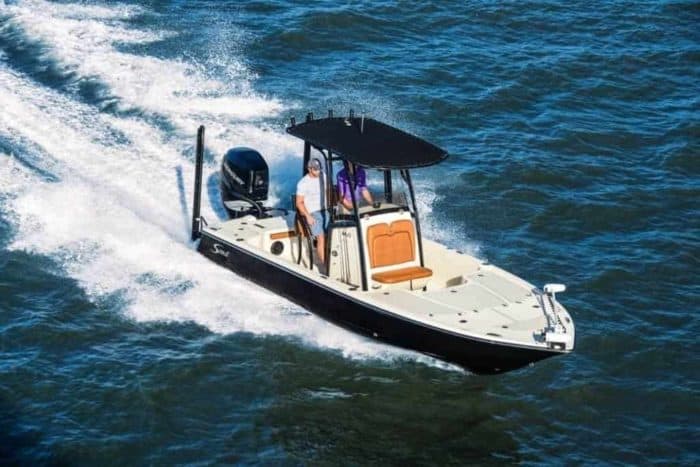
A bay boat , as the name implies, are designed for use in places like bays and coastal waters. That means shallow water, typically. Expect a fiberglass hull, a length between 18’ and 24’ and a low freeboard center console. They have a low profile overall and usually offer good speed.
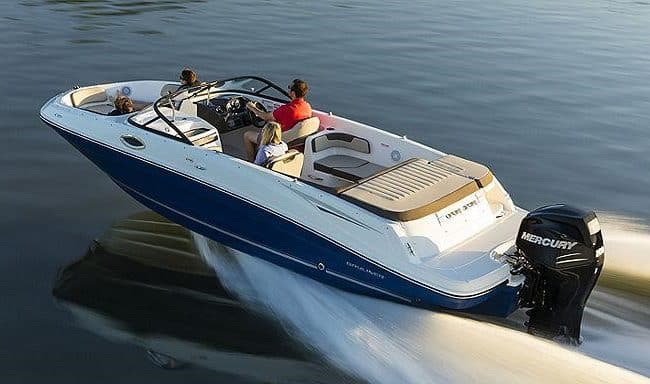
Like the name suggests, you can ride in the bow of a bowrider . The bow end is opened up to allow for extra seating in front of the helm. Expect a bowrider to be a modest length, between 17’ and 30’. The hull is V-shaped to allow for a smooth ride cutting through coastal or inland waters. With room for up to 8 people, these are good boats for family cruising or fishing.
Cabin Cruisers
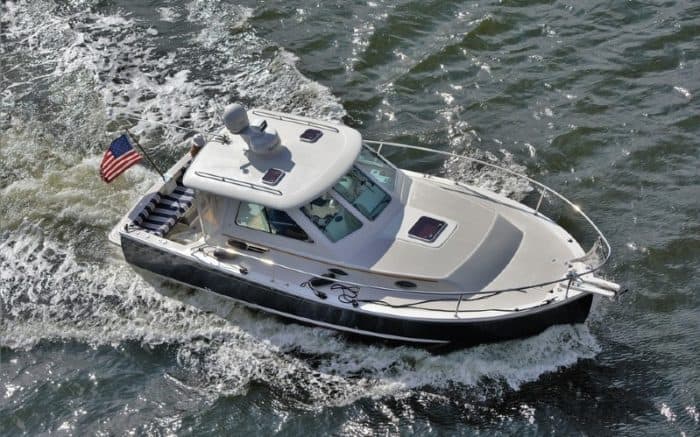
This is a boat that, like the aft-cabin, plays a little fast and loose with strict definitions. If you can sleep on a boat, it’s a cabin cruiser. Now that doesn’t mean napping on a canoe or anything, but if the boat has specific accommodations meant for sleeping, no matter what other kind of boat it may be, it is also now a cabin cruiser. So it could also be a catamaran, a yacht, a flybridge, or any number of other vessels. But it would still also be a cabin cruiser. More specifically, though, a cabin cruiser will likely have a v-shaped hull, comfortable amenities for multiple passengers, and a secure drive shaft mechanism.
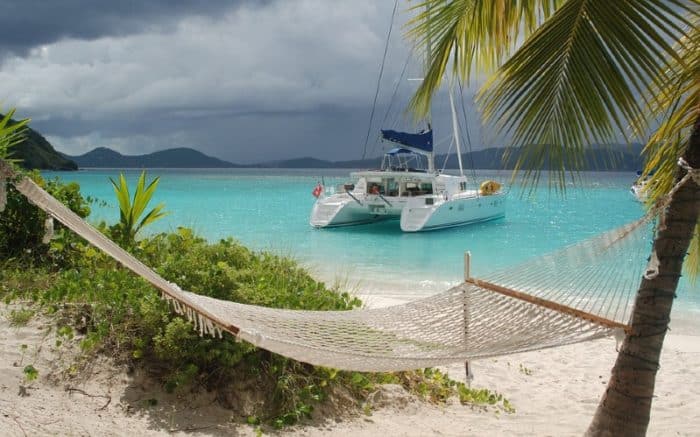
Catamarans are dual hull boats which gives them exceptional stability. Some catamarans also offer sails in addition to motors. They can give you better fuel economy and speed than monohull boats as well. Most catamarans are between 25’ and 40’. Though they have a lot of perks, they can also be pretty expensive compared to other boats.
Center Console
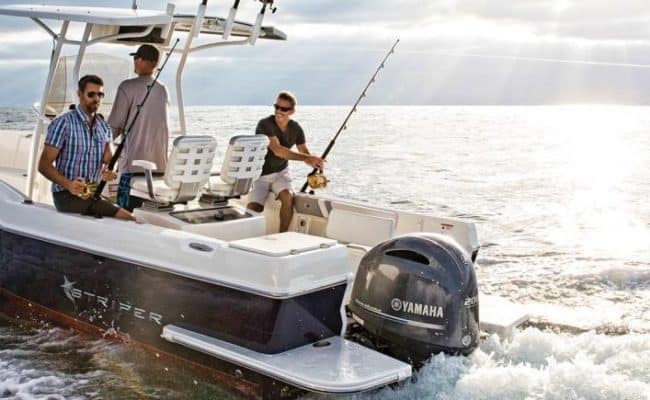
Just like the name suggests, a center console boat will have the helm controls located on a center console in the middle of the boat. The open hull design means you can walk all around the center console which is great for fishing, especially offshore. The motor is usually an outboard and length can range anywhere from a relatively small 13’ all the way to over 40’.
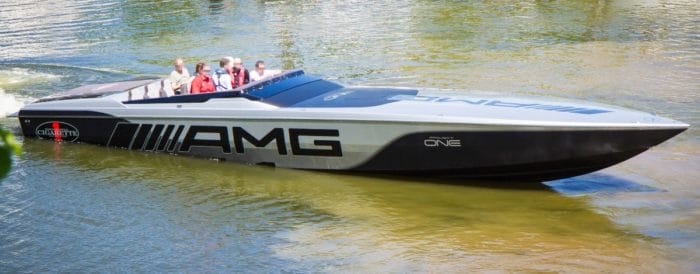
You’ll see these called cigarette boats and, more properly, go-fast boats. They’re long and narrow and built for speed as the “go-fast” name implies. These are performance boats so if you’re not into racing you’re not likely to come across one.
Convertible Boat
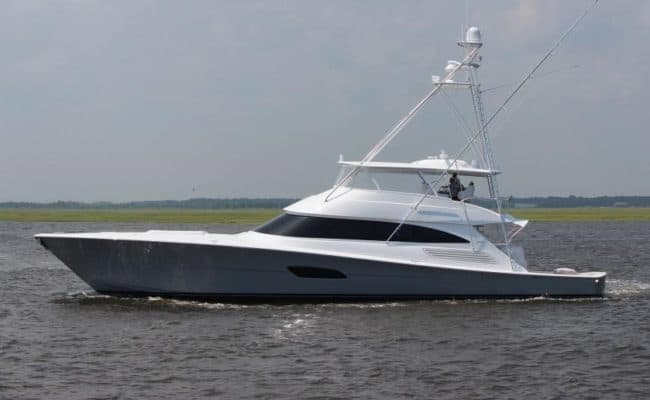
Convertible boats are big boats, starting at a minimum of 35’. They feature an open cabin and a flybridge and are ideal for offshore fishing and cruising. Fishing is done from the aft deck which should be a decent size for several anglers.
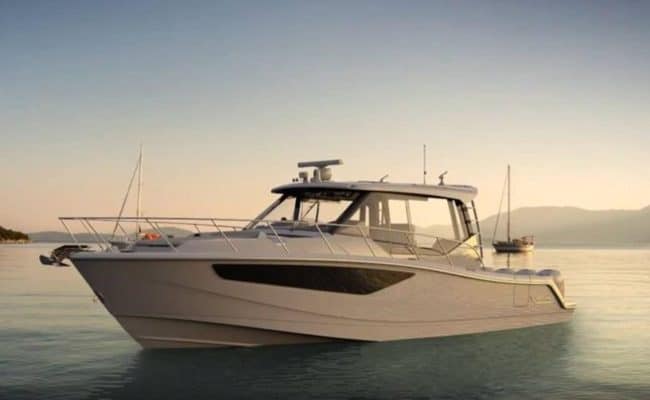
Smaller than a convertible, a cruiser can still be a good size of 21’ up to 45’. You’ll find a cabin up in the bow of the boat along with a galley and a head. There is enough room to make for a comfortable night’s stay.
Cuddy Cabin Boats
Cuddy cabins are usually between 22’ and 30’ and feature a storage cabin which is where the name comes from. They may have a small berth or even a head as well, but not what you’d call a proper sleeping cabin for extended nights on the water. These are great for coastal cruising and maybe a weekend getaway.
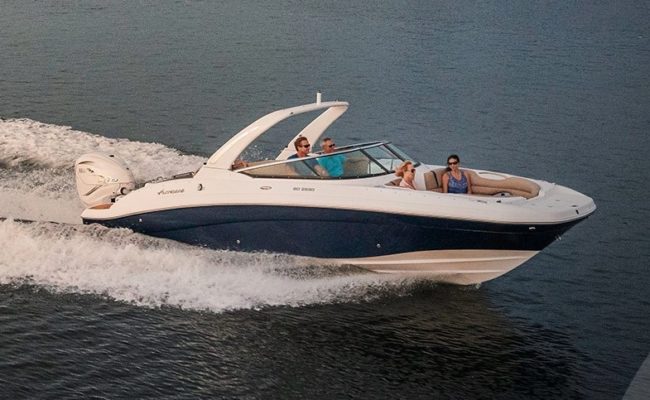
A deck boat is usually identified by its squared bow and boxy shape. They have a lot of deck space which is where the name comes from. These are not designed for speed but they are designed for group outings and can accommodate more people than many boats of a similar length. If you’re looking for a party or excursion boat, or even one for swimming and water sports, these are good choices.
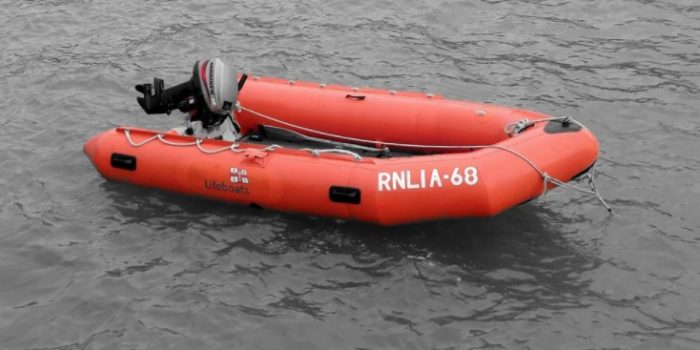
A dinghy is a small boat best suited for just one or two people. A dinghy would reach 12’ in length at the maximum and will likely be considerably smaller. Many dinghies are not powered at all but they can be operated by small outboard engines. They can be inflatable or hard-sided boats and are often carried by larger vessels as emergency use boats.
Down East Cruiser
Sometimes called lobster boats these are actually designed based on east coast lobster boats. They feature a narrow entryway, comfortable accommodations and a lower helm station. Some may have fly bridges as well. The cabin should have a few berths and a dining area.
Dual Console
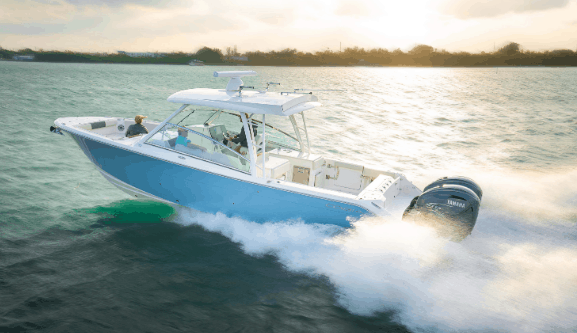
Like the name suggests, you have a pair of consoles and dashboards on a dual console . There will be a passageway between them to allow movement to the bow area. These are usually 16’ to 30’.
Express Boat
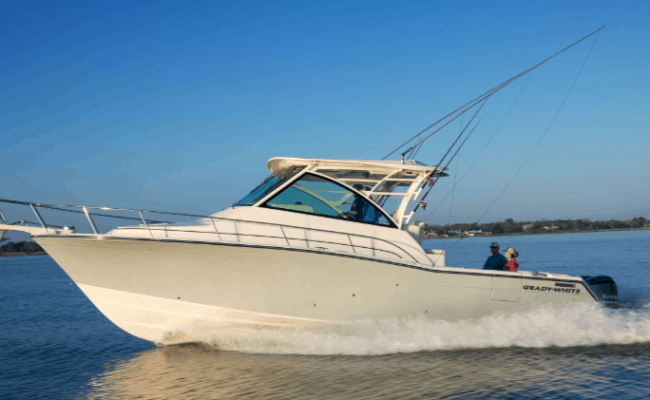
As you might guess, an express boat, or express fisherman, is designed with speed in mind. The cabin will be to the front and below the helm. These are great for offshore fishing, especially if you’re not interested in the slow cruising from place to place and want to get to your destination quickly.
Fishing Boat
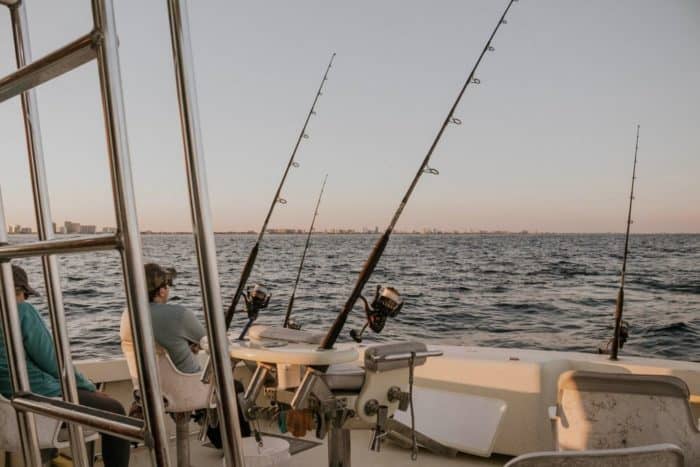
Another entry that plays a little fast and loose with what exactly it means. A lot of boats can be fishing boats , after all. But typically, a fishing boat is going to have a trolling motor, reliable maneuvering, live wells and space for holding fishing rods. There may be a host of other features but those are the things you need in order to consider it a true fishing boat.
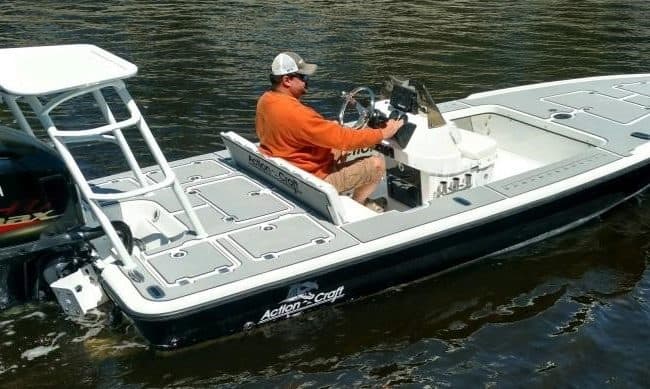
Flats boats are designed with shallow waters in mind. A long length and a very shallow draft make these good for waters other boats couldn’t handle. When things get very precarious and you can’t use your motor you’ll also have a push pole for navigation. A flats boat will likely not exceed 18’.
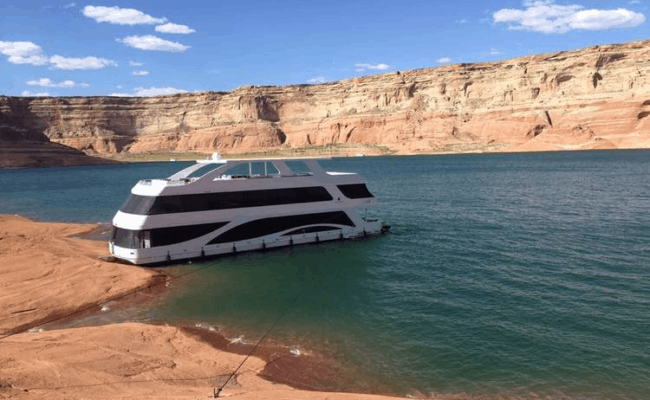
Houseboats can take a number of forms but most of us know one to see one as they often look like RVs on the water. Sizes can vary greatly from a smaller 25’ to 30’ all the way up to around 150’. Typically squared off at the ends and featuring a barge like hull, these have full amenities. Multiple bedrooms, a full kitchen and additional living spaces make these true houses on the water. These are best suited for calm, inland waters. They can be used for cruising, fishing and water sports but often are moored in a permanent location.
Inflatable Boat
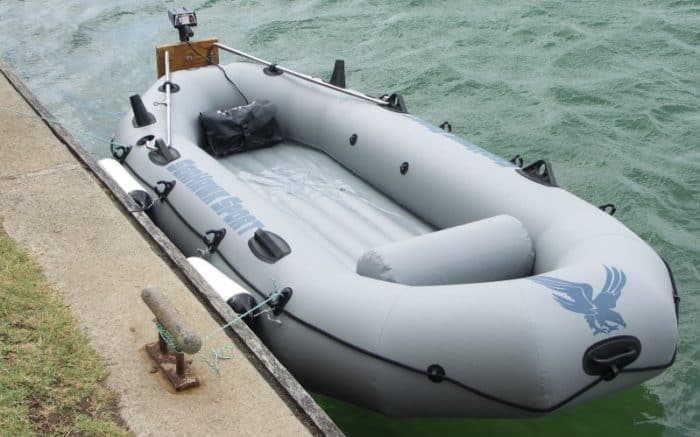
These are good beginning boats for use in inland waters. They feature an inflatable hull though the floor is usually something rigid which could be anything from aluminum to wood. Buoyancy is provided by the outer tube of the boat which is filled with air and protected by a sturdy material that is resistant to tearing but is still less durable than something like fiberglass or aluminum. An outboard motor fixed to the transom provides power. Various boats like pontoon boats and dinghies may also be inflatable boats.
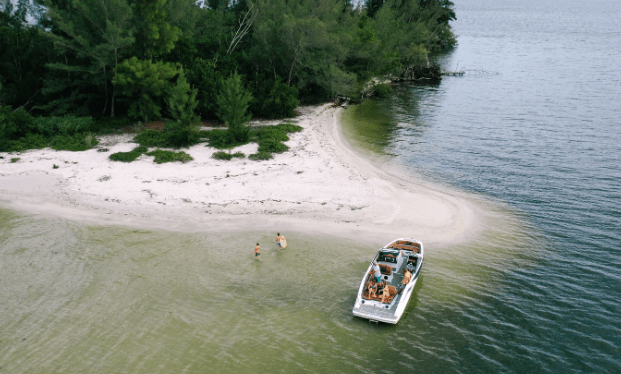
A jet boat is not, strictly speaking, a motorboat like many of these others but it is still a powerboat. The jet part of the name refers to the propulsion system which sucks into the jet propulsion unit and then forced out again with greater speed and force. There are no propellers involved. Any boat that uses a jet propulsion system is therefore a jet boat. Jet boats can attain high speeds and can also handle shallow waters more easily than motor boats.

A jon boat is a great basic or starter boat. Made of aluminum or sometimes fiberglass they have a flat bottom and are best used in shallower waters. They’re ideal for a fishing trip for one or two people and don’t have a lot of bells and whistles. They’re also pretty easy to handle and relatively inexpensive. If you have little experience with boating but want to try your hand at it on a lake or pond, especially for fishing, this is potentially something you’ll want to take a look at.
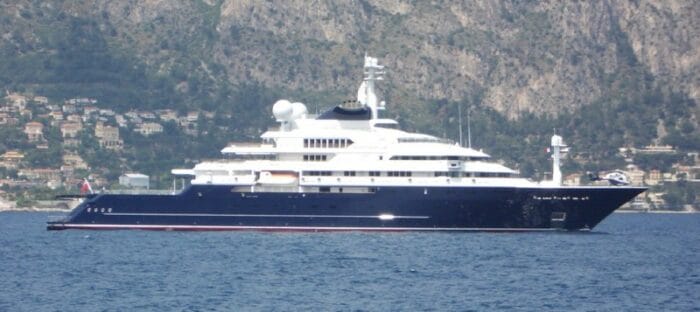
I don’t own a megayacht and probably never will but they still exist. To qualify as a megayacht it needs to be at least 200’ in length and can get up to 500’. These things aren’t sold at your local marina, they’re custom made for millionaires and billionaires. The 533-foot Eclipse megayacht features 24 guest cabins, two swimming pools and a missile-detection system.
Pilothouse Boat
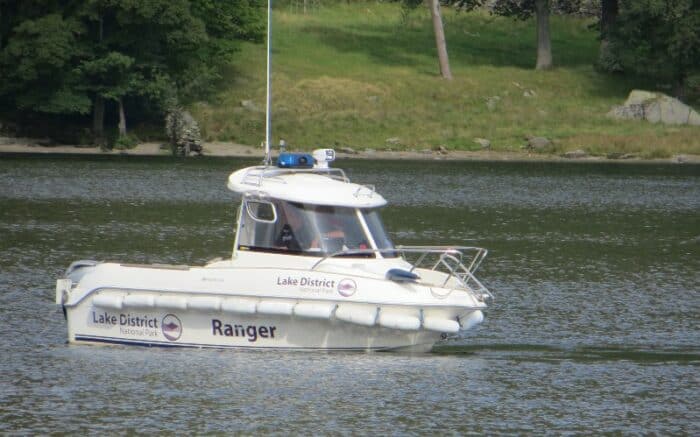
A pilothouse boat obviously has the actual pilothouse as a prominent feature. This will be a fully enclosed structure which makes them ideal for use on rough seas. Because the pilot house is enclosed even in the worse storms the helmsman remains relatively safe and dry. A lot of commercial fishing type vessels have enclosed pilot houses but they are also well suited for cruising. At a length up to 35’ you can expect a cabin and a berth. Inboard, outboard or stern drive motors are all possibilities for a pilothouse boat.
Pontoon Boat

Pontoon boats use a pontoon system to stay afloat. Large aluminum or inflatable pontoons are the source of buoyancy and act as a foundation for the rest of the boat. Most pontoon boats feature these large, air-filled tubes on either side of the boat. Some models include a third pontoon in the center and may be referred to as a tritoon boat. Pontoon boats usually have a large deck surface and are great for fishing or as a family boat. Speed is not their strong suit but you can expect to get up to 30 mph in a modern pontoon.
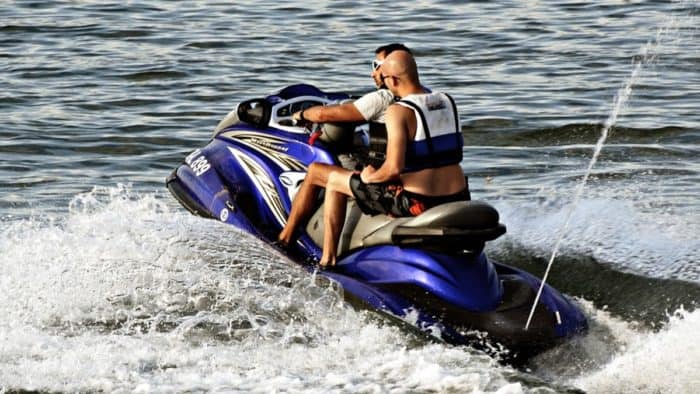
Personal watercraft, sometimes abbreviated as PWC are also colloquially known as jet skis. Jet ski is actually a name brand much like Kleenex is a name brand of tissue but it shows the market dominance of that particular brand that many people will call any personal watercraft a jet ski. These vessels are best suited for one or two people maximum. They are often far cheaper than larger powerboats but obviously offer less versatility. Like jet boats, a personal watercraft uses jet propulsion so there is no propeller. They are recreational vehicles and are often used just for fun and racing in coastal or inland waters.
Rigid Inflatable Boat
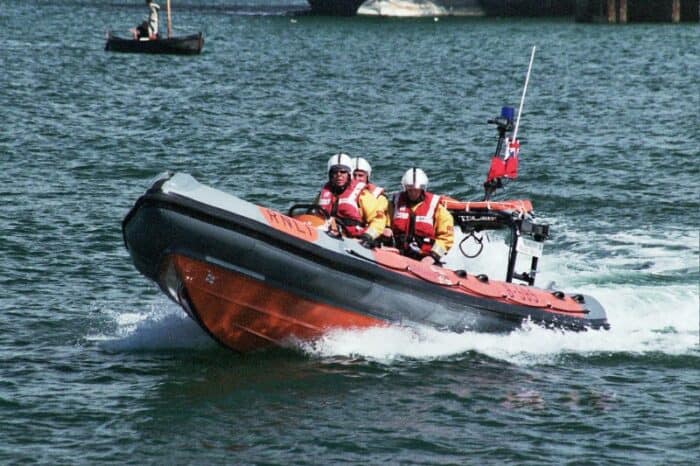
This is a slight tweak to the idea of the inflatable boat mentioned earlier. Rigid inflatable boats, or RIBs, is kind of a combination of both an inflatable and a rigid boat. A rigid fiberglass or aluminum hull like you’d find on a traditional boat, is surrounded by inflatable tubes to increase buoyancy. Because of the combination of materials these are stronger and faster than normal inflatables and can carry a greater amount of weight. They also come in longer lengths than traditional inflatables.
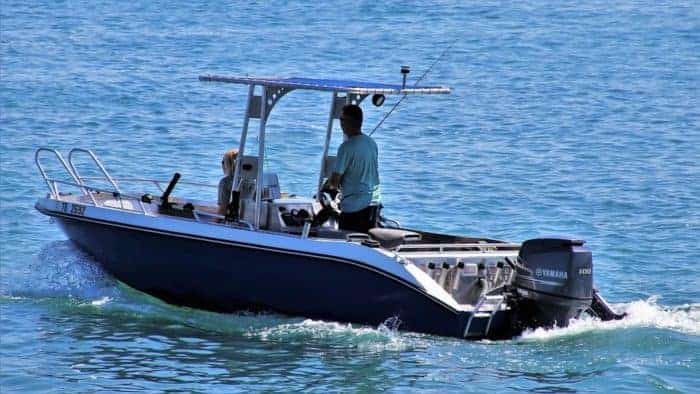
This is another type of boat that is a sort of vaguely defined vessel and several other types of boats can qualify as a runabout. Typically this refers to a small vessel, so think under 25’. They’re powered by an outboard or sterndrive and can work as a fishing boat, a sport boat, or just a cruiser. If it’s small and fast, it could be called a runabout.
Sedan Bridge Boat
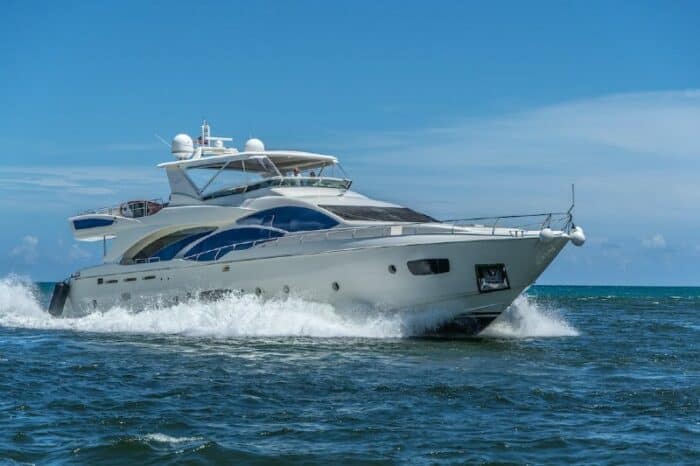
A sedan bridge boat would be considered a yacht by most people at first glance. They’re designed for cruising and have accommodations that make longer stays at sea comfortable. The cockpit is easily accessed and is high enough above the water, near the level of the boat’s aft deck to provide exceptional visibility. It’s not a boat intended for great speed but comfort during longer trips.
Ski Boat (Wakeboard Boat)
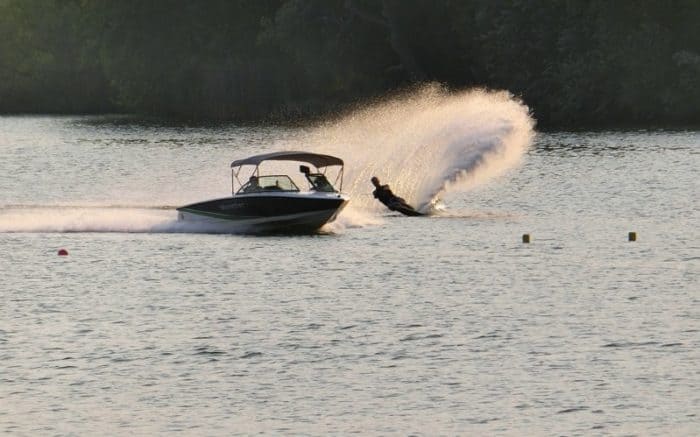
A ski and wakeboard boat is designed with water sports in mind. That means speed is the name of the game to allow for water skiing and wakeboarding. The design of a ski boat actually allows you to adjust the wake you produce. Ballast can be added so you make a larger wake and the person you’re towing can perform more tricks as a result.

With a flat bottom, a skiff and a jon boat are often hard to tell apart. A skiff usually has a more pointed bow, though it may be a little more rounded. They have a shallow draft and are well suited for navigating shallow waters as a result. They don’t feature too many bells and whistles and steering is typically managed at a center console.
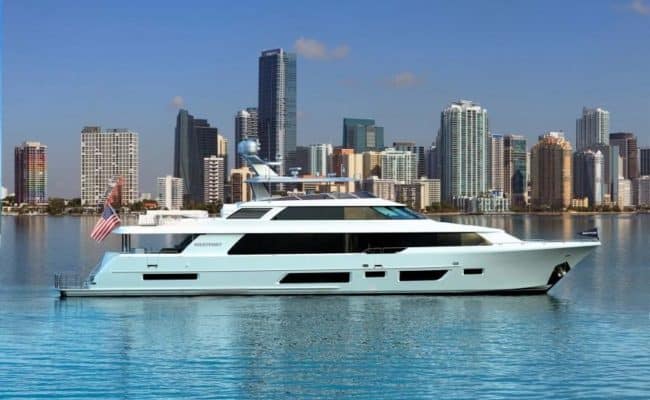
A superyacht is between a regular yacht and a megayacht, which means between 100 feet and 200 feet. The most expensive yacht in the world is a superyacht called the History Eclipse which cost a baffling $1.5 billion and includes missile launchers, two helipads and its own mini-sub.
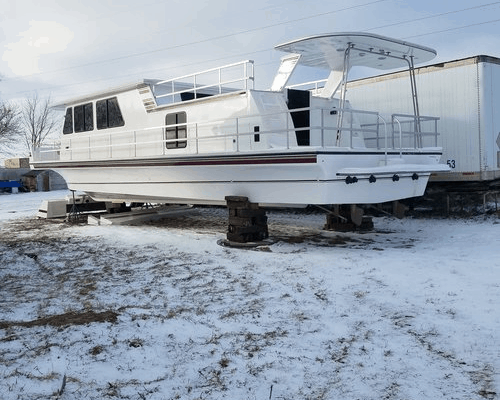
Strictly speaking, a yacht is another vessel that can be loosely defined. Under 100 feet, any cruising vessel that can accommodate overnight stays could potentially qualify as a yacht. Of course, most of us would associate the term with a high end vessel that features a number of luxuries as well.
Is It Feet in Length That Changes the Definition Between Boats?
You’ll notice for a lot of these boats that the difference seems to be little more than size. Nowhere is this more apparent than with the three yachts I’ve listed. A “normal” yacht hits 100 feet, while a super yacht gets up to 200 feet and a megayacht can reach 500 feet. If you get much longer than that you may be dealing with a cruise ship.
A lot of regulations regarding boats are determined by their length. This also affects insurance so it’s true, the length of a boat has a lot of importance in factoring what kind of boat it is, where it can be used, who can pilot it and what it will cost you.
The Bottom Line
Like I said before, this is not even an exhaustive list despite how many entries there are. New boats are being designed all the time and some terms cross over from one kind of boat to another in terms of definition. You can get anything from a multipurpose boat suitable for fishing or the ultimate family boat which is best suited to inland lakes. But this should serve as a good primer to start you off and help you identify whatever powered boats you’re seeing out there on the water. As always, stay safe and have fun.
My grandfather first took me fishing when I was too young to actually hold up a rod on my own. As an avid camper, hiker, and nature enthusiast I'm always looking for a new adventure.
Categories : Boats
Leave a Reply Cancel reply
Your email address will not be published. Required fields are marked *
Save my name, email, and website in this browser for the next time I comment.
More in Boats

What Is A Gunwale?

131 of the Best Hawaiian Boat Names

167 Patriotic Boat Names

The 138 Best Boat Names for Dog Lovers

The People’s Poncho Review and Ratings

Oru Lake Kayak Review

About Boatsafe
Established in 1998, BoatSafe is your independent guide into the world of boating, fishing, and watersports. We provide expert insights and detailed guides to help you find products tailored to your needs and budget.
Contact Boatsafe
- Address: 4021 West Walnut Street. Rogers, AR 72756
- Phone: (479)339-4795
- Email: [email protected]
Site Navigation
- How We Test
- Corrections Policy
- Privacy Policy
- Terms & Conditions
- Editorial Policy
- Affiliate Disclosure
Our Reviews

All content is © Copyright 2024. All rights reserved.

Service Locator
- Angler Endorsement
- Boat Towing Coverage
- Mechanical Breakdown
- Insurance Requirements in Mexico
- Agreed Hull Value
- Actual Cash Value
- Liability Only
- Insurance Payment Options
- Claims Information
- Towing Service Agreement
- Membership Plans
- Boat Show Tickets
- BoatUS Boats For Sale
- Membership Payment Options
- Consumer Affairs
- Boat Documentation Requirements
- Installation Instructions
- Shipping & Handling Information
- Contact Boat Lettering
- End User Agreement
- Frequently Asked Questions
- Vessel Documentation
- BoatUS Foundation
- Government Affairs
- Powercruisers
- Buying & Selling Advice
- Maintenance
- Tow Vehicles
- Make & Create
- Makeovers & Refitting
- Accessories
- Electronics
- Skills, Tips, Tools
- Spring Preparation
- Winterization
- Boaters’ Rights
- Environment & Clean Water
- Boat Safety
- Navigational Hazards
- Personal Safety
- Batteries & Onboard Power
- Motors, Engines, Propulsion
- Books & Movies
- Cockpit Confessions
- Communication & Etiquette
- Contests & Sweepstakes
- Colleges & Tech Schools
- Food, Drink, Entertainment
- New To Boating
- Travel & Destinations
- Watersports
- Anchors & Anchoring
- Boat Handling
Types of Powerboats and Their Uses
Advertisement
What Is An Outboard Runabout?
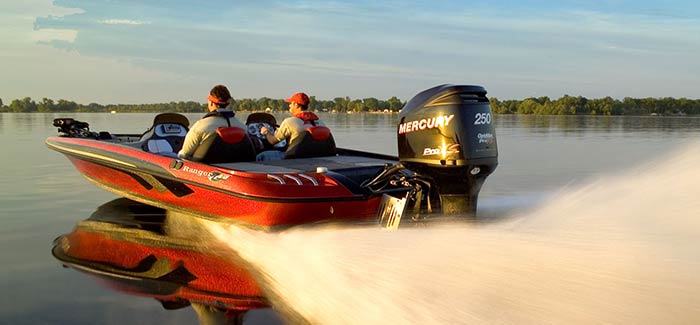
Bass boats are generally 14' to 23', and typically used for freshwater fishing. They have low freeboard and a V hull. They are specialized for bass fishing on inland lakes and rivers. Due to the special gear, high horsepower outboards and trolling motors they are a relatively high price point.
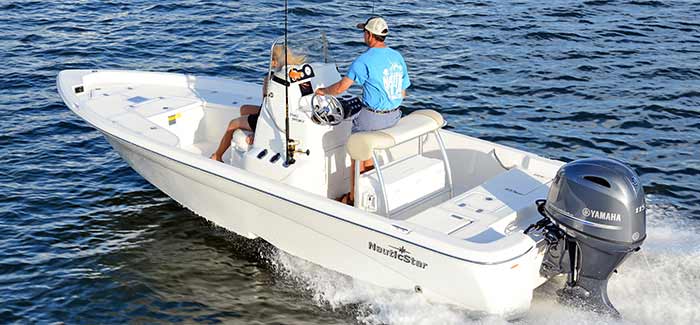
Bay boats have a low profile. They are designed for use in shallow waters of large shallow bays, estuaries or near shore. Bay boats are 18'–24' in length and are fiberglass because they are used in salt or brackish waters. They have more freeboard than a flats boat.
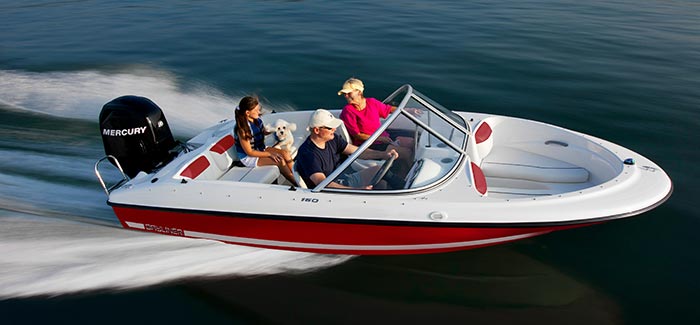
A bowrider has an open bow area designed for extra seats forward of the helm. Bowriders are usually 17'–30'. They are powered by either stern drive or outboard engines. Considered a family boat and can be used for fishing and water sports. A good choice for those new to boating.
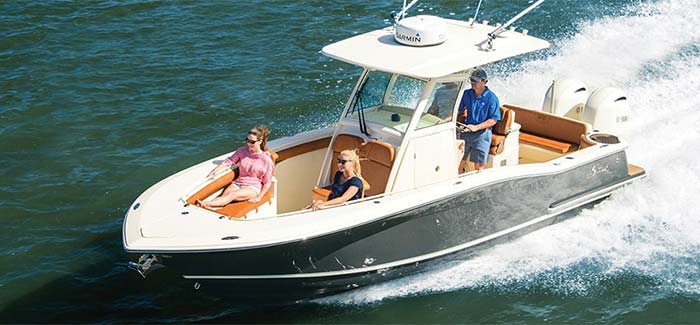
Center Console
Center console boats are from 13'–45'. They are so-named because their helm is on a console in the center of the boat. Like walkarounds, the open hull helps anglers walk from bow to stern without having to navigate around the console. Most use outboard motors for propulsion and the larger size boats are suited for offshore fishing.
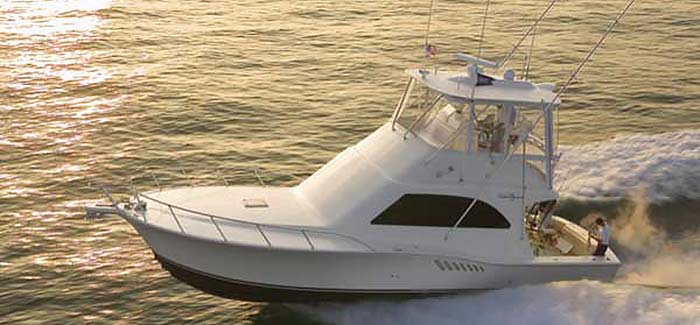
Convertible Fishing Boat
Convertibles are 35 foot and greater boats suited for offshore fishing and cruising. They have large cabins, galleys and berths and are perfect for pleasure cruises and offshore fishing. The flybridge with elevated helm helps to spot flotsam or fish. They have a large fishing deck aft.
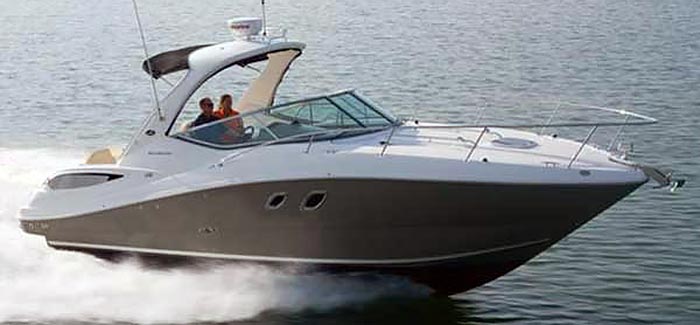
Cruisers are from 21'–45' in length and have a cabin in the bow of the boat. Cruiser cabins are designed for an overnight stay and are typically large enough for a small galley, several berths and an enclosed head.
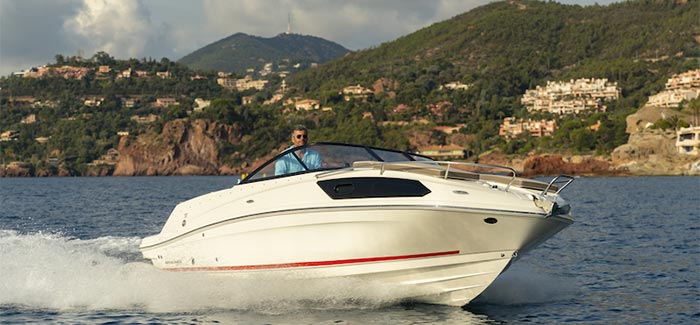
Cuddy Cabin
Cuddy cabin boats have a small cabin for storage or a small seating area. They may accommodate a berth and or head. They are usually about 22–30 feet in length.
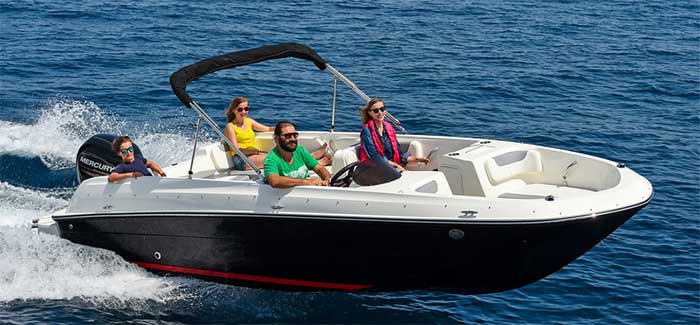
Deck boats have a wide beam and feature a V-shaped hull which offers more performance than a pontoon boat. Featuring an open deck with plenty of seating for parties or family. Used for swimming and water sports. They are outboard or stern drive powered and can be aluminum or fiberglass. These boat are about 25–35 feet long.
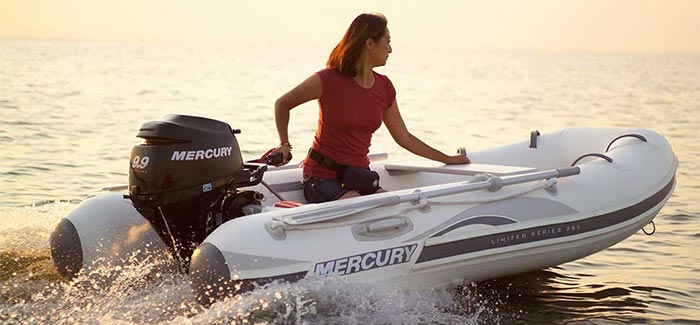
A dinghy is a small boat, usually 7–12 feet in length. They are usually powered by oars, small outboards, or sails. Often carried or towed by a larger boat for going ashore. Low cost and an excellent choice for those new to boating.
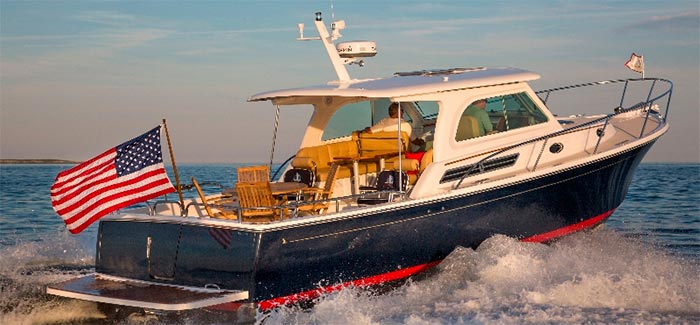
Downeast Cruiser
These boats are native to coastal New England. Also called lobster boats, they are built for offshore cruising and fishing. They have a cabin with berths and a head and dining area.
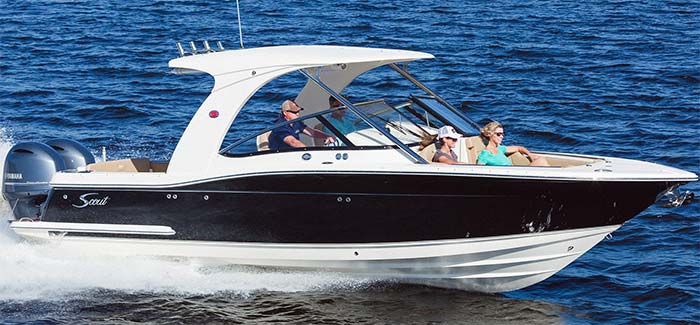
Dual Console
Dual Console boats have two dashboards and windshieldswith space to walk between them for allowing access to the bow area for seating and/or fishing. Lengths run 16–30 feet.
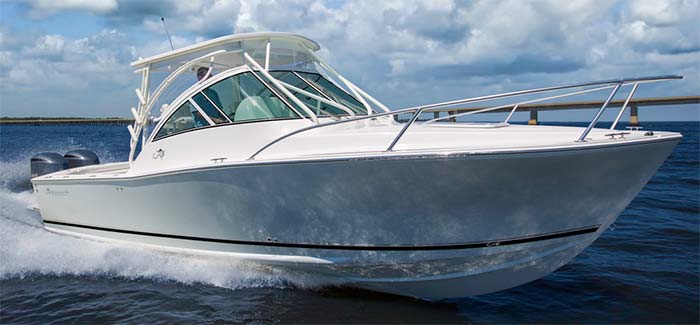
Express Fisherman
The Express Fisherman is designed for high speeds to get to offshore fishing spots in a hurry. They are rigged for offshore fishing. They have large open cockpits and fish fighting areas aft. They usually have limited cruising accommodations but can provide overnight shelter.
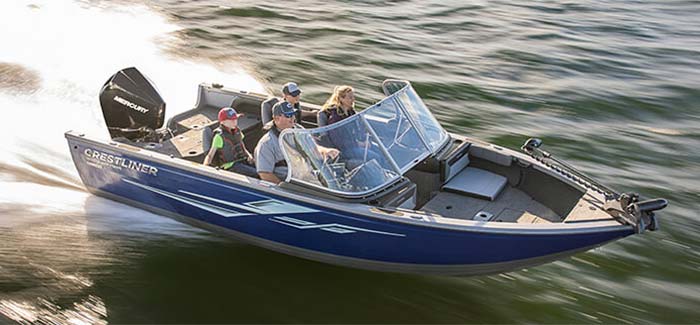
Fish 'n Ski Boat
Fish 'n Ski boats are used for fishing or skiing. These are family boats. They have accessories for each application. They feature comfortable seating and offer livewells and tie downs for rods and have removable, elevated tow bars and ski lockers. They are usually 16–24 feet in length.
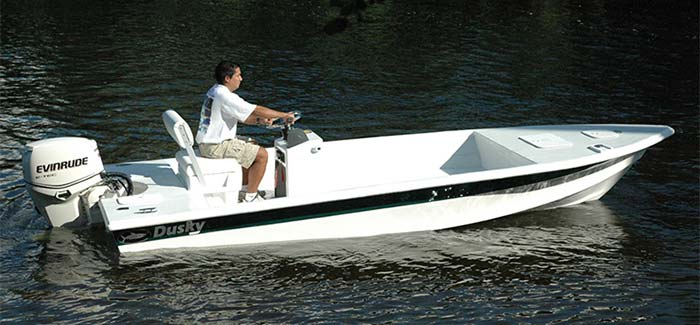
Flats Boats range from 14 feet to 18 feet and are specifically designed to navigate shallow waters needing extremely shallow drafts. A push pole is used to navigate the shallow water.
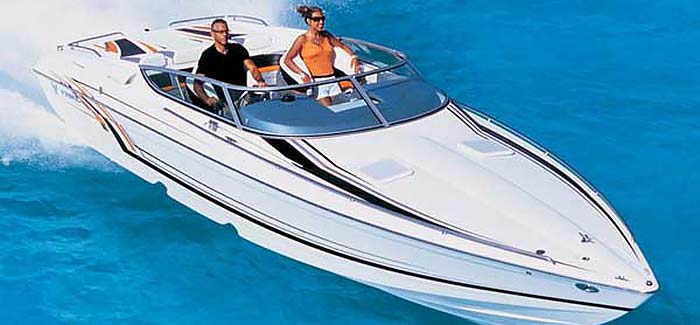
High Performance Boat
Performance powerboats are built for speed, featuring narrow beam, steep deadrise, and high power to weight ratios. They have Spartan cabins. Cockpits seat 2–6 passengers. Powered by high horsepower outboards, stern drives or surface drives, these boats are carefully designed to be fast, light and strong, ideal for racing or fast cruising. They range from 25–60 feet in length.
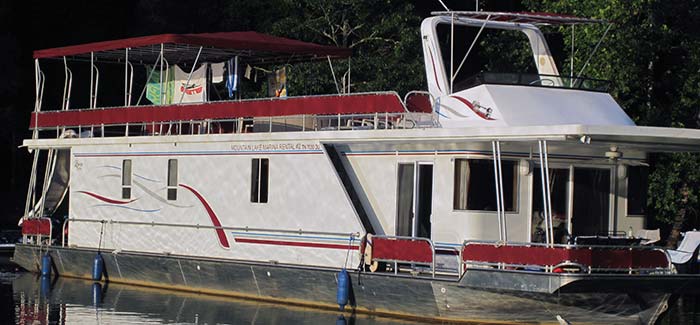
As the name implies houseboats are floating houses. They are either outboard or inboard propelled and range from 25 to 150 feet in length. Just like a house they have full kitchens, bedrooms and living and dining areas. They are the ultimate family boat. They are generally found on quieter bodies of water since they have low freeboards and are built on a barge-like hull.
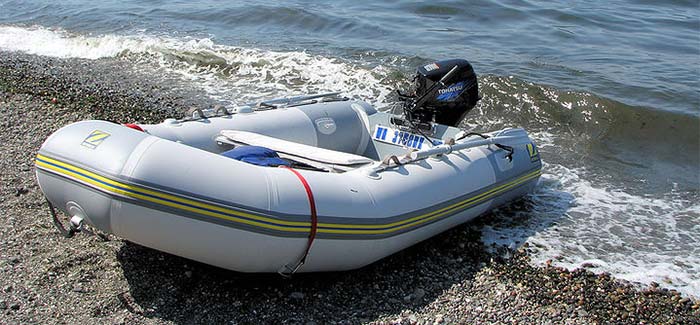
Inflatable Boat
Usually 6'–14' in length and have inflatable tubes for their sides. The floor is flexible or made rigid using plywood or aluminum floorboards depending on the size. Outboard motors can be used on the rigid transom. They deflate and are easy to transport or store. Used as dinghies on larger boats. A good choice for those new to boating.
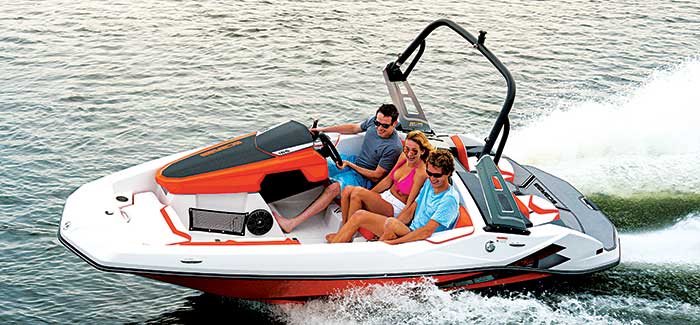
Jet Boats have single or multiple jet drives instead of a propeller for propulsion. They are very maneuverable. These smaller boats (14–24 feet) are generally used for water sports and getting into shallow waters.
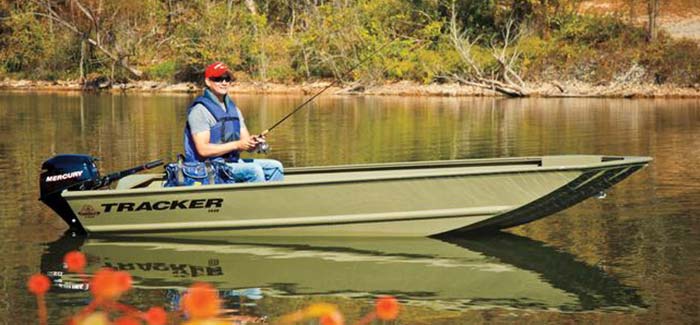
Jon boats are small utility craft primarily used for boating in shallow water. They range from 10 to 18 feet in length. They can be made of aluminum or fiberglass. They are inexpensive and a good choice for the novice boater.
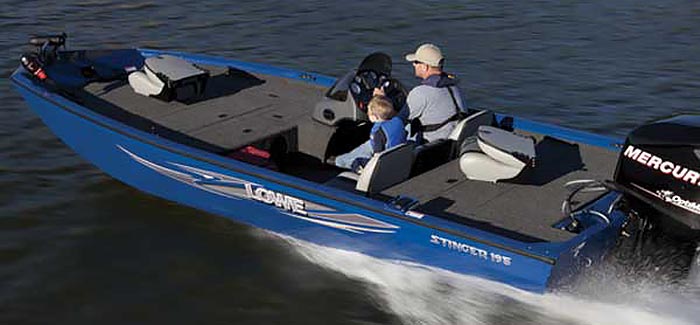
Multi-species Boat
Multi-species boats are 17–23 feet in length. They are made of fiberglass or aluminum. They are designed to travel in rougher water than bass boats. As the name implies, these boats are made for fishing a variety of different fish in all types of water.
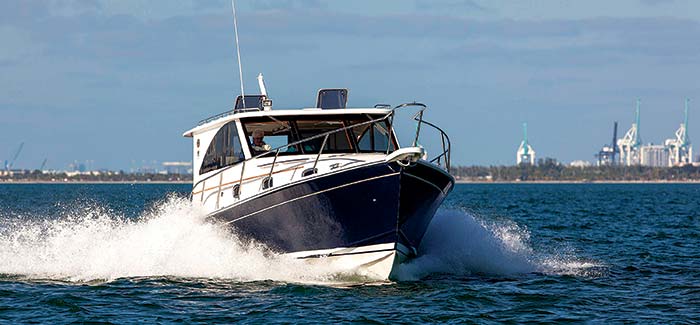
Pilothouse Boat
Featuring a fully enclosed pilot house, these boats are built to ride rougher seas while keeping helmsman high and dry. They are powered by outboards, stern drives or inboards. They are popular for cruising and many types of fishing. They usually have a berth and a head. They are usually 20–35 feet in length.
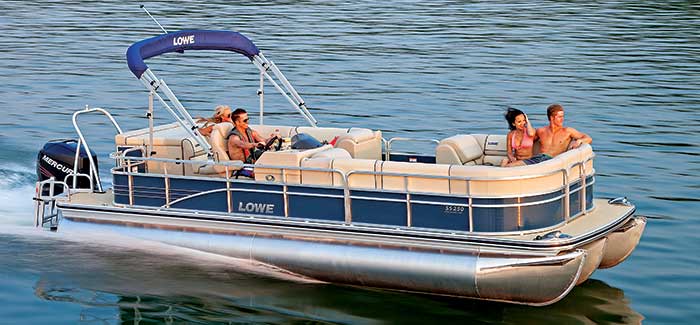
Pontoon Boat
Pontoon boats have 2 or 3 aluminum tubes that support a broad platform. They have shallow drafts and are very stable. They are usually found on inland lakes and rivers and other small bodies of water. Used for cruising, fishing and water sports. Powered by an outboard or stern-drive. Lengths from 15–30 feet.
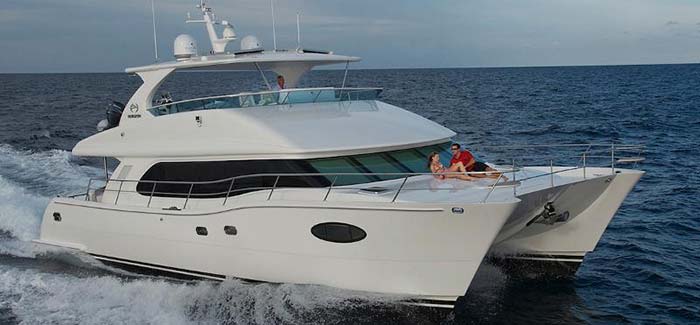
Power Catamaran
These dual-hull boats are generally used for offshore fishing. They are more rugged, provide a more stable ride, faster speeds and better fuel economy than mono-hulls. They are 25–40 feet in length.
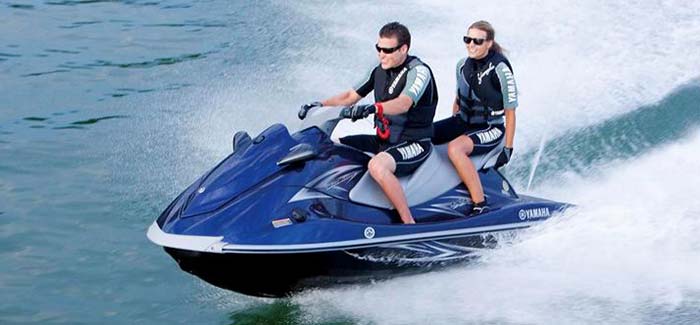
PWC (Personal Watercraft)
Entry level boats that are fun to drive and economical to buy. They come in lengths from 9–14 feet. They are usually built for 1 or 2 people but larger, more powerful models can seat up to 4. They are powered by jet drive.
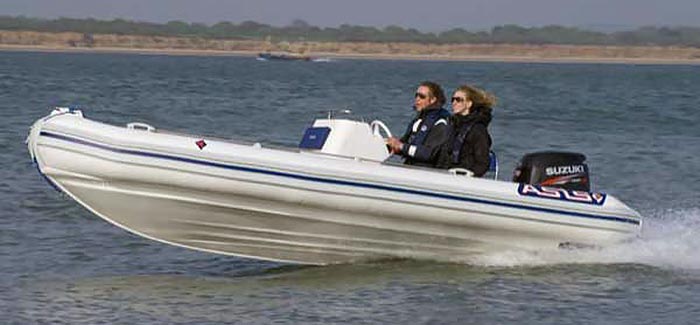
Rigid Inflatable
RIBs (rigid inflatable boat)s have a fiberglass or aluminum hull attached to inflatable outer tubes. Outboard motors are used on the transom for power. RIBs are usually faster, larger, and can carry more weight than flexible floored inflatables. They also come in larger sizes.
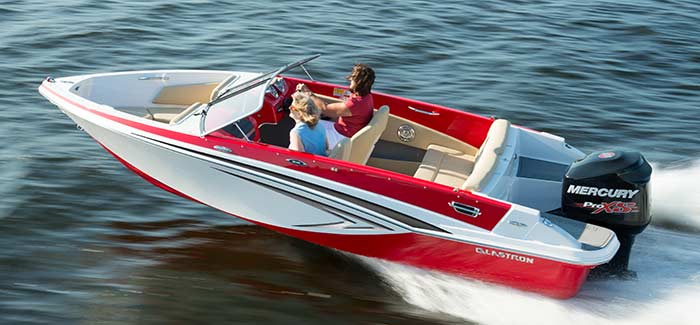
Many boats are called runabouts. Generally a runabout is defined as a small powerboat somewhere in the 14–24 foot range. They are usually powered by an outboard or stern-drive engine. They are a multipurpose boat suitable for water sports, cruising and fishing.
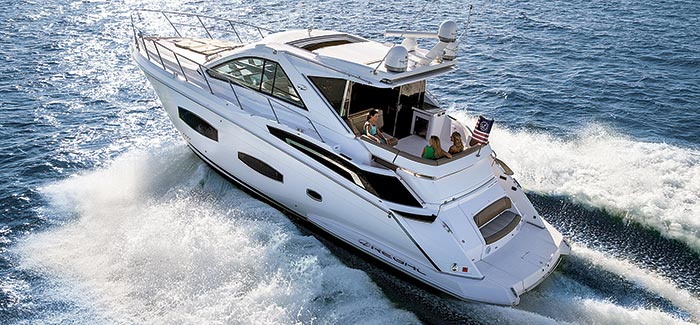
Sedan Bridge Boat
Intended for extended cruising with accommodations down below to suit long stays on the water. They range from about 35–65 feet. The bridge positions the helmsman high above the water allowing for great visibility.
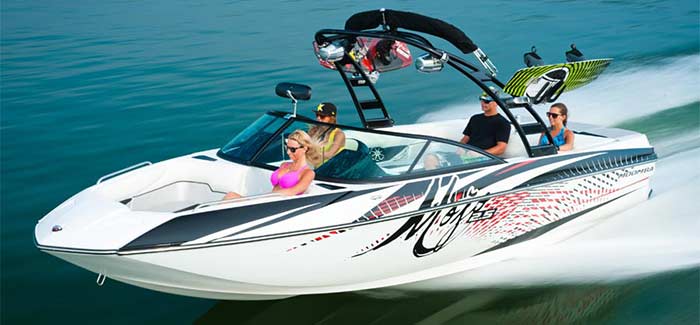
Ski and Wakeboard Boat
These boats are designed specifically for water sports. They can be ballasted for producing higher wakes for trick skiing and waterboarding. They are also great for pulling inflatable tubes.
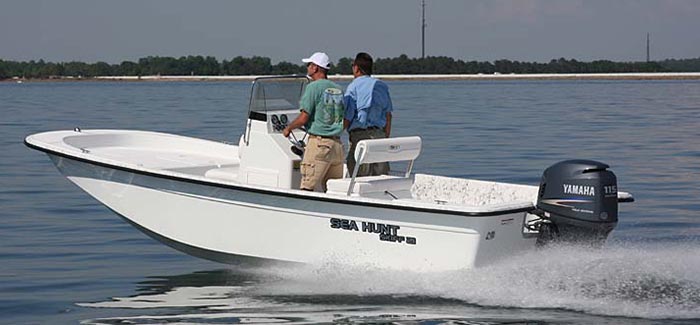
The skiff is similar to a Jon boat. They are another entry level boat. They are especially good for boating in shallow water. The can have flat or cathedral shaped hulls. Many have a console to steer from.
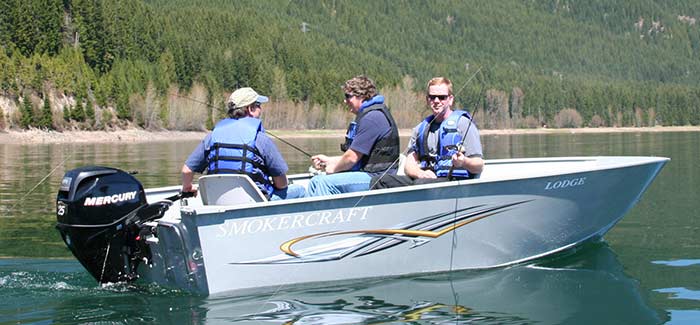
Utility Boat
Utility boats are made for tough use. Generally made of aluminum with outboard power and range from 12–20 feet. Used for fishing or as workboats. Relatively low cost to maintain and a good choice for the novice boater.
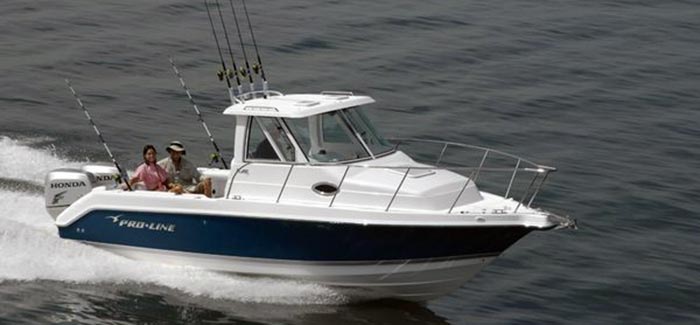
Walkarounds
Walkarounds allow an angler to walk around the cabin. They are generally 20–30 feet in length. They are usually found on larger bodies of water and can be powered by an outboard, Inboard/outboard or inboard engine.
Related Articles
The truth about ceramic coatings for boats.
Our editor investigates the marketing claims of consumer-grade ceramic coatings.
Fine-Tune Your Side Scan Fishfinder
Take your side-scanning fishfinder off auto mode, and you’ll be spotting your prey from afar in no time
DIY Boat Foam Decking
Closed-cell foam flooring helps make boating more comfortable. Here’s how to install it on your vessel
Click to explore related articles
BoatUS Editors
Contributor, BoatUS Magazine
Award-winning BoatUS Magazine is the official publication of Boat Owners Association of The United States. The magazine provides boating skills, DIY maintenance, safety, news and more from top experts.
BoatUS Magazine Is A Benefit Of BoatUS Membership
Membership Benefits Include:
Subscription to the print version of BoatUS Magazine
4% back on purchases from West Marine stores or online at WestMarine.com
Discounts on fuel, transient slips, repairs and more at over 1,200 businesses
Deals on cruises, charters, car rentals, hotel stays and more…
All for only $25/year!
We use cookies to enhance your visit to our website and to improve your experience. By continuing to use our website, you’re agreeing to our cookie policy.

Motor Boat Types Explained: How to Find the Right One for You
- Latest Posts
Do you dream of owning a motorboat? Motorboats are great for fishing, water sports, adventure, and fun. They are also referred to as speedboats and powerboats and come in different shapes and sizes. There are different types of motorboats today. This article has all the different motor boat types explained as well as their advantages and disadvantages. Read on to find your dream motorboat.
Types of Motor Boats
Bowrider motor boats.
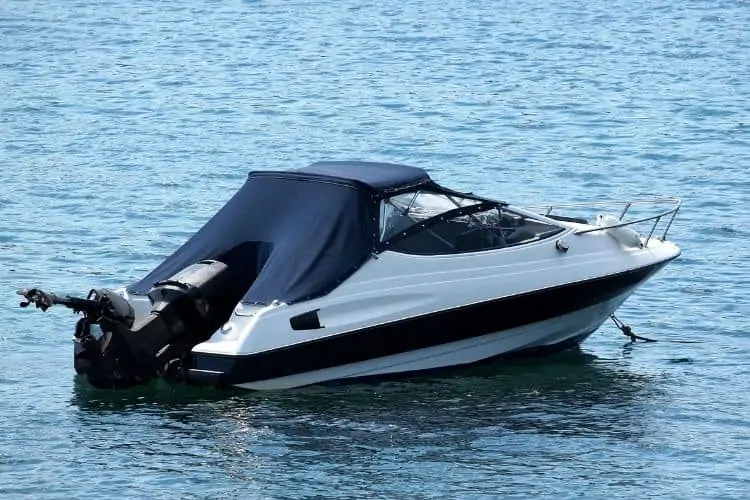
Bowriders are a perfect choice for beginners and those with family. The open bow area makes room for extra seats in the helm and can hold more than 8 passengers. The boat is about 17-30 inches in length. The V-shaped hull offers smooth rides, whether on inland waters or coastal waters.
The boat can be powered by outboard engines or stern drive and can be used for water sports or fishing.
- Bowriders can be used for water sports, entertaining, fishing, and entertainment.
- It can fit up to 9 passengers.
- It can be powered by a sterndrive, jet propulsion, inboard, or outboard engines.
- The motorboat looks crammed with maximum passengers on board.
Cabin Cruisers

Powerboats that have sleeping accommodations onboard are referred to as cabin cruisers. They are ideal for relaxed cruises as they include modern comforts like air conditioners, heaters, and power generators.
These cruiser boats have a deep V-bottom, shaft drive mechanism, and rudder steering. The cruiser is mainly used on salty, coastal waters and can be propelled with pod drive, sterndrive, outboard, and inboard motors.
- The motorboat is great for day and night cruising.
- It has a seating capacity of 10 people.
- The cruiser offers luxury and accommodation.
- They are expensive to buy and maintain.
Center Console Powerboats
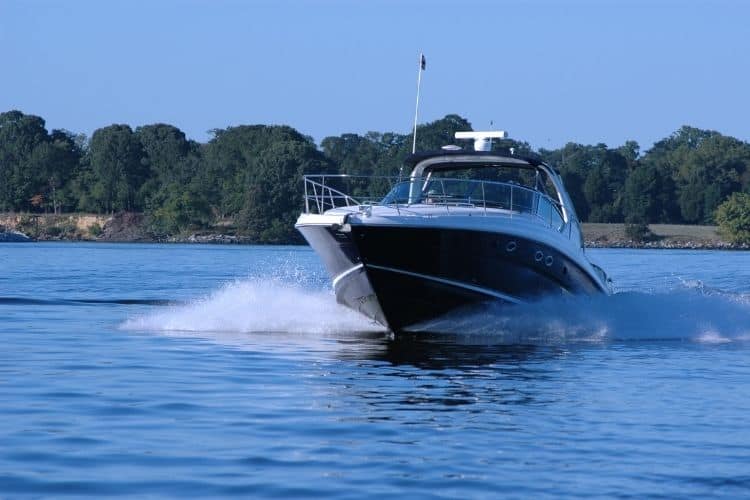
The center console gets its name from the fact that the helm is fitted in the console found at the boat’s center. It lacks a foredeck and cabin. The motor boat’s design makes it possible for anglers to walk from the bow to the stern without stepping on the gunwales. This 13-45’’ boat uses outboard motors to cruise.
Center consoles are great for sports fishing. They work perfectly in harsh offshore waterways where there are plenty of schools of fish. The deck in center consoles has powerful insulation to ice the fish storage. Also, the boat can hold fish lockers, outriggers, gunwale rod holders, and bait wells.
- Center consoles can be used for fresh and saltwater fishing, cruising, and water sports.
- They have better access to water.
- They are easy to maintain.
- It lacks protection from the elements.
Convertible Motor Boats
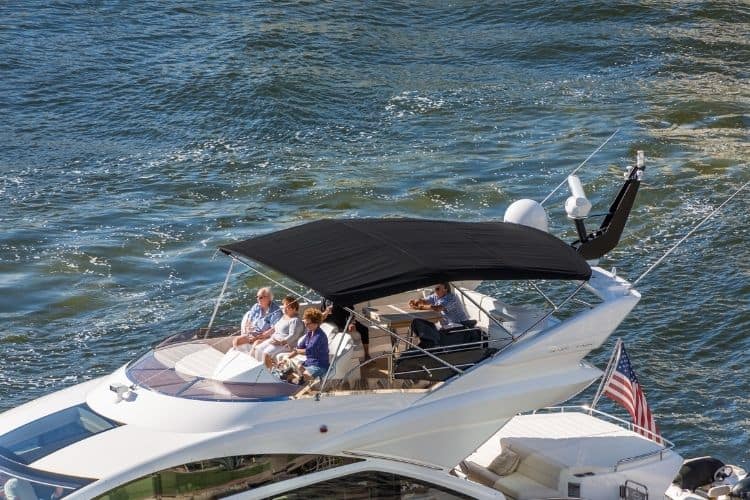
Convertible motor boats are great for fishing and weekend cruising. This large-sized boat has a large cabin, a flybridge for running the boat, an entertaining area for passengers, and an advantage point for spotting fish grounds.
- They have large cabins.
- The height of the flybridge elevates the captain to spot fish-grounds easily.
- They are ideal for offshore fishing.
- They are easily accessible, like express fishing boats.
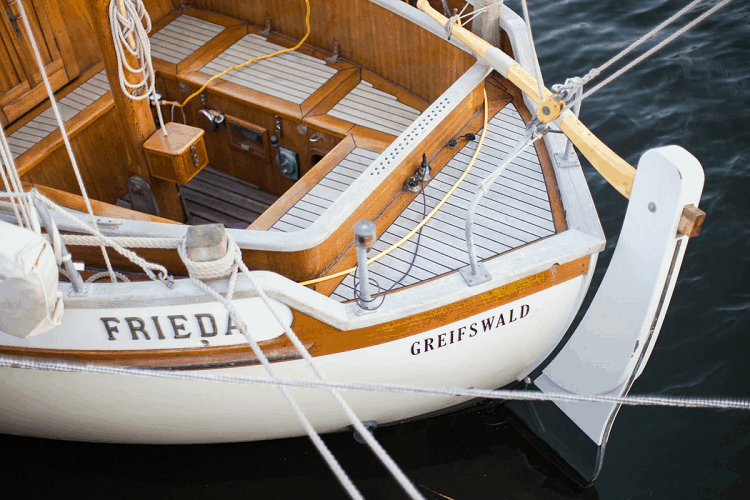
Deck boats are 25-35 ft. long and are mainly made of fiberglass or aluminum. They have better performance and space compared to pontoon boats since they have a V-shaped hull. The open deck available on the boat provides plenty of seating space for passengers. They, however, have no space for accommodation below the deck.
Deck boats are either powered by stern drive, jet drive, or outboard engines. The boat is mainly used for recreation activities such as water sports and swimming.
- They are perfect for families and parties.
- They have more capabilities and amenities than bowriders.
- They can hold up to 14 people.
- They are not fast.
- They are less spacious compared to pontoons.
Bowrider Boats

This boat is also called a quintessential family boat. They have spacious rooms for more than eight passengers on the cockpit, helm, and bow cockpit. These boats also offer comfort and leisure through the swim platform.
Bowriders have a V-shaped bottom that can cruise through different weather conditions. Although the bowrider offers splendid rides using the sterndrive power, the demand to use outboard engines is on demand.
- They are versatile and can be used for fishing, watersports, and entertaining.
- Bowriders are affordable.
- Passengers can sit in the front and back.
- They are easy to drive.
- It is not great for overnight cruising.
- It has narrow and cramped seating at the front.
Dinghy Boats
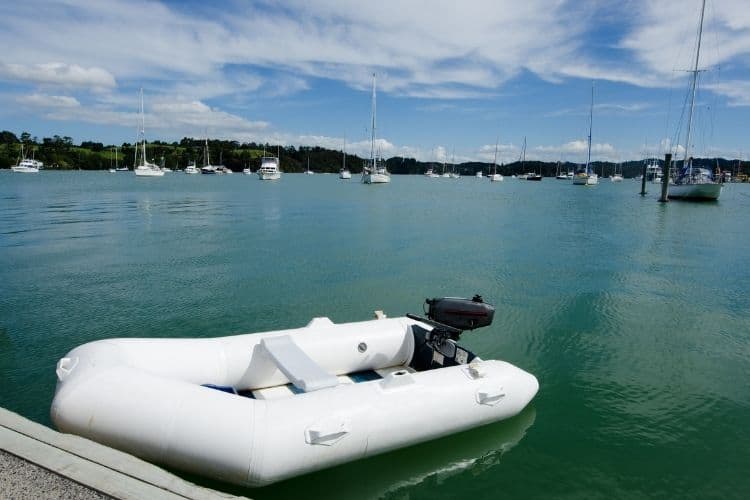
Dinghy boats can be hard-sided or inflatable. Although oars and sails powered them in the past, dinghy boars are now powered by small outboard motors.
They are often used for transporting passengers and their personal effects to and from shore when a mothership cannot get onshore. The motorboats are also used for camping expeditions and fishing.
- Inflatable dinghy boats are easy to store.
- They are extremely lightweight.
- They are stable and durable.
- Soft inflatable dinghy boats can flip you in water on impact.
Express Cruiser Boats
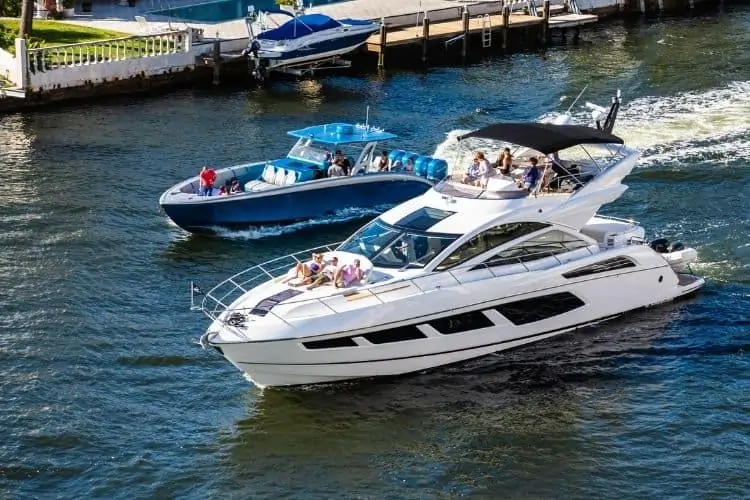
Express boats have large cockpits where guests get entertained both indoors and outdoors. The helm is slightly elevated and tucked up by the boat’s windscreen. Besides, these 30-50-foot-long cruisers have more outdoor space and multiple cabins.
In terms of cruising, these motorboats can achieve speeds of 25-30 knots. They can be powered by pod drives, stern drives, or twin engines.
- Express cruiser boats are great for sightseeing.
- They have more outdoor space.
- They have fast speeds.
- They consume a lot of fuel.
- They are pricey.
High-Performance Motor Boats
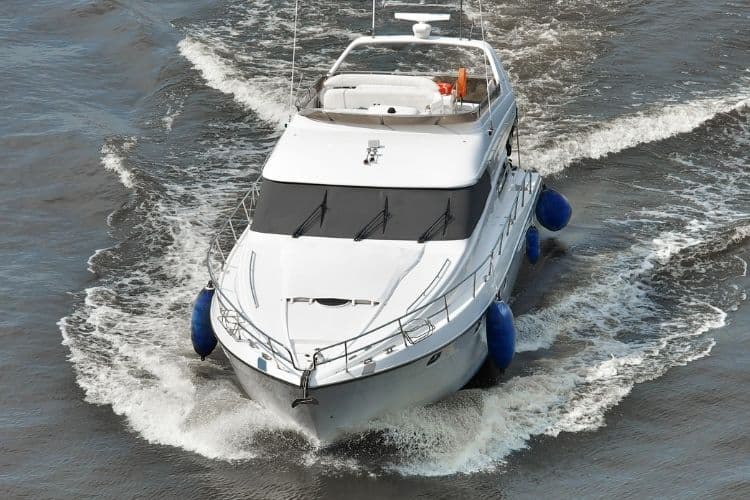
As the name suggests, these motorboats are designed for speed and performance. Their high power to weight ratio, steep deadrise, and narrow beam help the boat perform on the water. High-performance boats are also referred to as go-fast boats and muscle boats.
These go-fast motorboats are powered by stern drives, high horsepower outboards, or surface drives. With 25-60 ft. length, these boats are light, strong, fast, and ideal for fast cruising.
- They can hold up to 6 passengers in the cockpit.
- They are built for racing.
- They are expensive
Personal Watercraft Boat

Personal watercraft are designed for fun, pleasure, and adventure. These boats are also referred to as jet skis and water scooters. With them, one can explore the waters or engage in water sports. Personal watercraft are either sit-downs or stand-ups. Sit-down s can hold two or more passengers, while stand-ups can only hold one rider.
- They are smaller and easier to maneuver
- They are perfect for water sports and adventure.
- Servicing them is easy, and they are more stable on the water.
- You need safety gear when riding a personal watercraft powerboat.

Houseboats are also known as floating houses as they have dining areas, bedrooms, and kitchens. These boats are ideal for families, entertaining, recreation, cruising, or enjoying water sports. They come in different shapes and sizes and mostly measure 25 ft. in length to 150 ft.
Houseboats have broad flooring and modern amenities to offer luxury. These boats are motorized and are incapable of working on their power.
- Houseboats can also be used as living houses.
- You have vacation activities throughout the year.
- Fishing takes place anytime.
- If you live on a houseboat, you have to join the homeowner’s association.
Inflatable Boats
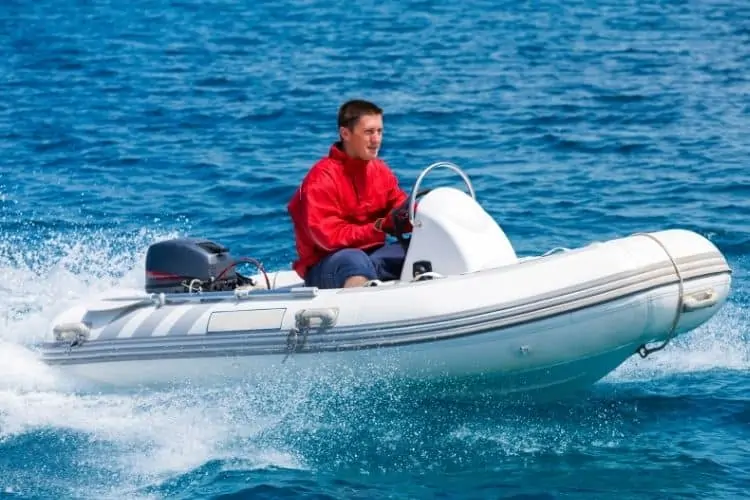
These boats have inflatable tubes on the sides for fast and easy inflation and deflation. They also have flexible or rigid floors, depending on their size. Measuring 6-14’’, inflatable boats are ideal for beginners.
The common motors used in inflatables are outboard motors as they can be mounted on the rigid transom.
- They are lightweight when deflated, making them easy to transport.
- They are good for beginners.
- They are not as stable as other powerboats.
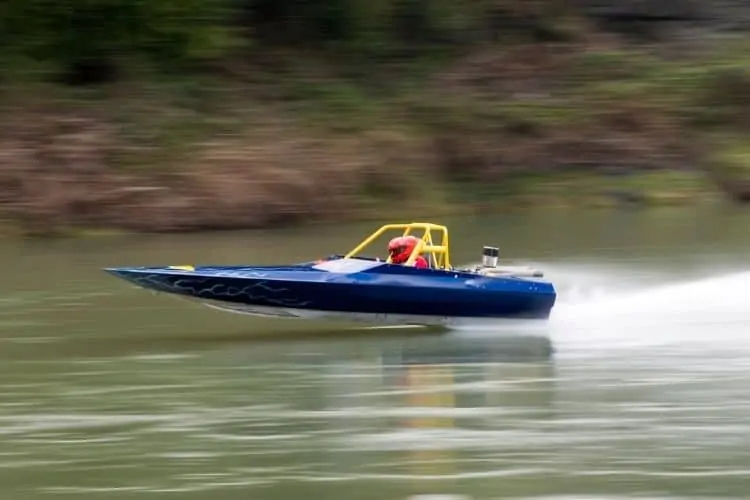
These are run by single or several jet drives. They are mostly used in shallow waters and water sports because of their small size. Jet boats are highly maneuverable too.
- It has quick turning capability and acceleration.
- They can achieve top speeds.
- They lack an exterior propeller.
Pilothouse Boats
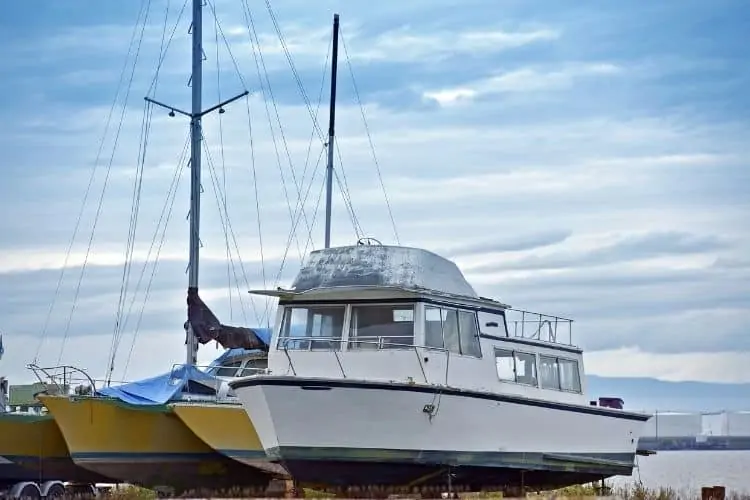
Designed to ride rougher seas, the pilothouse boats are fully enclosed to keep the helmsman dry. They are great for cruising and fishing. These boats have a berth and head and are 20-35 ft. in length.
The pilothouse boats can be powered by inboards, outboards, and stern drives.
- The helmsman stays high and dry even in rough sea conditions.
- It has reduced wind and engine noise.
- Mounting accessories on a pilothouse motorboat is easy.
- It can be hot and stuffy if the boat does not have an air-conditioner.
Pontoon Boats
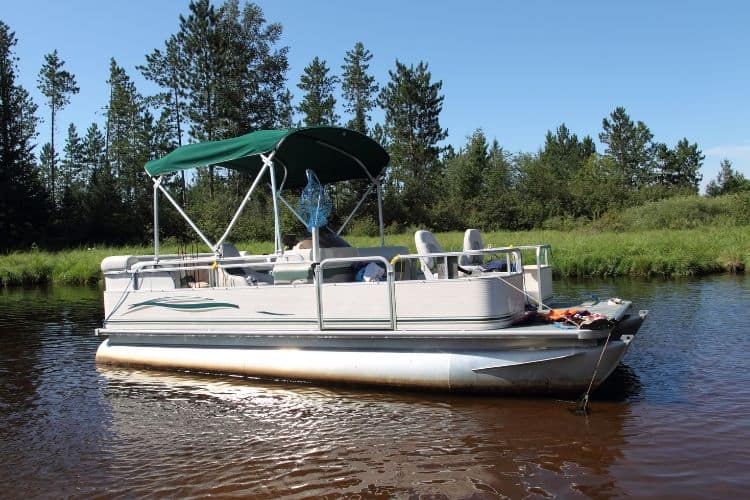
Mainly used in small water bodies, rivers, and inland lakes, pontoon boats are ideal for water sports, fishing, and cruising. They are available in 15-30 ft. length, have shallow drafts, and are highly stable. They also support a broad platform with the multiple aluminum pontoons fitted. These boats have flat decks and a fence for tour groups.
Sterndrives or outboard motors often power pontoon boats.
- They are comfortable and have great speeds.
- They can be used for fishing and water sports.
- They offer safety.
- They are not ideal for rough waters.
Power Catamaran

Power catamarans are dual hull boats that offshore fishers mainly use. Not only are they rugged, but they also offer stable rides. Furthermore, they can achieve fast speeds and consume less fuel compared to mono-hulls. They also have higher displacement, less hull volume, and shallow drafts.
Power catamaran boats have lengths of 25-40 ft. They are excellent for leisure and fishing. These boats use sails and engines, making them a crossover powerboat.
- They have more space than monohulls.
- They are more stable on waves.
- Dual hulls are faster than monohulls.
- They are more expensive than yachts.
Cuddy Cabins
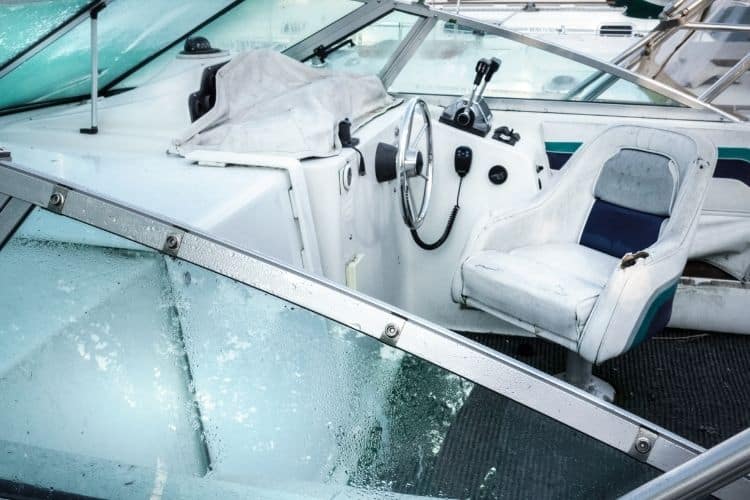
Cuddy cabin is a family-friendly powerboat. It can be used for sailing, fishing, leisure, and yachting. With a closed deck on the boat’s bow, the cuddy cabin is easy to navigate and has ample storage space. In terms of materials used, these boats are usually made of aluminum and fiberglass with a length of not less than 475 meters.
- They provide a dynamic cruising experience.
- They are trailer-able and can cruise different waters.
- They have sleeping space for day naps and nights.
- Bow access is limited.
Runabout Motor Boats
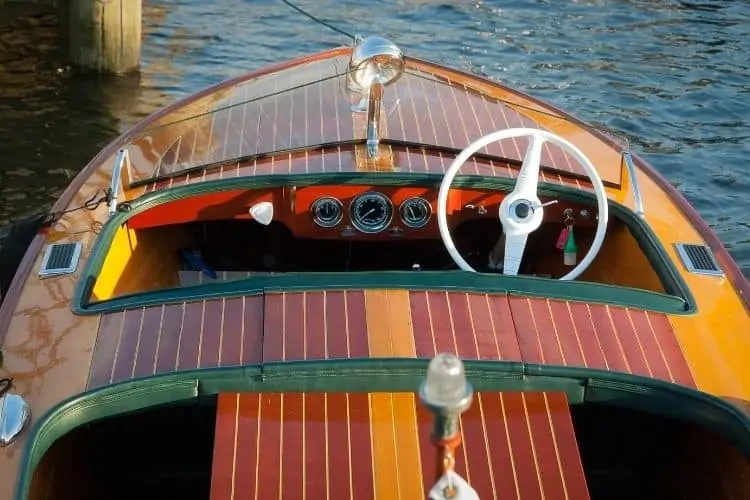
Small motorboats between 14-24 ft. in length are known as runabouts. They can be used for water sports, cruising, or fishing; runabouts can be powered by a sterndrive engine or an outboard motor. The open boat has a steering wheel behind a windscreen as well as forward controls.
Runabout motorboats can accommodate up to eight people.
- They are inexpensive.
- They are low-maintenance.
- Runabout speedboats are versatile.
- They have limited fuel capacity, thus limiting the travel range.
Utility Boats

Designed for tough use, utility boats are mainly powered by outboard motors. They are generally made of aluminum or fiberglass and are 12-20 ft. The boats can either be used as workboats or fishing vessels.
- They are ideal for novice boaters
- They are inexpensive to maintain.
- Aluminum utility boats are noisy at high speeds.
Walkarounds

These boats have side decks to provide room for anglers to move up the foredeck and around the cabin. Found in large water bodies, walkarounds measure 20-30 ft. in length. Walkarounds can use inboard engines, outboard motors, or both.
- There is plenty of room to walk around.
- They are fuel-efficient.
- They are heavy to trail around.
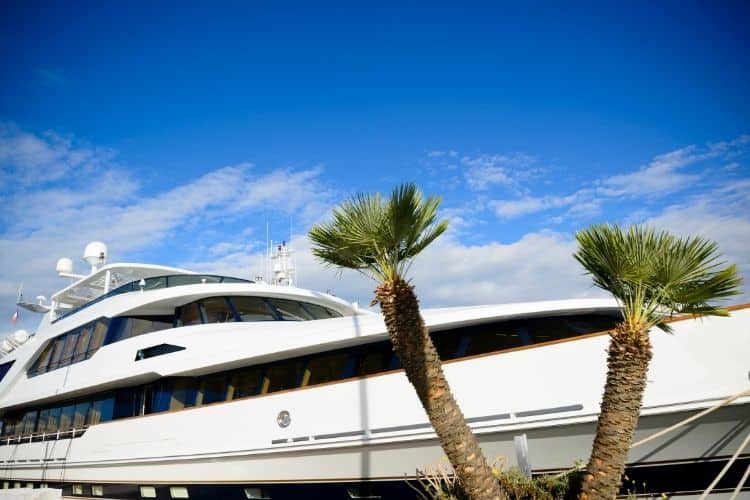
Yachts between 100-200 ft. long are known as superyachts. These motorboats have multiple decks, accommodations, a galley, lounges, and a living room. These boats are mainly used to host and entertain guests.
- It can cruise deep waters.
- They have recreational recreation.
- They are costly to maintain.

Any yacht with over 200 ft. length and up to 500 ft. height is referred to as a mega yacht. Most are custom-made and owned by the wealthy class. They feature state-of-art luxuries like a helipad, large swimming pools, plenty of guest rooms, and a crew of not less than 25 people. Ideally, they can be referred to as luxurious floating resorts.
- They offer affordable recreation and quality time for passengers.
- They can cruise in deep waters.
- Mega Yachts are only usable in warm seasons.
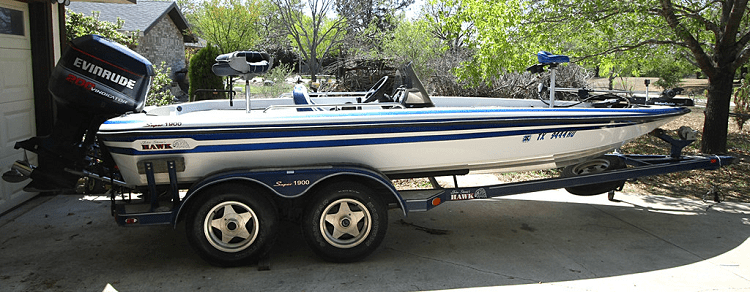
Bass boats measure 14-23 inches and are mainly used for freshwater fishing in rivers and inland lakes. Their design features a V-hull, flat deck, shallow draft, and low freeboard. They are fitted with special gear, trolling motors, and high horsepower outboards.
- They make good fishing vessels since the trolling motor operates quietly.
- They offer the freedom to fish in different waters.
- They have great casting platforms.
- They are slow.
- They have limited seating.
Although they have a low profile, bay boats are great for shallow waters near the shore or coastal waters. Their length measures 18-24 inches. They are made of fiberglass, which makes them durable when used in brackish and saltwater. Compared with flatboats, bay boats have more free boards.
- The low-slung gunwales make it easy to swing fish into the boat.
- They are great for fishing in very shallow waters.
- They come with basic fishing features.
- They can only hold three people.
Sedan Bridge
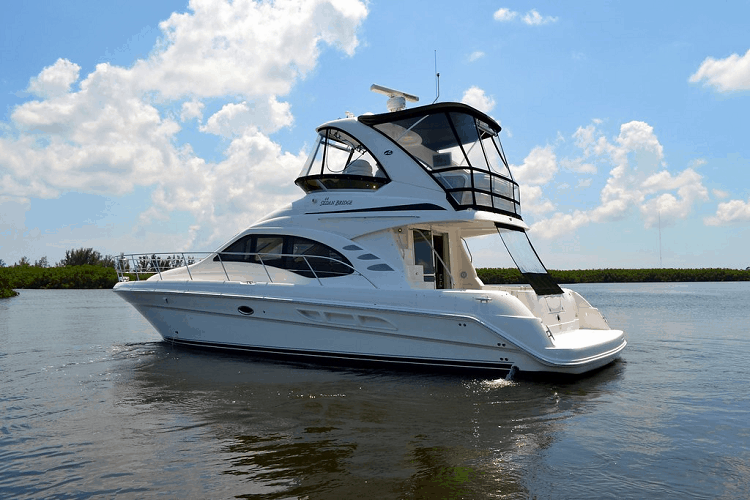
A sedan bridge is typically 35-65 feet long and offers the captain or navigator excellent visibility. What’s more, the cockpit level in a Sedan bridge is close to that of the boat’s aft deck. For this reason, this powerboat does not need a ladder or stairs. Access to the cockpit is relatively easy on the Sedan Bridge.
- It has plenty of room in the salon.
- They are easier to operate, clean, and wax.
- Not perfect for rough waters.
Other types of powerboats include;
With a pointed bow and flat bottom, skiffs are perfect for navigating shallow waters. They come in different lengths and sizes. It is easy to operate a skiff using a basic steering console.
Game boats are useful in game fish pursuits such as tuna and marlin and use diesel or petrol engines. These boats are large in size and made of fiberglass. They are also equipped with cooking galleys, plumbing systems, and sleeping berths.
Motor Yacht Boats
These are primarily leisure boats. The standard length of one is 12m and above and can hold 1-2 diesel engines. They are great for both short and long family trips.
Wakeboards/ Ski Boats
Although they look alike, wakeboards and ski boats have variations in terms of actions. Inboard ski boats need powerful acceleration. The shape of the propeller and engine also brings out noticeable differences.
On the other hand, inboard wakeboards have a V-drive engine system, huge wake, and deep hulls to get the boat in motion.
Factors to Consider When Choosing a Motor Boat
With over 30 motorboats to choose from, how can you find the perfect type for you? Below are factors you need to keep in mind before making the decision.
New or Preowned Motor Boat?
This should be one of the factors to consider when thinking about buying a boat. New boats are the best choice if you have saved for the purchase or money is not a problem. One advantage of buying a new boat is they have a warranty, so the repairs are covered in case of a malfunction.
What if you do not have enough money to get a new motorboat? Get a pre-owned one. However, ensure that it is thoroughly checked by a motorboat professional.
Reason and Frequency of Using the Motor Boat
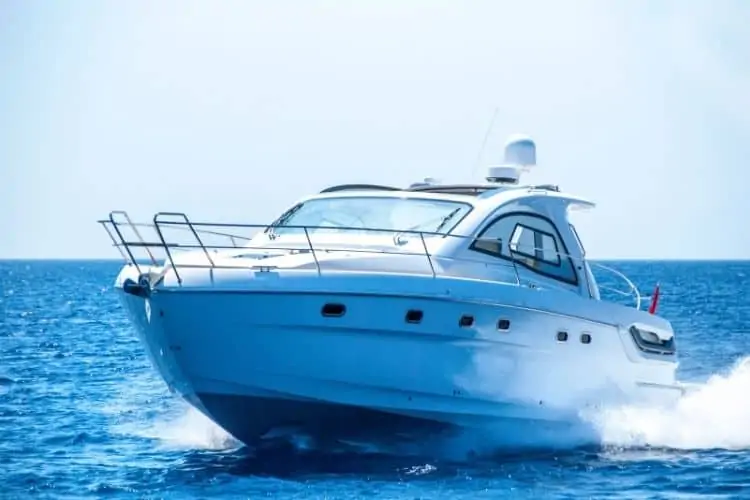
When choosing a motorboat, understand the reason why you need the boat. Is it for fishing? Will it be one of your entertainment assets? Or will it serve as a sailing boat or for family trips? Once you discern why you need the boat, you will make the right choice when choosing the motorboat.
After knowing what the boat will be used for, determine how often you will need it. Why? If the boat is for fishing, you need to understand how long the fishing seasons in your area last. What if the boat is for family trips? You need to tell when the weather is great for outdoor sports and when schools take a break so you can take the kids for a vacation.
Motorboats depreciate fast in the first year of purchase. If you discover that you will only take the boat on the water once every few months, the best decision is to wait. By doing so, you will save yourself the agony of depreciation and maintenance fees.
Thinking about the reason and frequency of using the boat beforehand will help you maximize your investment.
Motor Boat Use
If you are getting confused looking at different motorboats, here are a few questions to reflect on and help you make the decision.
- Are you looking to impress guests and business associates?
- Do you want a motorboat that fits on a trailer?
- Are you looking for a boat that can hold your family?
- Is the boat for water sports?
- Do you have experience in motorboating?
- Are you looking for a multi-purpose boat?
- Do you need help operating the powerboat?
- How much boat loan payment can you afford monthly?
Finding answers to the above questions will help you minimize your options.
Your Location
Before buying a speedboat, consider whether you have access to a water body. If you do have access to a body of water, confirm whether the waterways are appropriate with the use and type of boat you want. For example, if you buy a motorboat for fishing and live close to a lake, check whether fishing is allowed on the lake.
The location also plays an important role in terms of storage. Are there slip options and marinas in your area? Are boats allowed on the streets by the homeowner’s association? Considering these options before purchase will help you find the best storage options when you buy the motorboat.
Type of Motor Boat
As previously stated, there are plenty of types of motorboats. Nevertheless, they all will not match your user needs. For starters, consider the size of the boat. How many people are you planning to have onboard?
Do you need space for fishing gear? Does your boat require sleeping accommodations? These factors will determine the size of the powerboat you need.
Besides, take into consideration the condition of the motorboat. For pre-owned motorboats, consider whether they will meet both your short and long-term goals. Moreover, calculate how much you will spend on maintenance as old boats need more repairs.
Type of Hull
There are three main types of powerboat hulls; displacement hulls, planing hulls, and semi-displacement hulls.
Displacement hulls are found in heavy vessels such as tugs and trawlers. They are fuel-efficient and can navigate through rough seas. Unfortunately, they are not fast, making them ideal for long distances.
Planing hulls, on the other hand, skim over the water at high speeds. Made of lightweight materials, planing hulls are powered by powerful engines. They, however, have high costs of maintenance and fuel consumption.
Semi-displacement hulls offer both speed and functionality. Although they are not as fast as planing hulls, they achieve reasonable speeds and cruise through rugged seas. Many boat builders and designers prefer semi-displacement motorboats.
Storage also plays a role when choosing the type of speedboat. Some motorboats can fit on trailers and others in a storage unit area. Keep in mind that the bigger the boat, the larger the storage space, trailer, and towing truck. Huge boats may force you to get permits and hire professionals when moving.
Also, pay attention to storage costs during winter or when you are not using the motorboat.
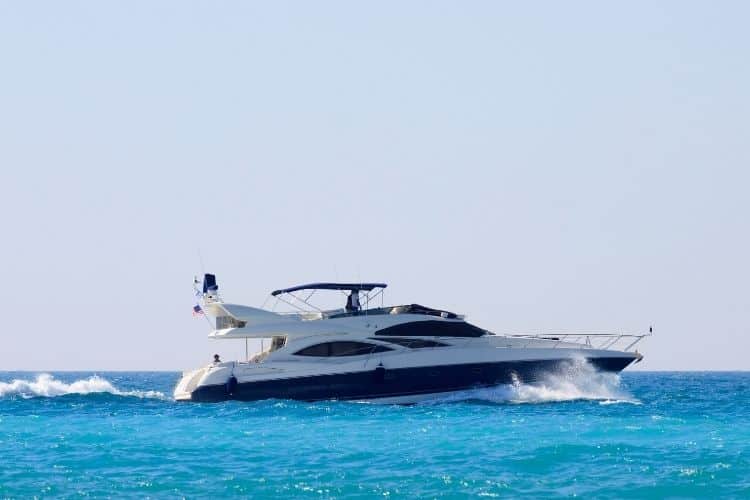
How much will the motorboat cost you? By cost, consider the upfront cost of buying the boat, maintenance, storage fees, gear, fuel, accessories, trailers, and hitches. Besides, you need to set money aside for boat insurance.
Boat insurance covers physical damage on the motorboat, loss, and damage of personal effects on the boat and injuries in the event of a boating collision. Talk to your insurer before purchase to get a quote on expected insurance costs.
On the other hand, if you are not looking to pay upfront, you can look into historic lows. Today, there are plenty of marine lenders who can finance your boat loan for 10 to 20 years. Before choosing a marine lender, determine carefully whether your cash flow can sustain that long-term loan.
Legal System
Different states have different regulations. For example, some states require boat operators to own an operator’s card to prove their competence. Therefore, check what the laws require of you as a boat owner before the purchase.
The same applies to buying a pre-owned motor; ensure the seller transfers the motor boat’s ownership under your name. What if the seller cannot find proof of ownership? Ensure you get a declaration under oath from them about why they do not have proof of ownership.
You must have browsed through different boat brands when looking for a motorboat. Good thing, most motorboat brands have boat owners clubs where you can get crucial information about boats. Here, you can ask questions and tips about the brand before the purchase.
Besides, it is much cheaper to make an online purchase. However, if you have not made the final decision yet, attend a boat show to view and access the different models and brands available. Talk to experts and ask their opinions based on your intent on the motorboat.
You must ensure that a motorboat is seaworthy, especially pre-owned boats. Walk around the boat and access the vessel. Next, take the motorboat for a sea trial and gauge whether there are any problems.
If you are inexperienced in boating, a shiny, clean motorboat may blind you. Therefore, hire a professional marine surveyor as you may miss some important issues. Once you are done with the sea trial, haul the motorboat out of water for the surveyor to inspect the parts under the waterline. Inspecting the powerboat before the purchase will save you from making a wrong financial investment.
Whether buying a new or used boat, find out what else is included in the purchase. Have the seller provide you with a list of equipment included in the sale. You can then choose to take the whole package or shop the amenities on your own.
Question: Can I purchase a boat without qualifications?
Answer: Yes. Owning a private motorboat does not necessarily mean you need qualifications. However, there are advantages to having one.
Question: Which are the best motor boats for beginners?
Answer: Dinghies, bowriders, and pontoon boats are some of the best motor boats for beginners. They have simple propulsion systems and are more flexible.
Question: Should I buy a new or pre-owned motorboat?
Answer: Buying a new motorboat is the wisest decision because you get exactly what you are looking for. Sadly, new motorboats are expensive compared to pre-owned boats. Buying a used boat will save you money, and if not inspected thoroughly, you may find yourself with a lemon.
Question: What do I need to know about motorboat coverage?
Answer: Some small motorboats are covered on a homeowner’s policy, while large motorboats require a separate insurance policy. Also, boat insurance offers limited coverage on your personal effects.
Since there are numerous types of motorboats in the market, you find the ideal choice for you. Pick that motorboat that fits your needs, family, speed, and budget.
Personal watercraft are perfect for 1-2 riders, while cuddy cabins are family-friendly. In terms of entertaining guests, express cruiser boats, superyachts, and Megayachts are the real deal.
Take your time going through the different types of powerboats, ask expert opinions, and make an informed investment for your money.
Types of Powerboats
28 motorboat types – from aft-cabin to walkaround.
If you’ve been browsing our listings for new and used boats , you likely have questions about sizes, styles, makes and models. Because the powerboat market is constantly changing, many categories of powerboats can share characteristics with another type of boat or yacht.
As Western Canada’s yachting experts , we can help make sense of it all.
Whether you need a new dinghy/tender for your yacht, are looking for your very first boat, or would like to upgrade from a cruiser to a luxury model by Pursuit , read on to choose the right boat for your needs.
Powerboat Types
Aft-Cabin : The aft-cabin boat has a stateroom on the stern of the boat. This type of boat has a ladder or stairs to access the cockpit as well as the helm. It is also a flybridge but there is a stateroom located on the stern of the boat. The inboard engine is centrally located, generally underneath the living room floor.
Bass Boat : Primarily used for fishing on lakes and rivers, this a type of boat with a flat deck, low freeboard and a shallow draft.
Bay Boat : The Bay Boat has a low-freeboard centre console and is designed for use near shore and around coastal waters.
Bowrider : A Bowrider is a powerboat with seating in the bow area with room for eight or more people. The v-shaped hull creates a smooth ride inland or in coastal waters.
Cabin Cruiser : Any motorboat with sleeping accommodations within can be called a cabin cruiser. These are perfect for relaxed cruises and have many modern amenities like heaters and air conditioners. Ideal for coastal waters, cabin cruisers have a deep v-shaped hull and a secure drive shaft mechanism.
Catamaran: With dual hulls, a catamaran is more stable than other types of power boats, but it’s also much pricier. Catamarans are a crossover powerboat, with sails as well as engines.
Center Console : A powerboat with the steering station in the centre of the boat. These crafts generally have an outboard motor and are perfect for ocean cruising with larger waves.
Convertible : A larger sized boat with a flybridge built on top of the cabin and an open cockpit aft. These are favoured for weekend cruising.
Cuddy Cabin : A powerboat with a relatively small, no frills cabin on its bow section. Good as a weekender for cruising the coast.
Deck Boat : This has a flat, open deck plan and no accommodations below decks. Most deck boats are box shaped, creating more forward deck space.
Dinghy: Using small outboard motors, a dinghy or tender can be inflatable or hard-sided. They’re used for transporting people and their belongings to and from shore.
Dual Console : A boat with twin dashboards, separated by a walk-through that accesses a forward cockpit or seating area.
Express Boat : A sleek boat with a steering station on deck level, no flybridge, and a cabin that is forward and lower than the helm.
Fishing Boat: Easily maneuverable, most fishing boats usually have a front bow, features like rod holders, live well compartments and trolling motors.
Flats Boat : This is a skiff used for fishing in shallow-water areas.
Flybridge : Boat with a helm above the interior cabin that is accessed by stairs or a ladder. This provides more vision while navigating the boat and adds more living space underneath.
Houseboat : Built on a barge-like hull, a houseboat acts as a floating RV. Also known as float houses, houseboats can be bare bones or loaded with luxurious extras and are ideal for entertaining and enjoying water sports. Some can be used for cruising, while others are moored in place.
Jon Boat : Usually made of aluminum, a Jon boat is a small utilitarian boat with a flat bottom.
Megayacht: A yacht exceeding 200 feet and reaching up to 500 feet, megayachts are custom-made and accessible to only the wealthiest in the world. Featuring luxuries like large swimming pools, heliport, 3 or more guest rooms and room for a full crew of around 30 people, megayachts are decadent floating resorts.
Pontoon Boat : Built on two or more aluminum pontoons, a pontoon boat has a flat deck and a perimeter fence and is most often used for tour groups.
Rigid Inflatable Boat : Also known as RIBs, a Rigid Inflatable Boat is an inflatable boat built around a rigid hull made of fiberglass or aluminum.
Sedan Bridge : In a Sedan Bridge, the cockpit is almost at the same level as the boat’s aft deck. This means that there’s no need to climb stairs or a ladder to reach the cockpit. The Sedan Bridge and Sport Bridge are similar in that they both offer easy access to the cockpit.
Skiff: Skiffs have a flat bottom and pointed bow, making them ideal for navigating shallow water. In many different sizes and lengths, skiffs are easy to operate with a basic steering console.
Superyacht: A superyacht is a yacht that is over 100 feet but less than 200 feet long. With multiple accommodations and multiple decks, a living room, galley and lounges, it’s meant for hosting many guests and enjoying fun in the sun out on the water.
Skylounge : A Flybridge with an enclosed cockpit, the Skylounge offers exceptional comfort for the captain and people accompanying the captain. With air conditioning, a sofa, a full bar, tv and many other amenities, the cockpit is fully protected from the elements.
Trawler: A long-distance recreational vessel that resembles commercial trawlers, this boat is ruggedwith a displacement hull and efficient engine(s). Made for long-haul cruising with minimal horsepower and fuel consumption, trawlers have all modern facilities on board for optimal comfort.
PWC (Personal Watercraft): PWC boats, also known as water scooters and jet skis, are designed for fun and adventure. Sit down models are meant for two or more people, while stand up models are meant for one rider.
Walkaround : Built with side decks around the cabin, a walkaround boat lets passengers easily walk around the cabin and up to the foredeck.
At Van Isle Marina, our team of certified brokers specialize in matching skippers like you with their perfect boat. If we don’t have it in stock, we will search the world over to locate it. To get started on your search, browse our boats and yachts for sale , call us , or visit our world-class sales dock at 2320 Harbour Rd in Sidney, BC.
250 656 1138
2320 Harbour Road, Sidney, British Columbia V8L 2P6 [email protected]
Marina Services
Marina Layout
Yacht Sales
- Link to Facebook
- Link to Instagram
©2024 Van Isle Marina | Design by Caorda


What is a Motorboat? (A Comprehensive Guide)

Do you want to explore the open waters and experience a thrilling ride? Motorboats provide the perfect opportunity to enjoy an adventurous outing on the water.
But what is a motorboat? From the different types of motorboats available to motorboat safety tips and accessories, this comprehensive guide is here to provide all the information you need to know.
We will cover motorboat maintenance and repair, fuel usage, speed and capabilities, and motorboat regulations.
So, if you’re looking to get out on the water, read on to become a motorboat expert!
Table of Contents
Short Answer
A motorboat is a boat that is powered by an engine.
It is usually used for recreational activities such as fishing, water skiing, and cruising.
Motorboats can range in size from small, inflatable craft to large, luxurious yachts.
Motorboats offer a fun and convenient way to get out on the water and explore.
Types of Motorboats
When considering which type of motorboat is right for you, there are several different types to choose from.
Small outboard motorboats, such as Jon boats and dinghies, are great for fishing, duck hunting, and cruising around a lake or pond.
These boats are usually propelled by a single outboard motor that is mounted on the stern or transom of the boat.
Outboard motorboats are relatively easy to operate and maintain, making them popular for recreational activities.
For those who want a bit more speed and power, larger motorboats may be the way to go.
These boats can come with multiple outboard motors, inboard engines, or even jet drives.
Larger motorboats are ideal for water skiing, wakeboarding, and tubing, as they provide plenty of power and speed.
These boats are also great for entertaining, as they often have spacious decks and seating areas for friends and family.
For those looking for a luxurious experience on the water, luxury cruisers are the perfect choice.
These boats come with amenities such as air conditioning, an onboard generator, and multiple staterooms.
Luxury cruisers can be powered by either an inboard or outboard motor, and are great for extended trips and cruising around a larger body of water.
No matter which type of motorboat you choose, youll be sure to have an enjoyable time on the water.
With the right motorboat, youll be able to explore new waters, create unforgettable memories, and get the most out of your boating experience.
Motorboat Safety Tips

When it comes to motorboating, safety should always be the top priority. Whether youre a novice or an experienced boater, its important to take the time to review safety tips before heading out on the water. Here are some safety tips to keep in mind before embarking on your next motorboat journey:
Always wear a life jacket.
A personal flotation device (PFD) is essential for everyone on board a motorboat.
Make sure to have the right size and fit for each person on your boat.
Make sure the boat is properly registered.
All motorboats must be registered with the state or country in which it is operated.
This ensures that you are compliant with all local laws and regulations.
Get familiar with the area and check the weather.
Before heading out, its important to familiarize yourself with the area and check the weather forecast.
This will help you plan accordingly and avoid any surprises.
Dont overload the boat.
Make sure to check the weight capacity of the boat and adhere to it.
Overloading can put strain on the motor and increase the risk of capsizing.
Stay sober.
Alcohol and boating do not mix.
Boating while impaired can lead to serious accidents and injuries, so its important to stay sober when operating a motorboat.
Have a plan.
Before heading out, its important to have a plan for the journey.
This should include a route, expected time of arrival, and a list of emergency contacts.
Make sure all gear is in working order.
Before heading out, its important to make sure that all of your gear is in working order.
This includes the motor, navigation equipment, and safety equipment.
Know all the rules.
Familiarize yourself with all of the applicable rules and regulations for the area in which youre operating the motorboat.
This will help you stay safe and prevent any unnecessary fines or penalties.
By following these tips, you can ensure a safe and enjoyable motorboating experience.
Always remember to put safety first, and have fun!
Motorboat Maintenance and Repair
When it comes to motorboats, proper maintenance and repair is an essential part of ownership.
Regular maintenance will help ensure that your boat runs reliably and safely, and can even help extend the life of your boat.
Its important to check your motorboat regularly for any signs of wear and tear.
This includes checking the fuel system for leaks, the propeller and steering for damage, and the engine for any signs of irregular operation.
Additionally, its important to check the boats electrical system, including the battery, lights, and wiring.
When it comes to maintenance and repairs, its important to be aware of the different types of motorboats and the specific needs of each type.
For example, outboard motorboats require regular oil changes and fuel system maintenance, while inboard motorboats require regular coolant and transmission fluid changes.
Additionally, the type of motorboat you have will determine what type of maintenance and repair services you need.
Its also important to be familiar with the different components of a motorboat and how to maintain and repair them.
This includes the engine, drive system, fuel system, electrical system, and steering system.
Professional maintenance and repair services can help you ensure that your motorboat is running properly, and can even help you identify potential problems before they become major issues.
Finally, its important to be aware of the safety features of your motorboat and how to use them properly.
This includes learning how to operate the boat safely and how to use the safety devices and features, such as life jackets and fire extinguishers.
Additionally, its important to be aware of the local laws and regulations pertaining to motorboats, as these can vary from place to place.
By taking the time to properly maintain and repair your motorboat, you can ensure that your boat runs reliably and safely for years to come.
Regular maintenance and repairs can help extend the life of your boat, and can even help you save money in the long run.
Motorboat Accessories

When it comes to motorboats, there is no shortage of accessories to make your time on the water more enjoyable.
Whether youre looking for safety and convenience or entertainment, theres an accessory to meet your needs.
Safety accessories are a must for any motorboat.
Life jackets, flares, and fire extinguishers are all essential items for any motorboat owner.
Having fresh drinking water and a first aid kit on board is also a good idea.
Convenience accessories are also important.
A boat cover will protect your motorboat from the elements when not in use, and a trailer can make transporting your boat much easier.
Anchors, bumpers, and dock lines are also important for keeping your boat secure when not in use.
For entertainment, you can choose from a range of audio systems, TVs, and even a satellite dish.
Fishing accessories such as rods, reels, and tackle boxes can make a day on the water even more enjoyable.
For night trips, navigation lights and underwater lights can really make the experience memorable.
Finally, dont forget about the maintenance.
Keep your motorboat in tip-top shape with regular cleaning, waxing, and oil changes.
Having the right tools and supplies on board will ensure that youre always prepared for any situation.
So, whatever your needs may be, theres an accessory to make your time on the water more enjoyable.
From safety and convenience to entertainment, theres something for everyone.
With the right accessories, you can transform a day on the water into a truly unforgettable experience.
Motorboat Fuel Usage
When it comes to motorboats, one of the most important considerations is fuel usage.
Fuel consumption can vary greatly depending on the type of motorboat you have.
Outboard motorboats typically use gasoline, while inboard motorboats may use either gasoline or diesel.
Generally speaking, the larger the motorboat, the more fuel it will consume.
It is important to factor in fuel costs when considering whether or not to purchase a motorboat, as these costs can add up quickly.
However, fuel efficiency is not the only factor to consider.
Some motorboats are designed to be more fuel efficient than others.
For example, modern outboard motorboats are often designed with features like four-stroke engines and fuel injection systems that make them more fuel efficient.
Additionally, many motorboats are now equipped with advanced technology such as computerized fuel management systems that allow them to adjust fuel usage based on the conditions they are operating in.
When it comes to fuel usage, it is important to remember that a motorboat is only as efficient as the person operating it.
Simple things like avoiding sudden acceleration and excessive idling can help to reduce fuel consumption.
Additionally, using the appropriate fuel type for your motorboat (e.g.
gasoline for outboard motors, diesel for inboard motors) can help to reduce fuel consumption and optimize performance.
Finally, regular maintenance is key to keeping your motorboat running efficiently and prolonging its life.
Motorboat Speed and Capabilities

When it comes to motorboat speed and capabilities, it is important to note that these boats vary greatly depending on the type of motorboat.
Small outboard motorboats are typically much slower than larger luxury cruisers, but they are often more maneuverable and can be used for activities such as fishing and water skiing.
Outboard motorboats tend to have a top speed of around 25 mph, while luxury cruisers can reach speeds of up to 50 mph.
The type of motorboat you choose will also determine its capabilities.
Small outboard motorboats are typically more suitable for recreational activities such as fishing, water skiing, and cruising, while luxury cruisers are often better suited for longer trips or extended cruises.
These boats can also come equipped with amenities such as cabins, galley kitchens, and wet bars, allowing you to enjoy luxurious amenities while on the open water.
In addition, the size of the motorboat will also affect its speed and capabilities.
Larger motorboats will typically be able to travel faster and further than smaller motorboats, but they will also require more fuel and may be more difficult to maneuver in tight spaces.
Smaller motorboats, on the other hand, will be easier to maneuver and will require less fuel, but they will not be able to travel as far or as fast as larger boats.
Ultimately, the speed and capabilities of your motorboat will depend on the type of boat you choose and the size of the boat.
Small outboard motorboats are typically more suitable for recreational activities, while larger motorboats are better suited for extended trips and luxury cruises.
By choosing the right motorboat for your needs, you can enjoy the open water in style and comfort.
Motorboat Regulations
When operating a motorboat, it is important to understand and follow all applicable regulations.
All motorboats must comply with the applicable federal, state, and local laws and regulations.
The primary federal law governing motorboat operations is the Federal Boat Safety Act, which requires motorboat operators to be properly licensed and to adhere to certain safety regulations.
In addition to the federal regulations, each state has its own set of laws and regulations governing motorboat operations, so it is important to familiarize yourself with the laws in your area.
In some states, motorboat operators must complete a boating safety course and obtain a boater safety certificate.
Additionally, some states may require certain types of motorboats to be registered, and may also impose restrictions on the operation of motorboats in certain areas.
In addition to these regulations, it is also important to be aware of local ordinances and regulations.
Local regulations may vary from state to state, so it is important to familiarize yourself with the laws in your area.
These local regulations may include speed limits, noise restrictions, and other restrictions.
Finally, it is important to be aware of the navigational rules of the road when operating a motorboat.
These rules include right of way rules, navigation lights, and other safety rules.
It is important to understand these rules to ensure the safety of yourself and other boaters.
Final Thoughts
Now that you know the basics of motorboats, it’s time to get out on the water and start boating! Whether you’re a novice boater or an experienced sailor, make sure you understand the rules and regulations for the area you’re boating in and always prioritize safety.
With the right knowledge and a few accessories, you’ll be able to enjoy the thrill of motorboating and make the most out of your time on the water.
James Frami
At the age of 15, he and four other friends from his neighborhood constructed their first boat. He has been sailing for almost 30 years and has a wealth of knowledge that he wants to share with others.
Recent Posts
When Was Banana Boat Song Released? (HISTORICAL INSIGHTS)
The "Banana Boat Song" was released in 1956 by Harry Belafonte. This calypso-style song, also known as "Day-O," became a huge hit and remains popular to this day for its catchy tune and upbeat...
How to Make Banana Boat Smoothie King? (DELICIOUS RECIPE REVEALED)
To make a Banana Boat Smoothie King smoothie at home, start by gathering the ingredients: a ripe banana, peanut butter, chocolate protein powder, almond milk, and ice. Blend the banana, a scoop of...
Types of Powerboats and How to Select the Right One

It’s a no-brainer what a powerboat is. It is simply a vessel powered by an engine, also called a speedboat or motorboat. Few powerboats use outboard on their back, while some have inboard motors to propel in the water. Many boat builders also manufacture powerboats with a hybrid engine (inboard + outboard) per the requirement and feasibility.
You can find numerous types of powerboats. When you search for “ boat dealers near me ,” you will see they deal in different categories of vessels, ranging from small runabouts to heavy-duty commercial vessels, differing in size, hull design, and many other factors. Some one-stop boat dealers in Canada can also provide a full range of vessels, boat engines, and other accessories to give you an array of options for choosing your suitable product.
Today, we will look at the most common powerboat types, uses, and other details.
Let’s start with the basics.
What Exactly is a Powerboat?
A powerboat or motorboat comes with a stern at the back and a bow at the front side. Depending on the design and build, various powerboats have different hull types and topsides. Therefore, each vessel can vary significantly in size, specification, and usage.
Below are the common powerboat factors and types and some more information about them.
Hull Shapes
A boat hull plays a vital role in its design and shape. When you get offshore fishing boats, you usually get deep-V shape hulls to help you run through the choppy sea. On the other hand, a boat with a modified-V hull with less angle suits better on lakes and rivers.
There are three most common hull types in powerboats are:
1. Planning Hull
It helps the vessel to break free of the water and allows you to ride mostly on its top at the high speeds of the powerboat. Depending on your vessel size, the planning hull may require more horsepower from the engine to reach the top speed. However, it quickly helps reach much higher speeds than other hull types. Watersports, performance boats, fishing vessels, and other recreational motorboats generally have planning hulls on them.
2. Displacement Hull
This boat hull never really rides on the water, as it pushes a large amount of water out of the way by riding in it. The significant advantage of a displacement hull is it increases fuel efficiency at lower speeds, and you can use smaller engines to power your boat with a certain length.
However, they typically run slower compared to other hull types. Tug boats, trawlers, and other passage-making speedboats are generally built with a displacement hull.
3. Semi-Displacement Hull
It works slightly differently than the displacement hull. A particular portion of a semi-displacement hull gets lifted out of the water at higher speeds than your vessel as it does not ride entirely in the water. In other words, you may require more horsepower and fuel to drive your boat with a semi-displacement hull. Cabin cruisers, motor yachts, and larger powerboats mostly have semi-displacement hulls.
Apart from these three, modern-era powerboats have many different types of hulls. It includes deep-Vee hulls, flat bottom hulls, rounded hulls, and multi-hulls. Please go through our blog on boat hulls if you want to know how to choose the proper hulls for your boat.

Semi-Displacement Hull of a Sea Sport Kodiak 2600
Powerboat Types
Like the variety of water activities you can do on Vancouver Island, there are many powerboats you can get from a reputed boat trader.
1. Bay Boat
These low-profile boats suit shallow waters near the shore, estuaries, and large shallow bays. They are mostly built using fibreglass boat material and generally have 18’ to 24’ lengths.
2. Center Console
You might have guessed it already. The boats are center console vessels because they consist of a helm on a console in the middle of the boat. You can walk from stern to bow without navigating around the console. Most center console vessels use outboard and specific boat propellers in Vancouver, BC and worldwide. If you love offshore fishing, you will surely want to give this type of powerboat a go.
3. Cuddy Cabin
A boat with a sleeping facility, storage, and seating area is generally known as a cuddy cabin motorboat. Usually 22 feet to 30 feet in length, this powerboat may accommodate a head or berth. You can find many cuddy-cabin options for comfort and versatility when you choose from Liquid Metal boats . When you search for the perfect saltwater fishing boats for sale in Vancouver Island, BC or anywhere else, you will find a bay boat in the list.

33 Cabin Cruiser of Liquid Metal Marine
4. Deck Boat
A vessel with a V-shape hull and a wide beam is called a deck boat. It performs better than a pontoon. Its open deck offers plenty of room for seating for everyone. You can find numerous options for deck boats from your nearby aluminum boat dealers . They can also be available in fibreglass material. These boats are generally available in 25 feet to 35 feet sizes, and you can repower them with an outboard or sterndrive. People often use deck boats for water sports, swimming, and other on-water activities.
5. Pilothouse
Osprey pilothouse boats are pretty popular among anglers in Canada. These boats are unparalleled when you ask for a premium sportfishing vessel, especially in the Pacific Northwest. You can use an outboard, sterndrive, or inboard engine to power these motorboats. Standard features include a berth and a head; the usual length is around 20 feet to 35 feet.
Marine professionals can help you use multiple boat motors from the available Mercury Marine engines for sale to run larger pilothouse boats. You can also contact the experienced fibreglass boat dealer in Port Alberni, Comox, Victoria, or anywhere in Vancouver Island, Canada, to check a wide variety of boats.

Osprey Pilothouse Sportfishing Boat
6. Inflatable and Jon Boats
Inflatable powerboats commonly have 6 to 14 feet in size with inflatable tubes on the sides. The rigid or flexible floor can be available based on size, boat manufacturer, and your requirements. You can deflate this type of vessel and can easily transport them or store them in a proper place. If you are starting your journey as a boater, the rigid inflatable hulls are an excellent option to start.
A small utility craft vessel is known as a Jon boat, for example, Crestliner boats . People mostly use them in shallow water conditions. You can even find Jon boats in different sizes, from 10 to 18 feet. Both aluminum and fibreglass options are there for these vessels. Jon boats are relatively cheaper than other vessels and are used for duck hunting, as work boats, etc.

Crestliner Jon Boat
7. Pontoon Boat
With the length ranging from 15 feet to long 30 feet, Pontoon boats have a broad platform supported by multiple aluminum tubes. Such vessels are incredibly stable and generally be found on small water bodies like rivers, inland lakes, and more. You can use an outboard to power a Pontoon powerboat for fishing, cruising, and other water sports activities.
The list can go on further, but knowing these most common and popular powerboat types will give you an overall fair idea. Still, if you want to know more in detail about these or other vessel types , you can contact our team at Alberni Power & Marine. Our experienced marine specialists will be happy to assist.

You can select the right powerboat depending on your preferences, requirements, water conditions in your area, and your budget. The job will be easier if you have proper knowledge from an experienced source. We recommend researching, asking your nearby dealers, and visiting their place before making any decision. We are just a call away for any further queries related to vessels or boat maintenance services !
- Marine Electronics (3)
- Parts & Accessories (13)
- Marine Services (34)
- Mercury Outboards (18)
- Boat Engines (13)
- Propellers (2)
- Motor Boating
- Guide To Motorboats
Guide to Motorboats
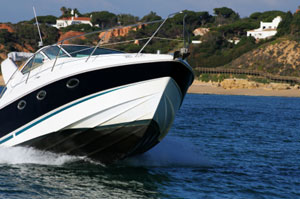
With so many different types of boats available, we bring you this beginner's guide to Motorboats. We hope it will help you make the right choice when buying a boat.
What is a motorboat?
A motorboat is a power driven vessel with an internal combustion engine driving a jet pump or propeller. Even a sailboat, while it has an engine running, is technically a power driven vessel. The term motor boating refers to motorised cruising vessels used for leisure.
A little bit of history!
Many names contributed to the invention of the motorboat. Charles Raymond Hunt was responsible for introducing the deep v-shaped hull in 1963, one of the motorboats most important advances. Renato Levi is given credit for the evolution of the motorboat, particularly developing unique concepts - improving the performance of racing boats. Rudolph Diesel also helped make advancements in motorboat industry. He is best known for inventing a 25-horsepower, four-stroke, single vertical compression engine.
Types of motorboats
A speedboat is a small motorboat designed to move quickly. It is often used in races and for water skiing. Even inflatable boats and dinghies with a motor attached are classed as types of motorboats.
The three popular variations of motorboats are: inboard, inboard / outboard and outboard. If the engine is fitted within the boat, it's called a powerplant. If it's a removable section attached to the boat, it's known as an outboard motor.
Motor cruisers offer a range of amenities, depending on the number of passengers and the type of the cruising. They range from small vessels equipped with basic essentials for a short cruise to much larger holiday crafts complete with shower, cooker and sleeping accommodation.
Where to begin
All first time motorboat cruisers should have some form of training. As a rule, the larger the motorboat and the longer the journey, the greater the level of training is required.
Beginners can rent small vessels for a short cruise, without needing much training. This will help you get to grips with the basic motorboat controls. Courses are available for beginners which cover the basic areas of handling the boat. The Royal Yachting Association offers three levels of courses, from a two day helmsman course offering basic boat handling, helmsmanship and engine maintenance to a five-day coastal skipper course.
A great way to start motorboating is to combine your motor boating course with a holiday, either in the UK or across the European mainland. A number of well known activity holiday companies are RYA training centres and offer courses with certificates.
Where to use your motorboat
Motorboating is the perfect way to explore Britain's many rivers –the Norfolk Broads, the Yorkshire dales, the historic city of York and the River Thames.
But there is no need to limit cruising to UK waters. Ireland, Germany, France and many other European countries offer a number of beautiful and interesting waterways.
From inland lakes to rivers and overseas, motor boating offers a relaxing and fun pastime. Unlike sailboats, there is no need to wait for the right wind conditions before setting sail.
Share this article
You might like.

Sign up to our newsletter
By submitting this form, you agree to our Privacy & Cookie Policy
Change units of measure
This feature requires cookies to be enabled on your browser.
Show price in:
Show lengths, beam and draft in:
Show displacement or weight in:
Show capacity or volume in:
Show speed in:
Show distance in:

On the Edge
- Jul 14, 2023
Different Types of Motorboats Explained
Updated: Apr 17
As you venture into the world of boating, familiarizing yourself with various boat types becomes essential. Especially if you're inclined towards adventure sports and water activities, choosing the right boat is crucial to ensure you make a wise investment. To help you navigate this decision-making process and avoid unnecessary expenses, here's a quick breakdown of key considerations you need to keep in mind.
Engine Types
Inboard vs. outboard.
There are two main types of boat engines: inboard and outboard. An inboard engine utilizes an automotive-style engine, typically V6 or V8, situated inside the boat. The boat's drive is a separate component. On the other hand, an outboard engine is usually a smaller unit mounted on the stern, integrating the gearbox and propeller. When considering boat restoration, replacing an inboard engine is more challenging compared to an outboard engine, which is simpler and easier to repair or replace. Outboard engines are commonly used in fishing and pontoon boats, while inboard engines are typically found in ski or wake boats.

Outboard Boats
Fishing boats.
Fishing boats are the most convenient types of boats to maintain. The outboard engine is easy and cost-effective to replace or repair if need-be. The interior of the boat is usually coated so that fisherman don't have to worry about making a mess with bait or catches due to how easy they are to clean. These boats can be on the smaller side, making them easy to turn, tie off, and transport. Add-ons and upgrades are easy to install and find.
Pontoon boats are great for large groups of people because of the ample seating and space they provide. These boats are typically comfortable for passengers, and you can even pull a tube or kneeboard behind it. The outboard engine is easy to maintain. Pontoons tend to be lengthy, making them more stable in rough waters. The ultimate family or party boat.
Inboard Boats
Sterndrive (i/o = inboard/outboard drive).
A sterndrive configuration features an inboard engine positioned at the stern of the boat, facing forward, and directly linked to the outdrive. The outdrive functions as a gearbox where the propeller is attached.

In this setup, the outboard drive and propeller are situated outside and behind the boat, a common arrangement for fish and ski boats. While these boats are suitable for wakeboarding and water skiing, it is both illegal and hazardous to wake surf behind them. The external placement of the propeller introduces an additional safety concern, emphasizing the importance of driver and passenger awareness of basic boat safety rules.
A V-Drive features an inboard engine positioned at the rear of the boat, often beneath a padded sun deck. Unlike a sterndrive, the engine faces aft. The propeller is located underneath the hull, making it legal for wake surfing. These boats typically come equipped with ballast tanks, as they are designed with wake surfing in mind. The weight distribution of the engine in this location creates optimal waves for surfing, and the boat is also suitable for wakeboarding and water skiing. However, it's worth noting that this transmission type experiences more power loss compared to sterndrive or direct drive configurations, making large, high-horsepower V8 engines common. Despite this, the boat's design is well-suited for wake surfing, which is its primary intended use.

Direct Drive
A direct drive positions the engine at the center of the boat, and the propeller is beneath the hull, allowing for legal wake surfing. The central engine placement creates symmetrical wakes, ideal for water skiing. With the addition of ballast tanks or fat sacs, this boat can generate suitable wakes for wakeboarding. While wake surfing is possible with these boats, it requires a wake shaper, rear ballast tanks, fat sacs, or a sufficient number of passengers.
The central engine location facilitates easy access and maintenance. However, a drawback of this design is that the engine occupies a significant amount of space in the boat, resulting in reduced seating and storage capacity.

Embarking on your boating journey involves a thoughtful exploration of various boat types, each catering to specific preferences and activities. As you navigate the vast waters of this decision-making process, understanding the nuances of boat engines and their configurations becomes paramount.
Inboard and outboard engines represent the two pillars of boat propulsion, each offering unique advantages. The inboard engine, characterized by its placement within the boat, stands out for its automotive-style design, with the outboard alternative being a smaller, more maneuverable option.
Delving deeper into inboard engines, distinct configurations like Sterndrive (I/O), V-Drive, and Direct Drive each bring their own set of features and considerations. The Sterndrive, with its inboard engine at the stern, balances power and versatility but cautions against wake surfing due to safety concerns. The V-Drive, positioned at the rear with optimal weight distribution, excels in creating ideal waves for wake surfing, albeit with higher power consumption. Meanwhile, the Direct Drive, boasting a centrally placed engine, provides symmetrical wakes for water skiing but demands a trade-off in terms of reduced boat space.
In your pursuit of the perfect boat, aligning your choice with your intended water activities is key. Whether it's enjoying time with large gatherings, fishing, wakeboarding, water skiing, or the exhilarating sport of wake surfing, each engine type offers a tailored experience. Consider your priorities – be it ease of maintenance, space efficiency, or the specific water sports you wish to indulge in – as you make this significant investment in your aquatic adventures.
May your boating endeavors be filled with smooth rides, thrilling adventures, and the joy of cruising the waves in a vessel perfectly suited to your aspirations. Safe travels and happy boating!
- Water Sports

Recent Posts
Choosing the Right Boat for Water Sport: A Comprehensive Guide
Types of Boats: Your Ultimate Guide to Boat Varieties
In Watercraft, human history bears witness to the evolution of boats, from rudimentary logs and makeshift rafts to the intricate vessels that grace today's rivers, lakes, and oceans. Amidst this maritime tapestry, boat classification and terminology intricacies can prove befuddling . Therefore, commencing this journey into the diverse world of boats necessitates an initial focus on the fundamental boat categories.
Boats diverge significantly from ships, often imposing titanic structures encompassing cargo and cruise ships . In stark contrast, vessels contain a more diminutive scale, from utilitarian tugboats to various recreational counterparts. This eclectic collection of boat types commands attention and warrants exploration.
Types of Motor Boats

Motorboats have surged ahead, outnumbering their sailboat counterparts. They navigate coastal waters, serene lakes, meandering rivers, and occasionally brave open oceans . The range is vast, from modest skiffs equipped with basic outboard engines to grandiose motorboats and cruisers wielding formidable power.
Pontoon Boats

Pontoon boats, designed for tranquil inland waters, flaunt two or three aluminum tubes as their hull foundation . Possessing shallow drafts and modest outboard engines, these family-friendly vessels facilitate leisurely activities such as swimming, barbecues, and sunbathing. Emerging luxury pontoon models now boast water slides, potent machines, and abundant amenities.
Bowrider Boats

The bowrider, a cherished American favorite, features an open V-shaped bow that seats numerous passengers . Prized for their ease of handling and trailering capabilities, bowriders accommodate day trips and watersports adventures, typically equipped with sterndrive or outboard engines.
Center Console Boats

The center console boat positions its helm station at the vessel's core. Known for their swift, expansive sport fishing capabilities in offshore and open-ocean settings, these boats may wield one to four outboard engines . Their practical design includes walk-around decks and fishing accessories like bait wells, rod holders, fish lockers, and live wells.
Cuddy Cabin Boats

Cuddy cabin boats, compact and versatile, offer a sheltered cabin space beneath the closed deck atop the bow. These boats serve multifaceted roles, from family outings to fishing, watersports, and coastal or inland cruising . They are typically constructed from aluminum or fiberglass, known for their ease of handling and trailering.
Trawler Boats

Traditionally conceived for laborious fishing tasks, trawler boats have undergone a contemporary transformation, resembling miniature superyachts. Characterized by displacement hulls , fuel-efficient engines , and long-range cruising capabilities , trawlers offer an abundance of interior space , including cabins , galley , and bathrooms . These boats cater to extended oceanic voyages and full-time living aboard.
Cabin Cruiser Boats

Cabin cruiser boats present an enticing proposition , enabling weekend getaways or overnight vacations , courtesy of their cabin , galley , and head . Spanning a wide spectrum, these motorboats range from sizable models akin to mini superyachts to more compact variants ideal for brief excursions. Cabin cruisers blend spacious decks with cozy living quarters, promising entertainment and relaxation.
Wakeboard / Ski Boards Boats

Watersports boats, tailored to water skiing, wakeboarding, tubing, and various aquatic activities, feature clear visibility from the helm, inboard engines, and ample storage for gear. Outfitted with trim tabs and ballast tanks, these boats offer adjustable wake patterns to cater to different watersports preferences . They also double as fishing and day boats, with newer models merging the two worlds.
Setting Sail with Motor Yachts

Motor yachts, typically exceeding 40 feet in length, epitomize opulent cruising experiences. These vessels, equipped with modern amenities , including cabins , galley , and bathrooms , offer extensive space for socializing , swimming , and extended voyages . Motor yacht speeds can vary widely, propelled by diesel engines, and the largest ones employ full-time crews.
Fishing Boats

Fishing boats encompass a rich diversity, with center console boats being a notable example. Built to facilitate serious angling, they are equipped with an array of fishing gear, from live wells to rod holders, swivel seats, and expansive deck space . Distinctions arise in their suitability for oceanic or inland waters, affecting factors such as hull design and engine power.
Recreational Fishing Varieties
Noteworthy recreational fishing boat categories encompass bass , dual console , skiff , and sportfishing boats , each tailored to specific angling preferences and environments.
Rigid Inflatable Boats

The RIB (Rigid Inflatable Boat) , revered for its resilience, combines a solid base with robust inflatable tubes forming the hull. RIBs serve diverse purposes, from modest tenders with detachable outboards to high-speed Maxi RIBs with luxurious cabins and amenities. Their sturdiness makes them versatile for lake-based leisure and robust workboat duties.

Deck boats, often likened to bowriders, distinguish themselves with even more extensive bow areas and spacious decks . Popular as family runabouts, they offer abundant exterior space and can accommodate sizable passenger loads, making them excellent for day cruises and, in some cases, fishing expeditions.
Types of Sailboats

Sailboats encompass a broad spectrum, ranging from towering three-masted schooners with centuries of oceanic history to compact dinghies, including the renowned International Optimist Dinghy. Sailboat differentiation hinges on various aspects, including sailing rig and hull design, with common types including sloops, cutters, schooners, ketches, and yawls .
🚀Recommended article: Small Sailboat Types: Your Guide to the Perfect Vessel

The sloop, characterized by a single mast and two sails ( mainsail and headsail or jib ), ranks as the most prevalent sailboat type. Renowned for its ease of handling, versatility across different wind conditions, and commendable upwind and downwind speeds, sloops span from small daysailers to high-performance racing vessels.

Cutter sailboats, closely resembling sloops with single masts, set themselves apart with two headsails that enhance stability and provide maneuvering options in strong winds. They often feature a bowsprit to expand the sail area, appealing to those embarking on ventures across tumultuous waters .

Schooners, with multiple masts, including a shorter foremost mast, navigate the high seas with aplomb . Laden with numerous sails and fortified to withstand formidable maritime conditions, schooners have charted oceans for centuries.
Ketch and Yawl

Ketches and yawls share the hallmark of dual masts, with the mainmast taller than the mizzen. Ketches position the mizzen forward of the rudder post while yawls place it aft . Their distinctions and utility are further examined in the Ketch vs Yawl comparison.
Dinghies and Daysailers

The smallest sailboats, dinghies, and daysailers are designed for short-distance sailing in sheltered waters. These boats typically feature a single mast and straightforward sail plans . Dinghies designed for racing can exhibit heightened complexity and exceptional speed, demanding a measure of skill and athleticism.
Celebrating Classic Wooden Yachts

Classic wooden yachts, imbued with timeless charm, deserve special recognition . These vessels, ranging from 15-foot daysailers to 50-foot cruising boats, often sport one of the rigs. Their unique allure adds a distinct chapter to maritime heritage.
Types of Multihull Boats

Catamarans, defying conventional categorization, may serve as either sailboats or motorboats. Distinguished by twin hulls, they offer shallow drafts, a smoother ride compared to monohulls, and substantial cabin and storage space . Smaller variants feature trampolines between the hulls, while larger models boast above-water living quarters adorned with expansive windows and ample light. The Catamaran vs Monohull comparison provides further insights.
📢Read also: Best Catamaran Fishing Boat Brands 2024

Trimarans, with three hulls instead of two, offer heightened speed and stability, particularly when contrasted with catamarans. These boats enjoy popularity in racing circuits and excel in long-distance cruising, albeit somewhat less common than their catamaran counterparts. The Catamaran vs Trimaran exploration provides a deeper understanding .
Types of Small Boats

Small boats, encompassing sailboats, motorboats, and multihull boats, merit distinction due to their size and varied applications. Personal Watercraft (PWC) boats , Jon boats , dinghies , canoes , kayaks , and stand-up paddleboards cater to diverse recreational preferences, offering accessible waterborne escapades.
🎯Suggested article: Discover the Best Types of Small Boats for Every Water Adventure
Personal Watercraft (PWC) Boats

Personal Watercraft, often overlooked in the broader boat spectrum, comprise small, nimble motorized craft . Riders sit or stand atop these vessels rather than within, with prominent brands including JetSki and SeaDoo.

Designed for placid fishing endeavors on inland waters, Jon boats boast slim, flat-bottomed profiles built for resilience. Their sizes range from approximately 10 to 18 feet , accompanied by various fishing accessories.

Whether powered or not, dinghies represent some of the smallest boat variants. Frequently serving as tenders for larger vessels, they find utility in rowing, sailing, and racing for adults and youth . Sailing dinghies, tailored for beginners, offer simplicity and ease of handling.
Canoes, Kayaks, and Stand-up Paddleboards

Human-powered Watercraft in the form of canoes, kayaks, and stand-up paddleboards offer accessible aquatic experiences. These vessels blend affordability with portability ; some even fold into compact sizes for easy transportation.
Types of Lake, River and Canal Boats

Lake , river , and canal boats encompass a broad range, catering to specific freshwater and saltwater settings. Lake boats often feature flat bottoms for easy access to shallow waters, while river and canal boats prioritize narrow beams and extended lengths.
The Panorama of Lake, River, and Canal Boats Includes :
- Pontoon boats
- Fishing boats
- Watersports boats
- Sportfishing boats
- Cabin cruisers
- Narrowboats
- Dutch barges
The Unique Appeal of Houseboats

Houseboats, distinct and versatile, excel in offering comfortable living conditions. These unique vessels span various global styles, from Dutch barges in mainland Europe to narrowboats commonly found in the UK . In the United States, houseboats encompass unpowered and powered varieties, ranging from spacious floating platforms with modern comforts to expansive, luxurious models reminiscent of condominiums. Houseboats remain stationary for extended durations, are commonly moored in residential marinas, and are not designed for regular cruising. Notably, houseboats thrive in both freshwater and saltwater locales .
In conclusion, this comprehensive guide unveils the diverse landscape of boats, celebrating the rich tapestry of waterborne experiences and the myriad vessels that facilitate them. Whether cruising the open ocean , sailing serene lakes , or embarking on adventures in calm inland waters , the world of boats beckons with a captivating array of options for enthusiasts and adventurers alike.
Was this page helpful?
Save my name, email, and website in this browser for the next time I comment.
- All New Boats
- New Boats in Stock
- Yamaha Waverunner
- Part Exchange
- Self Drive Day Hire
- Floating Holidays
- RYA Training Centre
- Meet The Team
- Burton Waters – Lincoln
- Ipswich Beacon Marina
- Servicing & Repairs
Quick Search
search boats
Manufacturer
Banks Martin
Camper & Nicholsons
Channel Island
Chris-Craft
Cornish Crabbers
Cruisers Yachts
Dutch Barge
English Harbour
Falcon Boat
Falmouth Cutter
Ferretti Yachts
Grand Banks
Grand Inflatables
Hallberg-Rassy
Island Packet
Liverpool Boats
Marex Boats
Marina Boats
Morgan Giles
Motor Yacht
Norfolk Broads Cruiser
Norman Wright
Northmaster
Present Yachts
Prinz Yachts
Quicksilver
Sessa Marine
Super Van Craft
Tiara Yachts
Valiant RIBs
Viking Boats
Viking Marin
Wide Beam Narrowboat
Williams Jet Tenders
- Yamaha Boats
Yamaha WaveRunner
10 Lounge (1)
10 Lounge Top (2)
10 sedan (3)
1080 Offshore (2)
11 Flylounge (2)
11 Sedan (2)
11 Sedan - in stock (2)
12 FlyLounge (2)
12 Sedan (2)
1240 DL (2)
175 Bowrider (2)
185 Bowrider (1)
19 Day Angler Plus (1)
192 Discovery (2)
1952 Capri Classic (1)
20 Bosun (1)
215 Express Cruiser (3)
22 LAUNCH (1)
2300 Cuddy (1)
232 Captiva Cuddy (2)
238 Vista (1)
24 Day Cruiser (1)
24 Hi-Line Widebeam (1)
240 Express Cruiser (1)
240 Senator (1)
240 SIGNATURE (2)
240 Sundancer (2)
2400 SCR (1)
2400 SE (2)
242 FIESTA VEE (2)
245 Cruiser (2)
2465 Commodore (1)
255 Senator (6)
255 SSi (1)
2565 Window Express (2)
258 Vista (6)
26 Wide Beam (1)
2600 SE (2)
265 Vista (2)
268 Vista (2)
27 familia (1)
270 Ambassador (1)
270 Fiesta Vee (1)
270 Sundancer (1)
270 TAF (1)
2700 SCR (1)
2700 SE (1)
275 Cruiser (1)
275 STi (1)
28 AFT CABIN (2)
28 classic (1)
28 Express (4)
280 AS Deluxe (1)
280 Coupe (2)
280 Express Cruiser (1)
280 Holiday (4)
2800 Holiday (2)
285 Wake ID (2)
2855 Ciera (1)
2855 Ciera DX/LX Sunbridge (1)
29 Offshore (3)
29 Sedan (1)
29 Sport (1)
292 Commodore (1)
295 Sport Yacht (1)
296 Cruiser (1)
300 Sport (1)
305 Statesman (1)
3055 Ciera (1)
31 Flybridge (1)
310 Coupe (2)
310 TAF (1)
3100 Open (1)
3100 SE (1)
32 Centre Cockpit (2)
32 Sedan (1)
320 Jet DL (3)
3255 Avanti (2)
33 MK II (1)
33 Open (1)
33 Sport (1)
335 Coupe (1)
340 Golden Line (1)
35 Aspré (1)
35 Classic (1)
35 Corsica (1)
35 European (1)
36 Classic (2)
360 Ambassador (3)
360 Statesman (2)
37 Corsica (1)
37 Elite (1)
38 CC / 38CC (1)
38 Cruiser (1)
380 Ambassador (1)
380 Challenger (1)
390 Motor Yacht (1)
4 Plus 2 (1)
40 Sundeck LBC (5)
400 Express Cruiser (1)
42 CC Ketch (2)
420 F-Line (2)
420 Fly (3)
420 Sport (2)
425 Grand Large (1)
42ft Stern Cruiser (1)
43 ATLANTIS (1)
45 Flybridge (2)
500 S/500S (1)
54 Flybridge (1)
540 Cruiser (2)
550 open (0)
550 sundeck (2)
575 Sunliner (2)
58 Sunliner (2)
590 CABIN (1)
6.5m RIB (2)
602 Cuddy (2)
62 Flybridge (1)
642 Cuddy (1)
652 Cuddy (1)
685 Cruiser (1)
7.8m RIB (1)
702 Cuddy (1)
705 ACTIV (1)
755 Pilothouse (1)
795 series2 (0)
880 Tourer (3)
94 Custom Line (1)
975 Artic (1)
A Series 600 (1)
Activ 505 Cabin (1)
Amber Boats Venice 58 (1)
Antares 11 (3)
Antares 12 (1)
Antares 42 (1)
Antares 6.80 (2)
Antarès 650 HB (1)
Antares 8 (2)
Antares 9 (1)
Antares Serie 9 (3)
Antares Series 9 (1)
AS 43 GLX (2)
Atlantis 34 (1)
Barracuda 6 (2)
Bass Trailer Sailor (1)
Beaulieu 30 (1)
Bourne 35 (0)
Bourne 37 (1)
Bourne 37 Broads Cruiser (1)
Branson Thomas 57 (2)
Broads Cruiser (1)
Cabrio 260 (1)
Cap Camarat 10.5 WA (1)
CAP CAMARAT 12.5 WA (2)
Cap Camarat 4.7 CC (2)
Cap Camarat 5.5 CC (1)
Cap Camarat 5.5 DC (1)
Cap Camarat 5.5 WA (2)
Cap Camarat 5.5 WA Series 2 (5)
Cap Camarat 6.5 (1)
Cap Camarat 6.5 CC (1)
Cap Camarat 6.5 CC Series 3 (4)
Cap Camarat 6.5 DC (2)
Cap Camarat 6.5 WA (1)
Cap Camarat 6.5 WA Série 3 (2)
Cap Camarat 6.5DC (1)
Cap Camarat 7.5 CC SÉRIE 2 (1)
CAP CAMARAT 7.5 CC SERIE 3 (1)
Cap Camarat 7.5 DC (1)
Cap Camarat 7.5 WA (2)
Cap Camarat 7.5 WA BLUE HULL (0)
Cap Camarat 7.5 WA SÉRIE 2 (1)
Cap Camarat 7.5 WA Series 3 (6)
Cap Camarat 755 WA (2)
Cap Camarat 9.0 CC (1)
Cap Camarat 9.0 wa (1)
Cap Camerat 6.5 (0)
Caprice (1)
Capricorn (1)
Captiva 232 CC (1)
Centaur (3)
Ciera 8 (1)
Clubline 46ft - Non runner (1)
Corsair 25 (1)
CROWN 252 (1)
Cruiser 33 (2)
Cruiser 34 (2)
Cruiser 37 (3)
Cruiser 41 (1)
Cruiser 46 (1)
Cruiser 51 (1)
DB43 IB (4)
Donky 33 (1)
Drive 600 Lux (1)
Eagle 340 (0)
Elegante (3)
Elite 31 (1)
Endurance 30 (2)
Endurance 39 (1)
Explorer 18 (1)
F-Line 33 (1)
F44 Flybridge (1)
Falcon 330 HT (0)
Falcon 330 Tender (1)
Falcon F300T (2)
FalconEagle 340 (0)
Fiat Rapido 9094 (1)
Fiesta 22 (1)
Fiesta Vee 270 (1)
Flyer 650 Open (1)
Flyer 650 Sundeck (1)
Fulmar 32 (1)
FX Cruiser HO (3)
FX Cruiser SVHO (6)
FX Limited SVHO (3)
G650 GLF Golden Line (1)
Galia 530 (1)
GP1800R HO (2)
GP1800R SVHO (3)
Gran Turismo 40 (3)
Greyhound Slipper Launch (1)
GTDW 225 (1)
GTS 205 (2)
Hartford Hawk (1)
Hemming & Morris Marina 20 (2)
Holiday (1)
Holiday MK3 (1)
Horizon 27 (1)
JetBlaster (3)
John White 47ft (3)
Jonathan Wilson Josher Style (2)
Knights Semi-Trad Narrow Boat (1)
Konsort (3)
Leader 10 (0)
Leader 30 (4)
Leader 36 (1)
Leader 40 (4)
Leader 46 (2)
Leader 8 (4)
Leader 9 (2)
Manhattan 46 (1)
Marco 860 AK (1)
Marin 30 (1)
Marine 47 Fly (1)
Marlin 585 (2)
Martinique 36 (2)
Martinique 38 (1)
Matrix 670 SL Axess (1)
Maynard Watson Slipper Launch (0)
Merry Fisher (0)
Merry Fisher 10 (4)
Merry Fisher 1095 (8)
Merry Fisher 1095 - In Stock Now (1)
Merry Fisher 1095 FLY (2)
Merry Fisher 1095 Flybridge (1)
Merry Fisher 1295 (1)
Merry Fisher 605 (7)
Merry Fisher 605 Marlin (2)
Merry Fisher 605 Series 2 (2)
Merry Fisher 645 (1)
Merry Fisher 695 (11)
Merry Fisher 695 Marlin (1)
Merry Fisher 695 Serie2 (2)
Merry Fisher 725 HB (1)
Merry Fisher 755 (2)
Merry Fisher 795 (19)
Merry Fisher 795 Marlin (1)
Merry Fisher 795 s2 (4)
Merry Fisher 795 Series 2 (19)
Merry Fisher 795 Series 2 Sport (2)
MERRY FISHER 795 SPORT (2)
Merry Fisher 805 (4)
Merry Fisher 855 (4)
Merry Fisher 895 (21)
Merry Fisher 895 Marlin (1)
Merry Fisher 895 Offshore (11)
Merry Fisher 895 Offshore S2 (1)
MERRY FISHER 895 S2 (3)
Merry Fisher 895 Sport Series 2 (1)
Merry Fisher 925 (3)
Mini Sport (1)
Mirage 29 (1)
Monticello (1)
MX 175 BOW RIDER (1)
Narrow Boat (4)
NC 11 NC11 (1)
NC11 NC 11 (0)
NC37 / NC 37 (1)
NC9 / NC 9 (1)
Ocean 37 (1)
Oceanis 311 (1)
Oceanis 311 Clipper (1)
Oceanis 43 (2)
Oceanis Clipper 311 (1)
Oceanis Clipper 323 (1)
Oceanis Clipper 473 (1)
Oceanranger 33 Aft Cabin (1)
Oceanranger 33 Aft Cockpit (0)
Outhill Ranger 15 (1)
Oyster 30 (2)
Oyster 35 (1)
Packet 27 (1)
Passage Maker 47 (2)
Passagemaker 47 (0)
Pelican 21 (1)
Pendle 57ft Narrow Boat (1)
Phantom (1)
Phantom 38 (2)
Phantom 40 (2)
Phantom 42 (2)
Phantom 43 (5)
Phantom 46 (2)
Phantom 48 (1)
Phantom 50 (4)
Pilot 20 (2)
Pilot cutter (1)
Pilot House 20 (1)
Portofino 400 (2)
Portofino 47 (1)
Portofino 48 (3)
Portofino 53 (2)
Portofino XPS 25 (1)
Prestige 30 S (1)
Prestige 32 (1)
Prestige 34 S (1)
Prestige 36 (1)
Prestige 38 (1)
Prestige 39 (2)
Prestige 46 (1)
Pro 550 (1)
R2/600EL (0)
Ranger 36 (1)
Rapier 3100 (1)
Reflection (1)
Rib 470 nl (1)
River Cruiser (1)
Robinsons Stern Cruiser (1)
Roger Fuller 54ft (1)
Royal Cruiser Baltic 36 (1)
S23 Sports Cruiser (8)
S28 Sports Cruiser (4)
S37 Sports Cruiser (3)
S41 Sports Cruiser (3)
S43 Sports Cruiser (1)
Sant Carles (1)
Seawings 277 (1)
Seawings 305 (1)
Seawings 355 (3)
sedan 32 (1)
Silverline SLR270 RIB (1)
Slipper Launch (1)
SmartFisher 46 (2)
Speedboat (1)
Spirit 3000 (4)
SPX 190 (3)
Squadron 59 (2)
Static Model (1)
Storm 33 (2)
Sun Odyssey 34.2 (1)
Sun Odyssey 45 DS (1)
Sun Odyssey 479 (2)
Sundancer 335 (1)
Sunfury 26 (1)
Super RIB 22 (2)
SuperJet (1)
Swift Trawler 34 (2)
Swift Trawler 35 (1)
Swift Trawler 42 (1)
Talisman 46 (1)
Targa 29 (1)
Targa 33 (1)
Targa 34 (2)
Targa 37 (2)
Targa 38 (1)
Targa 38 GT (1)
Targa 38 Shadow-S (1)
Targa 39 (2)
Targa 40 (3)
Targa 47 GT (2)
Teddesley (1)
Traveller (1)
Truly Classic 75 (2)
Turbojet 285 (1)
Turchese 24 (1)
Velasco 37 (3)
Velasco 43 (4)
Velasco 43F (2)
Vision 42 (3)
Vision 46 (1)
Vista 255 (2)
VX Cruiser HO (4)
Weekend 640 Pilothouse (1)
Widebeam (2)
X70 UK and Med Delivery (0)
Yam 240T (1)
Zaffiro 34 (3)
Your Guide to The Different Types of Motorboats
Different Types of Motorboats
It can be easy to let your head rule your heart, so try to always keep the practicality at the forefront of your boating considerations, if fishing is your forte, then you’ll be looking towards a more practical, utilised vessel rather than one with a lavish interior. Perhaps young children will be on board your boat, so their safety will be paramount – secure seating, a deep cockpit and toilet facilities are all things to be considered in this case.
Types of Motorboats: Trailer Boats
Top tip: Before purchasing any boat, check that your vehicle meets the legal restrictions to tow the boat and its trailer – your car handbook should list the maximum safe towing weight.
Second-Hand Boats

Ski Boat/Wake Boat
- Requires flattest and smoothest wake possible
- The fewer people on board the boat, the better
Wake boarding
- Requires big wakes/waves to perform more moves and to gain air time (a more extreme sport to water skiing)
- The more on board the boat, the better
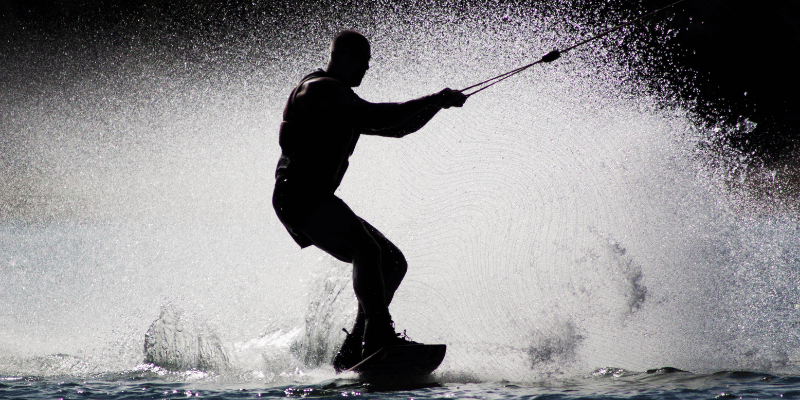
- Axis Wake Research
- Centurion Boats
- Chaparral Boats
- Formula Boats
- Larson Boats
- Malibu Boats
- MasterCraft Boats
- Monterey Boats
- Moomba Boats
- Nautique Boats
- Scarab Boats
- Sea Ray Boats
- Ski Supreme
- Supra Boats
- Varatti Boats
Types of Motorboats: Rigid Bottom Inflatable
- Commercial workboats
- Rescue boats
- Military, Police & Patrol boats
- Leisure & family boats
Fishing Boats
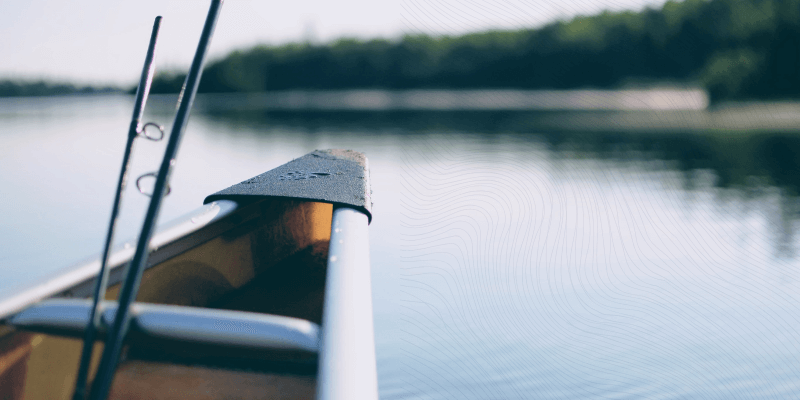
- Commercial fishing vessels: These are vessels used for industrial fishing and used for catching large quantities of sea food for many countries around the world for commercial profit, and probably not what you’re looking for unless you run a sea food supply company!
- Artisanal fishing vessels: Also known as traditional or subsistence fishing boats are various small-scale, low-technology fishing boats which are owned by individuals; these boats are the major competition to commercial fishing boats as they decrease the income of commercial boats by supplying seafood in the local regions.
- Recreational fishing vessels: Vessels which are not dedicated to fishing alone; rather for fun and amusement. The size of these vessels can range from small to large.
- Jeanneau Merry Fisher Range
- Orkney Vanguard 190
Centre Console Boats
- Boston Whaler
- Carolina Skiff
- Century Boats
- Everglades Boats
- Grady-White Boats
- Hydra-Sports
- Pursuit Boats
Types of Motorboats: Bow Rider
Walk around, canal or narrow boat.
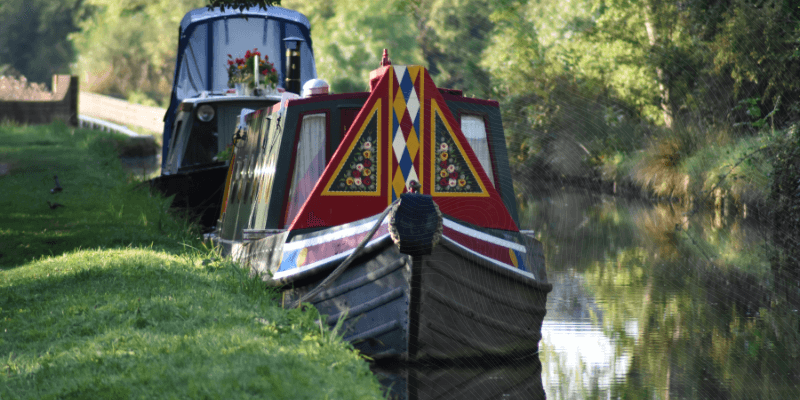
Types of Motorboats: River Cruiser
Did you know: River cruisers are popular on the Norfolk Broads.
- Alpha Craft
- Shetland Boats
- Viking Seamaster
Sports Cruiser

Flybridge Cruiser
Types of motorboats: so many choices….

Leave a Comment: Cancel reply
Your email address will not be published. Required fields are marked *
Similar post
Boot düsseldorf 2023: visitor boot themed areas and some of the most exciting new boats to track down., buying your first boat – what you should know, southampton boat show 2022, new powerboat models turned toward the future.
- Announcements
- Boat Buying
- Boat Financing
- Boat Maintenance
- Boat Surveys
- Boating Beginner
- News & Advice
This site is protected by reCAPTCHA and the Google Privacy Policy and Terms of Service apply.
Popular posts
Unlock exclusive brokerage deals for selling your boat hassle-free with Burton Waters. Benefit from free storage, deferred transport costs, low-rate fees, captivating drone footage, walkthrough videos, and extensive social media coverage. Sell your boat seamlessly today
A Guide to Different Types of Motorboats
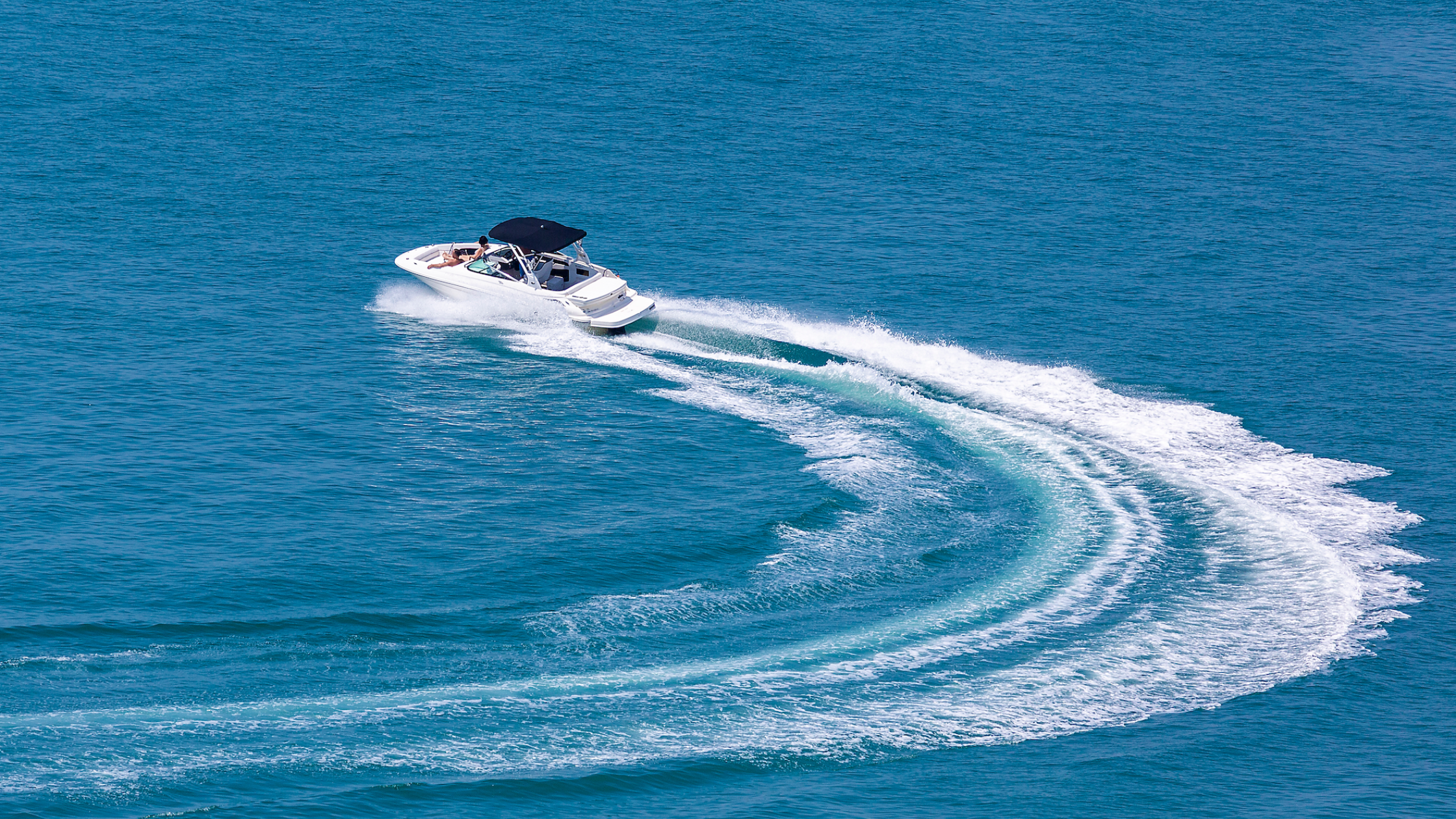
Bass boat on a lake | Credit battler on Shutterstock
Bass boats: Aluminum bass boats are primarily used for freshwater fishing. With a V-hull and low freeboard (hull sides) they are used on lakes and rivers and are powered by outboard motors to get up on plane quickly.
Bay boats: Usually built of fiberglass because they’re used in salt or brackish water, bay boats are designed for the shallows.
Flats boats: With very shallow drafts and flat bottoms, flats boats run 14-20 feet in length and are generally powered by an outboard motor.
Center console boats: These boats have an open “walk around” concept to help anglers move about easily when they have a fish on. These designs have planing hulls and are powered by one or multiple outboard engines.
Jon boats: Small utility boats designed for shallow water, Jon boats can be made of aluminum or fiberglass. They’re inexpensive and good for beginners.
Skiff boats: Similar to Jon boats, skiffs are good for shallow water and may be driven by an outboard. They can also be rowed.
Sportfishers: Sportfishers have open cockpits used to fight fish and sometimes are called “battle wagons”. Most have deep-V hulls with flatter aft sections so they can get on plane quickly and they come in a variety of sizes.
Family day boats
Family fun boats for lakes, rivers or the coast are used for various activities from fishing to towing and weekending to entertaining.
Bowriders: With an open seating area in the bow ahead of the helm, bowriders are powered by outboard engines or sterndrives.
Dual console boats: With twin dashboards and two sections of windshield, dual console boats have a walkthrough to the bow sunpad or seating area.
Cuddy cabin boats: With a small cabin forward, cuddy boats can accommodate a bed and/or a toilet. They can be used for fishing, family fun or limited overnighting.
Deck boats: Deck boats have a flat deck with plenty of seating space. They can be aluminum or fiberglass, have outboard or sterndrive propulsion and are used for family fun or fishing.
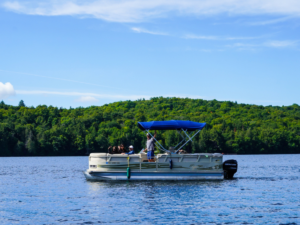
Pontoon Boat | Credit Leonard Zhukovsky on Shutterstock
Pontoon boats: Similar to deck boats in their intended purpose, pontoon boats have two or three hulls usually made of aluminum and are powered by outboards. Very stable and beamy (wide), pontoon boats are great for entertaining on lakes and rivers.
Runabout boats: Runabouts can be used for fishing, cruising, watersports or as tenders to larger yachts. They’re typically outboard-powered and 15-30 feet in length.
Jet boats: Powered by jet drives rather than propellers, jet boats are usually under 30 feet and are very maneuverable. They can get into shallow water and are usually used for water sports.
Towboats/Sport boats: Wakeboarding, waterskiing and wake surfing boats are designed for water sports and have powerful inboard engines. Some towboats can be ballasted differently to create large wakes for wakeboarding or wakesurfing. Some towboats are tournament-rated, which means they’re used in competition.
Power cruisers and motor yachts
Motor yachts are variously sized powerboats with one to three engines and luxurious accommodations for extended overnighting.
Pilothouse boats: With enclosed helms ahead of the living space, pilothouse boats are designed to run in rough seas, are powered by inboard engines, and have cabins on the lower deck. They may have an open flybridge with a second helm station above.
Sedan bridge boats: Designed for longer voyages, sedan boats tend to run 35-70 feet. The helm is usually inside but elevated for better visibility forward.
Downeast cruisers: More of a design statement than a use description, Downeast boats were developed in New England and are also called lobster boats. They can be used for day boating, entertaining or cruising and usually have accommodations for overnighting.
Trawlers: Trawlers take their name from old commercial fishing boats but today they’re slow, fuel-efficient, displacement boats for distance cruising under power. They can be well appointed and luxurious.
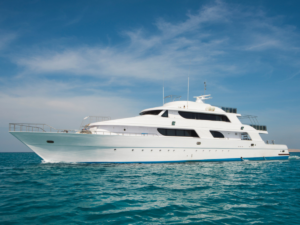
Luxury Motor Yacht | Credit Paul Vinten on Shutterstock
Power catamarans: Powercats have twin hulls and can be large distance cruisers or smaller fishing craft. They’re stable and roomy and usually more fuel-efficient and faster than monohulls of comparable length.
Cabin cruisers: Any larger boat with full accommodations can be considered a cabin cruiser or coastal cruiser. These boats are well-equipped including having air conditioning, generators, galleys and more. Lengths vary but hover around 40-70 feet.
Superyachts: Large and luxurious, superyachts (also megayachs) are often in excess of 100 feet and are professionally crewed.
Tenders/RIBS: Most commuter dinghies are rigid inflatables (RIBs) which means they have inflatable tubes with rigid bottoms and they’re lighter and more buoyant. They’re powered by outboard engines and often used as tenders to a larger yacht.
Miscellaneous powerboats
This last category captures many powerboats that don’t fit any categorization above.
High performance boats: High performance boats are built for speed (and racing) and can be 25-60+ feet. Propulsion can be inboard or outboard.
Houseboats: Houseboats are floating houses that can be 25-100+ feet. They have full, home-style accommodations and function more like barges than boats. Some houseboats are motorized and can be rented on lakes and rivers for a week of pseudo-camping.
Personal watercraft: PWCs are technically boats especially since they’ve become larger, heavier and more feature rich. They can carry one to four people and can run in excess of 60 mph with their jet drives.
Blurring design lines
Today there’s a convergence in boat uses so many designs are being asked to do double and triple duty. Fishing boats now have more seating and outdoor galleys for entertaining, motor yachts can be draped in rod holders to go angling, and dinghies are tenders and sport boats at the same time. One boat can’t be all things to all people, but most boats can make the majority of boaters happy.

Previous Post 8 Top Boating Destinations for Fall
Next post new marinas added in august.

Author Zuzana Prochazka
Zuzana is a freelance writer and photographer with regular contributions to over a dozen sailing and power boating publications. A USCG 100 Ton Master, Zuzana is the founder of a flotilla charter company called Zescapes that takes guests adventure sailing at destinations around the world. Zuzana serves as an international presenter on charter destinations, safety issues and technical topics. She’s also the Chair of the NMMA Innovation Awards, a member of the American Society of Authors and Journalists, and the Executive Director of the Board of Boating Writers International.
Comments are closed.
Keep Exploring

What are Powerboats and Motorboats? Types Explained!
New technologies are being developed and implemented so as to make the rides much faster and safer.
Power boats and motorboats are two categories of vessels, both of which provides a thrilling and breathtaking experience for the people on board.
Let’s fast jump to the subject!
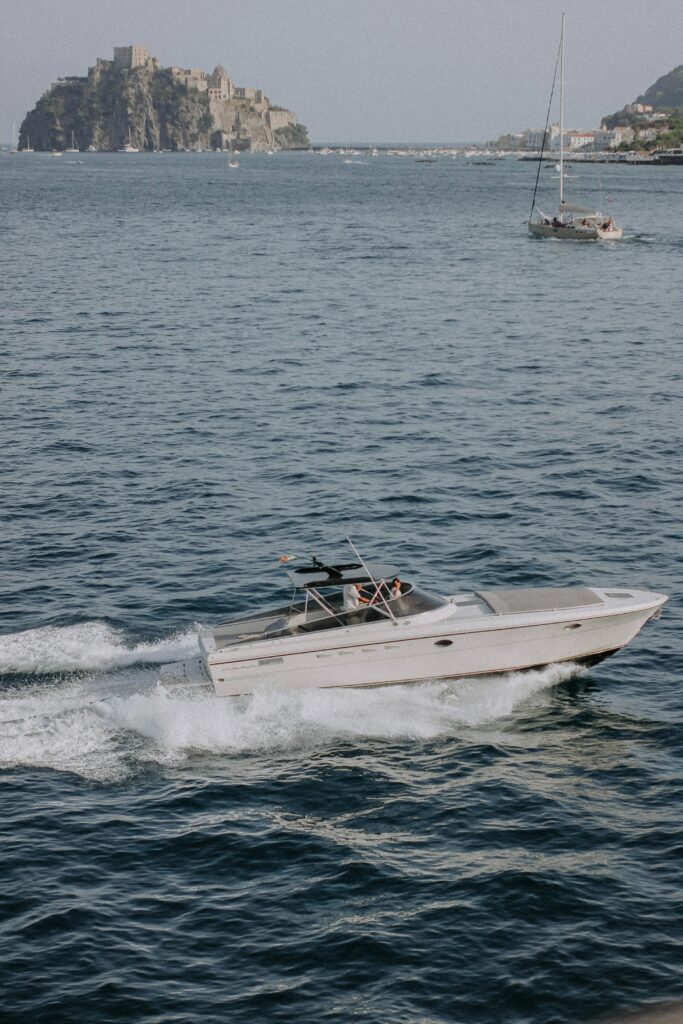
A powerboat is a compact motor-powered vessel that is built within 10 meters in length. It is best suitable for shorter journeys. When compared to motorboats, powerboats are more swift and agile.
The compact structure of these powerboats makes it easier to be controlled and maneuvered during quick turns and diversions. They come in a variety of structures and engine configurations.
Powerboats can be a variety of vessels such as fishing boats , small boats, or even cruising boats that can accommodate a large family. It could even be a fully equipped watercraft with modern amenities.
Powerboating brings great advantages to new and aspiring boaters, learning the skill. Due to its compact structure, it is often easier to learn, and relatively low in price compared to other vessels.
Though they are limited to shorter cruises, it still offers good speed and thus can be perfectly suitable for commanding speed over crossing lakes, rivers, and other coastal areas.
A motorboat also could be called a motor yacht, is a larger motor-powered vessel that is built within 10-40 meters or even more, in length. They are suitable for extensive long journeys.
They have great fuel capacity and nautical charts for navigation. They also hold the onboard facility to accommodate the stay of overnight travelers.
When compared to smaller boats and other powerboats, the functioning mechanism of a motorboat is more complex and challenging to learn.
But that being said, if one finds themselves involved in working on superyachts or even while considering an open ocean vacation, motor cruising offers a variety of functional opportunities.
Types of Powerboats:
RIBs are also known as “Rigid Inflatable Boats”. These powerboats come under the hard-hulled planning crafts along with inbuilt inflatable collars. They are best utilized for fishing, load-carrying, diving, watersports, and lounging.
Based on your boating demands, one has to pick their fit-out and hull shape. It is also best to have a determined use for the powerboat in the making. Usually, RIBs are bought based on their utility, price flexibility, and size.
Depending on the material used for its structure also creates cost variation. Using Hypalon over PVC constructed tubes, ensures better durability but is more expensive. Depending on the boater’s driving style, the choice of seating can be determined from a variety of options such as benches, leaning posts, jockey seats, and impact-mitigation seats.
Sport Yacht
Sport yachts are best utilized for traveling long distances. They have great speed, a sleeker appearance whilst also having better storage, and spacious cabins for overnight and extended stays.
This type of powerboat is best for entertaining guests onboard along with providing ample amenities. It is a mixture of luxury combined with great performance.
These boats offer the luxury of expanding and upgrading basic amenities, for example, having a kitchen with a good quality boat grill. This is a great option for people wanting to own a boat set to hold gatherings and parties on board with a full galley that even comes with convenient upgrades.
These powerboats combine good structural practicality with a compact platform along with providing adequate lounging space. Their open bow design gives it the unique suitability to move around in the ocean cheerfully during good weather conditions such as clear skies.
They are typically seen to have tapered forward lines, but the new bowriders come with the option to offer more spacious formats. Inside a traditional bowrider, the space ahead of the helm is often quite tight.
Contesting that, the new formats of bowriders have beams that are further forward, allowing for more seating room creating a compromise between its sporting ability for aesthetic appeal.
A few key points to look for while trying to examine the ability of a bowrider that can offer outstanding performance in water sports:
- Powerful inboard engines
- Extra cockpit seating
- Wakeboard towers
- Automated throttle
- Wake-tweaking devices
- Walkaround Fisher:
They are great powerboats for those looking for hybrid options. Hybrid applies to the combination of everything like space, size, cost-effectiveness, and modern amenities. A boat for both fishing and water sports and a good example would be the compact Trophy 2152 Walkaround.
Center Console Powerboats
They are highly versatile and thus center console powerboats take the lead. They are suitable for both fishing as well for entertaining your family by taking them for a long and smooth ride.
By choosing boats with center consoles with only basic facilities inbuilt, boaters have the luxury to design their own boats with furniture that best matches their choice and utility.
This also gives them an added advantage of owning a powerboat at a lower cost as the center console would carry less weight. Due to its lighter weight, it tends to have better running efficiency, nimble operation and is easy to maneuver. Great examples are center console aluminium boats that we talked in this article.
Types of Motorboats:
Straight inboard drives:.
A straight inboard drive system includes both a petrol and diesel engine type, a propeller, and a metal shaft. The engine is internally placed in the boat. A special method is used to connect the engine to an external propeller through a shaft that is fitted into the hull. The boat moves through the water as the engine spins the shaft, which spins the propeller.
Pod Drives:
It is a modern propulsion system. They are mostly seen amongst recreational motorboats. The engine is located underneath the boat on the drive unit. Along with the engine, the propeller, the transmission, and the steering mechanism are all part of the driving unit. The pod drive propulsion system is mounted to the bottom of the boat’s hull . They are agile and have great vessel control to pivot independently.
Inboard / Outboard (Sterndrive):
An inboard/outboard drive system also known as sterndrive, consists of an engine along with an outboard drive unit. The engine is located inside the hull, with the drive unit (propeller, transmission, steering mechanism) mounted externally. The entire drive unit turns as the steering wheel turns, letting the boat move.
Outboard Drives:
In this type of motorboat, the transmission, propeller, and engine block come under a single unit among the outboard engine. It is mounted outside the boat, mostly on the transom. The boat moves back and forth using cables and hydraulic rams connected to the outboard.
Jet Drives:
These motorboats carry an inboard engine. The engine spins a metal impeller inside a large water pump. They move at great speed. The large water pump pushes the motorboat forward by sucking up the water and utilizing this for the process letting it move faster.
So if you are looking forward to having a nice day in the water either for cruising or some adrenaline rush both of these boats are the ideal choices.
- Recent Posts
- The Role of Cargo Ships in Global Trade – August 22, 2024
- Report: Yang Ming’s YM Mobility Explosion at Ningbo-Zhoushan Port – August 9, 2024
- Understanding Drillships: Types, Key Features and Advancements – August 1, 2024
About the author
I worked as an officer in the deck department on various types of vessels, including oil and chemical tankers, LPG carriers, and even reefer and TSHD in the early years. Currently employed as Marine Surveyor carrying cargo, draft, bunker, and warranty survey.
Leave a Reply Cancel reply
Your email address will not be published. Required fields are marked *
Save my name, email, and website in this browser for the next time I comment.
Latest posts

The Role of Cargo Ships in Global Trade
Contents show Volume of Goods Transported by Sea Key Global Trade Routes Economic Impact of Maritime Shipping Types of Cargo Commonly Transported Environmental Considerations Conclusion Cargo ships are the lifeline […]
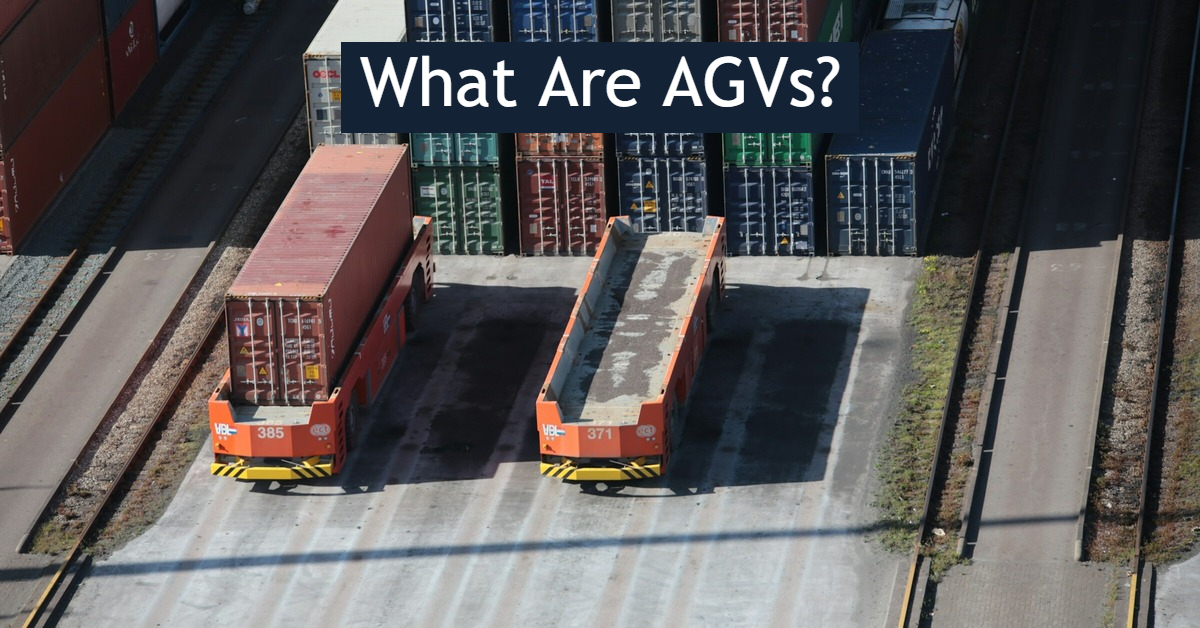
What Are AGVs? Automation Becoming Increasingly Common in Seaports
What are AGVs? Automated guided vehicles can minimize the troubles of manual operations and enhance seaport operations.
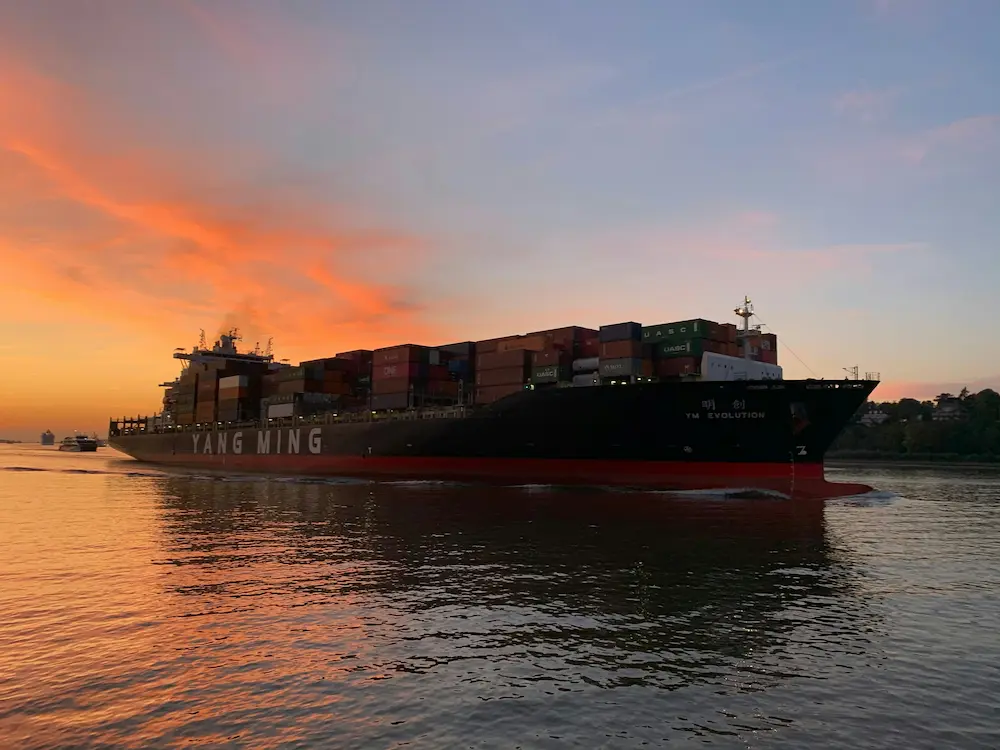
Report: Yang Ming’s YM Mobility Explosion at Ningbo-Zhoushan Port
A massive explosion occurred on the container ship YM Mobility while it was berthed at the Ningbo-Zhoushan Port in China
Basics : Typology - The most important types of motorboat
Erich Bogadtke
· 15.12.2022
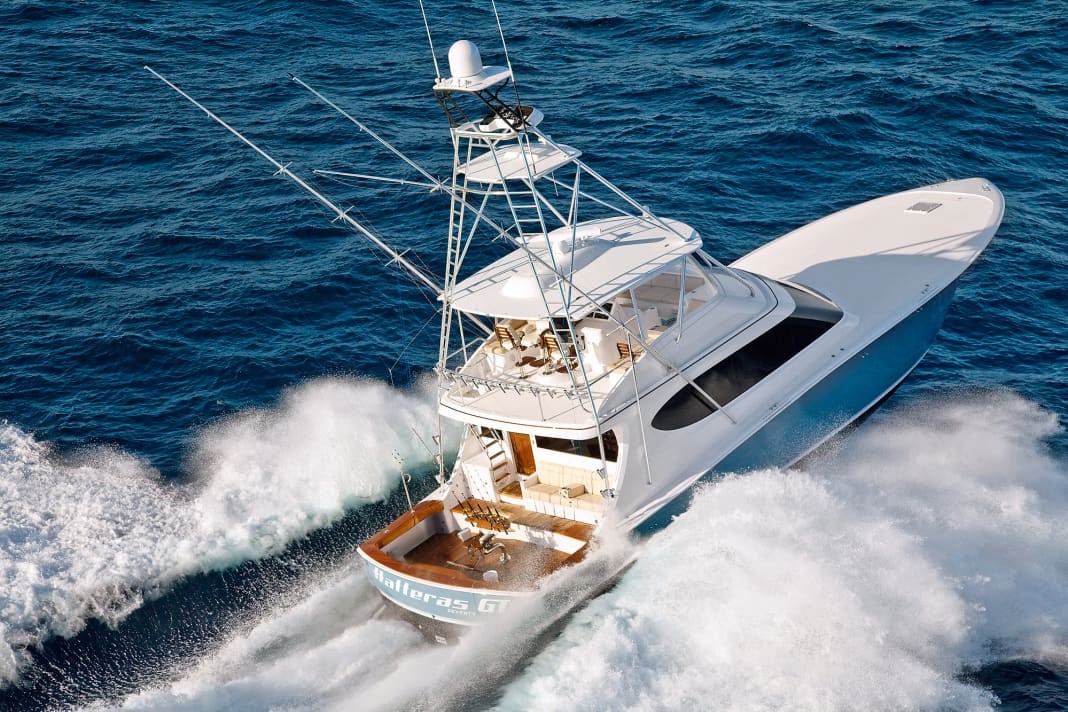
Some call it terminus technicus, others "technical jargon". This refers to technical terms or jargon that the average consumer can do little or nothing with. And this often leads to frustration, and not just when searching for the right type of boat.
The distinction between a glider and a displacer is always part of the basic knowledge. Let's keep it short: in a planing boat, the entire weight of the boat is carried by the dynamic buoyancy based on the hull shape and engine power. This means that the boat is completely lifted and glides on the water.
Displacers are boats that have their entire underwater hull in the water and displace it in any sailing situation and swimming position. Even scholars sometimes argue about what a semi-planing boat is. An attempt at an explanation: Equipped with the right hull shape and plenty of horsepower, semi-planing boats are often able to overtake their own bow wave in order to gain speed and save fuel.
In our gallery above we show the most common and important types in the world of motorboats!
This article is part of a used boat special. You can find all other content here
The big BOOTE used boat special:
- The advantages and disadvantages of used boats
- How to find the right boat
- Boat exchanges: Your guide through the online jungle
- You should look out for these weak points
- Checklists for the test drive and inspection
- How to avoid traps in the purchase agreement
- What new owners need to know
- What insurance do I need for my boat?
Most read in category Boats

You have made the choice to become a boat owner soon. Congratulations! But among the many possibilities, do you know which boat to choose? In this article, the Band of Boats team has tried to draw up a list of the types of boats that can be purchased, so that you can choose the right one, that suits your needs.
1 – What are the main types of boats? 1.1 – Different types of motorboats 1.2 – Different types of sailboats 2 – How to choose the right type of boat?
1. What are the main types of boats?
Before you consider buying a boat, you should consider your future sailing programme. Not all types of boats are suitable for the same purpose. Let’s take a look at the many different types of boats to help you make your choice.
Among the very long list of boat types that exist, we can distinguish several large families. We can already distinguish between between monohulls and multihulls , called catamarans when they have two hulls, or trimarans when they have three.
Boats are also distinguished according to their means of propulsion:
- Motorboats , with inboard or outboard power, made up of one or more motors, electric or not.
- Jet boats or underwater thrusters , which use water projection to move forward.
- Sailboats, or sailing ships, which move with the wind and may have different numbers of masts.
- Boats propelled by human energy , notably through the use of oars.
Different types of motorboats
The list of different types of motorboats is very long. When it comes to buying a boat, the regular arrival of new units on the market makes the search even more complex. To help you choose a boat, we will try to introduce you to the main types of motorboats.
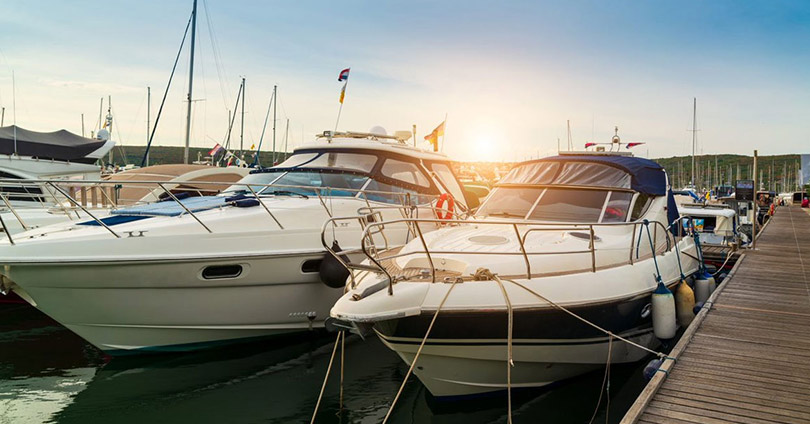
Become a motorboat owner
Discover our ads for used motorboats for sale!
Small fishing boat
These are motor-driven or small boats , perfect for solo or small group fishing trips . Lightweight and small in size, most rowboats are equipped with an outboard motor, which makes them fast and manoeuvrable. They are also fairly simple to operate and can be easily transported on a trailer, making them very practical for day trips. Rowboats are generally cheaper than other types of boats and are ideal for beginners or occasional anglers. However, their small size can make fishing a little more difficult in rough seas, and their storage capacity is limited. In addition, it is important to ensure that the engine is powerful enough to cope with the expected fishing conditions.
RIB (Rigid and Inflatable Boat)
The semi-rigid or inflatable boat (RIBs) is the lightest and easiest to move. While the RIB has a hard hull that can be made of different materials such as Hypalon-neoprene or PVC, the inflatable boat has an inflatable or slatted floor and can be fully deflated. This means that it can be stored in a small space in a storage bag. This makes this type of boat a very popular tender. With a hull length of up to 6 metres, the inflatable or RIB boat is versatile and has great stability. It is a shallow-draft boat often used as a dinghy – to link a larger unit to land, for fishing, or for coastal sailing.
It is a multi-purpose boat with an open hull, usually less than 6 metres long. There are three types of open boats , most often with outboard engines:
- The center console , with, as its name suggests, the helm in the centre (centre console) and sometimes a cabin.
- The walkaround , with an open central cockpit and often a small sleeping cabin.
- The bowrider , with an open bow to allow access to the foredeck and a double console or an off-centre console.
All have a V-shaped hull, and are very fast. They are affordable, ideal for daytime coastal sailing, fishing and water sports.
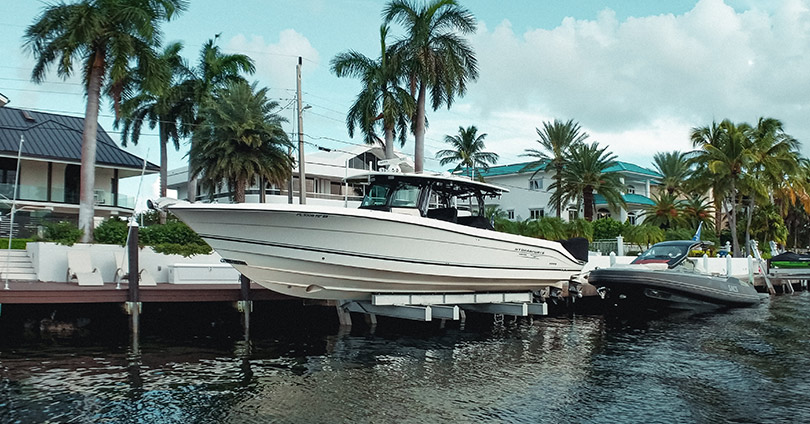
Day boats or day cruisers are small vessels, usually less than 6.5 metres long, with a small cabin. As the name suggests, the purpose is to spend a day or a weekend at sea . Its cockpit allows you to enjoy the sun. In terms of habitability, the day-boat cabin is sometimes equipped with a bunk and a small kitchenette, making it possible to spend a short stay on board.
Pontoon boat
It is the ideal boat model for water sports activities! The pontoon boat , or bass-boat, is in fact a floating platform with a shallow draught, designed above all for fun, with family or friends, on inland waters or in coastal areas, when the sea is calm.
Easily recognisable, the runabout is a type of fast, sporty boat with a low, slender hull, usually powered by a petrol engine. It is designed for water-based recreation , such as water skiing or fast cruising on inland waterways or the sea. The Runabout is generally easy to manoeuvre and maintain, but can have high fuel consumption and can be noisy due to its motorisation.
Offshore speedboat
It is a very fast unit with a slender hull that can reach speeds of up to 50 knots thanks to a very powerful engine. The V-shaped hull of the offshore speedboat makes it possible to in calm or rough waters, while experiencing great sensations . On the other hand, it is a boat with less than optimal habitability and requires high maintenance costs.
It is a boat that is propelled by a jet of water, and its speed makes it particularly suitable for water sports. It is generally very manoeuvrable, easy to maintain, and can be used in very shallow areas. The weak points of the jet boat are, without doubt, a noisy engine and high fuel consumption.
Cabin boat or cabin-cruiser
As the name suggests, the cabin boats has a habitable cabin. Its hull is between 6.5 and 14 metres long and it is equipped with an inboard or outboard motor, with one or more engines. It is used for pleasure sailing , to sail for a day or more in a comfortable manner, mainly in coastal areas. There are also cuddy cabin boats , which are vessels with a hull length of less than 10 metres, with a very small cabin or landing in the forward area below deck. They are the ideal motorboat for water sports and day cruising.
Pilothouse boat
A typical fishing boat is a boat with a sheltered cockpit in what is called a wheelhouse. The vessel usually has sleeping accommodation, a kitchenette and sometimes even a small toilet. The pilothouse boat or pleasure fishing boat also has a large, airy cockpit without benches, allowing for day fishing. With an inboard or outboard motor, it is mainly used to navigate in coastal areas, although its great stability allows it to pass through rougher seas.
It is a versatile vessel, ranging in length from 8 to 20 metres. The trawler is a comfortable unit, suitable for long voyages at reduced speed . Life on board is easy, thanks to the large interior spaces and the large water and fuel storage capacities. The trawler is generally used for coastal sailing, either for a day or for several days.
Cruisers / Express cruisers boats
With a hull length generally between 8 and 15 metres, the cruiser is a light and comfortable, versatile and often fast boat, which always has an enclosed cabin. There are different types of cruiser boats:
- The open express cuiser , with a closed front deck and an open rear cockpit
- The flybridge boat , with an upper deck with a steering console and sometimes an interior steering position.
- The hard-top yacht , with a hardtop that can be opened.
- The cruiser, or liveaboard boat , designed more to allow life on board.
- The speedboat , for sea outings that mix sport and cruising.
All have a V-shaped hull and an inboard engine. The type of speedboat chosen depends on the sailing project. There are also dutch barge , which, as the name suggests, are designed to sail on canals and rivers. They are very popular in countries like the Netherlands.
Highly regarded as the ultimate high-end vessel, the yacht is a pleasure craft distinguished by its luxury and elegance. They are large stars. They can be up to 100 metres long. Yachts are often used for luxury cruises, sea voyages or special events. The price of a yacht is often very high. It can range from 500,000 euros for second-hand yachts to tens of millions of euros for the largest yachts in the world.
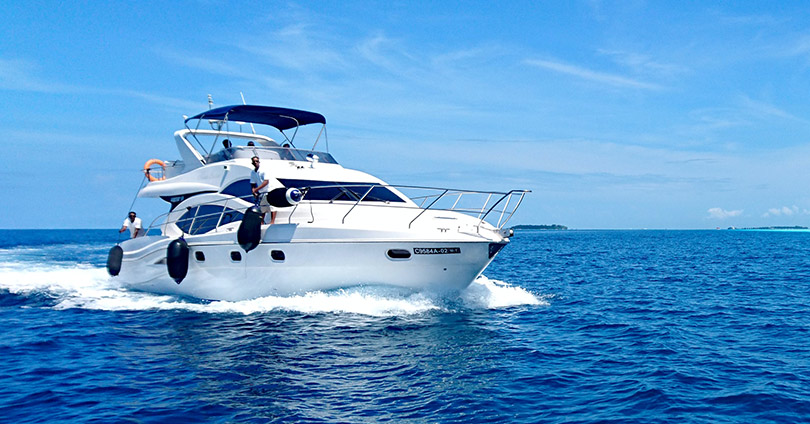
Houseboat barge
It is a river boat often used as a floating residence or as a pleasure boat for sailing on canals and rivers. It is a large and long type of boat, which allows for ample living space and comfortable facilities. They can offer a variety of interior layouts, with spacious living areas, bedrooms, a fitted kitchen and a full bathroom. Choosing to live on a houseboat can have several advantages such as peaceful living on the water, easy access to nature and a more affordable cost of living than in big cities. However, houseboats also require regular maintenance and special attention to safety due to the conditions of living on the water. The price of a houseboat varies according to age, size, location and general condition, but can generally be lower than a house in the city.
Fishing trawler
Initially dedicated to fishing, then redesigned to adapt to pleasure sailing, the fishing trawler is now a vessel adapted to long term cruising. The interior spaces are spacious and particularly well suited to life on board: there is generally a real kitchen, a real bathroom, common areas and well-separated sleeping areas. When sailing on a trawler, one benefits from great stability, reasonable draught and air draft. However, trawlers move more slowly than other lighter vessels, consume more fuel and often require more maintenance.
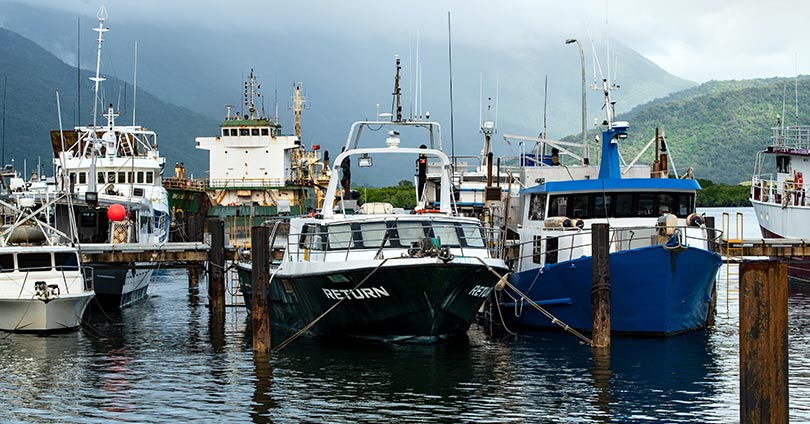
A barge is a flat-bottomed vessel, usually non-motorised and used for commercial or utility purposes , often for transporting goods.. A distinction is made between the splitting barge, which opens to unload what is contained in its central tank, and the myticole barge, which has a large storage capacity on its deck and can navigate in very little water. Barges are commercial vessels that can be used both at sea and on inland waters.
Power catamarans and trimarans
The power catamaran is a multihull motorboat with two separate hulls, connected by an upper deck. Like the catamaran, the motor trimaran is a multihull boat, this time with three separate hulls. On both types of power multihulls, the lower deck is usually dedicated to private spaces – sleeping and toilet facilities, while the upper deck usually contains the living spaces – saloons and cockpits. Motor multihulls are generally characterised by high stability at sea, and benefit from a shallow draft.
Different types of sailboats
When you want to buy a sailing boat , you will soon realise that there are many different types. Band of boats looks at the different types of sailboats and the sailing programmes that can be associated with them.
Become the owner of a sailing boat
Are you planning to buy a sailing yacht? Check out our used sailing boats for sale!
Monohull sailboat
Sailboat types are distinguished primarily by their rigging: they do not all have the same number of masts and do not all carry the same sails. The main types of rig are as follows:
- Sloop : a sailboat with only one mast, carrying a mainsail and a headsail.
- Cutter : also has only one mast, but located further aft. It can therefore carry two headsails – the jib and the staysail – in addition to the mainsail
- Le catboat : a sailboat with a mast set far forward, without shrouds or stays, and which carries only one mainsail
- Ketch :a sailing boat with two masts – the foremast, or mainmast, and the bowsprit, inside the waterline.
- Yawl : another two-masted sailing vessel, but with the aft mast lower than on a ketch and outside the waterline.
- Schooner : still with two masts, but this time with a larger foremast at the stern.
A distinction is also made between the various monohull sailboats according to their ballast: a sailboat can be a full or ballasted dinghy, a keelboat, a lifting keel or a sabre keel. There are also twin keel yachts, those with a fin keel or those with a canting keel.
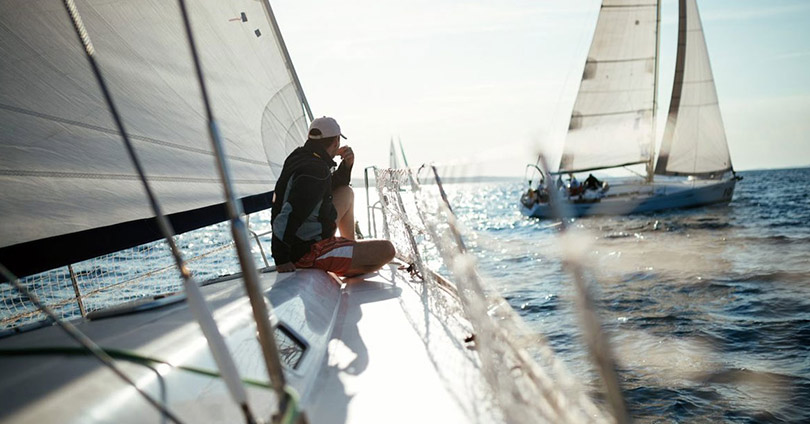
Here are some of the types of sailboats you can find on the market:
With a hull length of up to 10 metres, the day-sailer is a boat on which on-board comfort is reduced to the bare minimum. It is mainly used for day sailing. It is possible to envisage longer sailing trips, with a reduced crew, without much privacy.
Liveaboard sailboat
From 8 to 18 metres in length, the live-aboard yacht, also known as a cruiser, is equipped to accommodate a crew for up to several weeks. The water and fuel storage capacities on board are generally substantial. The facilities on board depend on the size of the vessel and, depending on the design category of the boat, it is possible to sail in coastal, semi-offshore or offshore areas.
Cruising sailboat
It is a heavier yacht, designed in a more resistant material, and therefore with a more robust hull. Designed for long voyages, the blue water cruiser is a safe boat, with a living space designed for life on board. The equipment on a blue water yacht generally includes a set of sails for sailing in all weathers, one or more solutions for producing energy on board, and sometimes a windvane gear.
Sailing yacht
Among all monohull sailing boats, from a hull length of 10 metres, we can speak of a “sailing yacht”. A sailing yacht is a boat with a particularly comfortable living space, offering a real living area with several berths, separate cabins, a large bathroom and a kitchen area on board.
Classic sailing yacht
Most often built of wood, the classic sailboat is a piece of maritime heritage, usually unique, associated with the history of regatta sailing, the history of ocean racing or the early days of pleasure sailing. Classic yachts are often very elegant on the water, particularly admired, thanks to their narrow, elongated hulls and large overlapping sails.
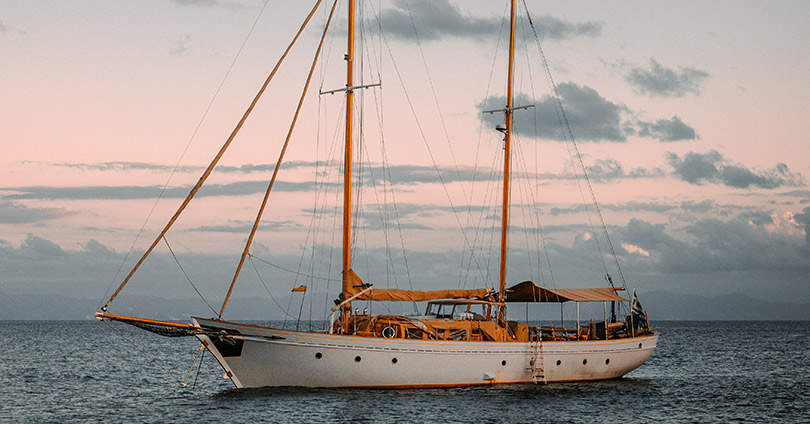
Belle Plaisance boat
The Belle Plaisance boat is more affordable than a classic sailboat, and is sometimes made in a few copies, whereas the classic sailboat is unique. The hull is also long and narrow and is often made of a less noble material than the classic sailboat, usually plastic. As with classic yachts, the headsails of Belle Plaisance yachts have a large overlap.
Catamarans are sailing boats with two hulls. They are very popular with sailors, especially for ocean cruising. Even though they are often used for a few days at sea or for long crossings, there are also small sport catamarans without a cabin. With their two hulls, these offer impressive stability, as well as a spacious and comfortable living space for the passengers. They can reach higher speeds than monohulls and are less prone to extreme heights. However, they tend to ride upwind less well, which can limit their manoeuvrability in certain conditions. The costs of purchasing a catamaran are generally higher than for monohulls, and the costs of maintenance and docking in ports are also higher.

Trimarans are three-hulled sailing boats. They therefore offer even greater stability than catamarans. They are often used for yacht races because of their exceptional speed, but are also used for cruising. Indeed, there are small sport trimarans as well as large travel trimarans. Like catamarans, they offer spacious living space for passengers, with greater privacy in the private areas. Trimarans are also less prone to extreme heights than monohulls, making them a popular choice for sailors seeking increased stability. However, as with catamarans, the costs of buying a trimaran are generally higher than for monohulls, and the costs of maintenance and docking in ports are also greater.
2. How to choose the right type of boat?
Before choosing your dream boat , and to make sure you make the right choice, we recommend that you ask yourself several important questions
- What is your intended sailing schedule?
- What type of propulsion system do you want to use?
- Who will be sailing with you?
- When and how often do you want to enjoy your new boat?
- In which sailing areas do you want to use it?
- Do you already have a mooring solution for your vessel, such as a harbour or mooring facility?
- How much money can you afford to spend on this boat purchase, taking into account possible future maintenance costs?
Once you have answered these questions, it will be easier to choose a boat that is right for you, whether new or used !
And if you’re more interested in sailing boats, take a look at our guide to choosing the right sailboat .
What type of boat should I choose to start with?
If you want to start sailing a motorboat or sailboat, you will need to buy a boat that matches your skills. In addition to buying a boat that matches your desires, we recommend that you choose a boat that is easy to handle, in good working order, and at a price that is not too high.
We advise you to choose a motorboat or sailing boat that is less than 10 metres long, to ensure that you can handle it well. A boat that is easy to handle and reacts quickly will allow you to get the maximum feeling and to learn how to perform the main manoeuvres correctly. If you make a mistake, a boat that is not too heavy will forgive most mistakes! We can therefore recommend small dayboats, open boats, RIBs or sailing boats such as dinghies or small daysailers.
What type of boat should I choose to live aboard?
If you are considering buying a boat to live aboard, you will need to choose a houseboat that you will feel comfortable on. Think about the life you want to lead on board:
Do you plan to live only on board, in a sedentary way, and stay at the dock or at anchor? If so, what items and equipment do you not want to do without? What budget are you prepared to allocate to a berth or anchorage?
Or would you prefer to buy a liveaboard yacht to live and travel on? Do you plan to cross the Mediterranean, the Atlantic or the Pacific? Would you like to go on a round-the-world trip? If so, you will probably need to choose a cruising boat or sailboat that will allow you to fulfil your wish.
Finally, the choice of boat you make will also depend on the number of people on board. Do you want to buy a boat to live on alone, as a couple or with your family?
A boat to live alone
If you plan to live alone on a boat, a small boat or sailboat with only one berth should be sufficient. Lack of privacy should not be a problem! It’s up to you to determine the conditions under which you plan to live on board: for example, do you want a fridge, a toilet or a shower, or can you do without?
A boat for family life
If you are a couple or a family, your needs will probably be different. You will need to consider more berths, separate living areas, but also more storage possibilities. A sailing yacht, a catamaran, a trimaran or a trawler will allow everyone to have their own space, and to be equipped like at home.
Which boat to choose for inland navigation?
If you are planning to sail on canals, rivers and streams, you need to choose a boat that is suitable for inland navigation. But you may be wondering what is best. The narrowness of some canals, the sometimes narrow locks or the height of the bridges in the area you wish to visit may help you make your choice.
We recommend that you opt for a manoeuvrable boat with a maximum width of 2.50 metres, a maximum draught of 1.20 metres and a maximum air draught of 3 metres. If you choose a boat less than 20 metres in length, you will be able to navigate in river areas with a boating licence, and will have access to port sites without any particular worries. Finally, if you want to be able to change navigation area easily, choose a boat with a size adapted to road transport. For example, barges, Dutch launches, trawlers, launches and small transportable sailing boats are good boats for inland navigation.
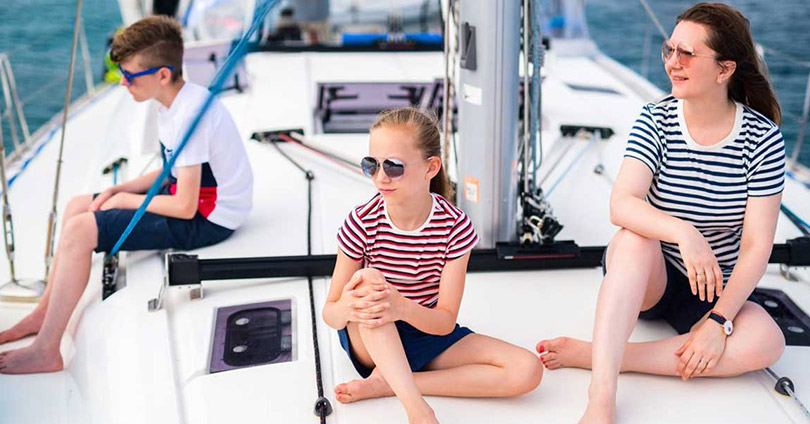
Interested in owning a river boat?
Check out our listings of river boats for sale
We hope that this article about the different types of boats will help you to choose the right boat for you. From now on, feel free to discover all our boat for sale ads and choose the boat of your dreams!
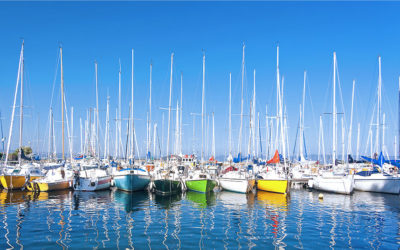
BoatMatrix News
Boating news for everyone, motorboat terms: different powerboat types, uses, and definitions.
There are many different kinds of motorboats, each with their own specific traits and designs. Learn all about powerboats right here.
There are many different types of motorboats, from small runabouts to superyachts, with a vast array of hull shapes, construction materials, and propulsion systems. Sometimes referred to as powerboats, motor yachts, or superyachts (typically when over 100 feet long), what these boats share in common is that they all have some sort of engine or motor for propulsion, instead of harnessing the wind like a sailboat. We’ll give you the details on everything you need to know about different motorboat types, hull shapes, construction and, well, just about everything needed to be able to speak powerboat fluently. Next thing you know, you’ll be bandying about terms such as deadrise and vacuum-bagging.
Modern motorboats come in all shapes and sizes, and may have several different types of engines. Read on, to find out why this Pursuit OS 385 is not just a powerboat, but is also a deep-V outboard planning walkaround boat—and to learn a whole lot more.
THE POWERBOAT BASICS
Powerboats come in all shapes and sizes. The smallest recreational powerboats are craft such as rigid-hulled or inflatable dinghies and personal watercraft, while the largest recreational power craft include large motoryachts and even megayachts. But before we get buried in the ins and outs of powerboat types, let’s take a look at the basic pieces and parts that make up most any power-driven craft.
All powerboats have a bow (the front) and a stern (the back). All have hulls (the bottom of the boat) and all have a topsides (everything from the hull up). Beyond these basics, all boats have a huge number of pieces and parts that have their own nautical names. You can learn them all, by reading our Beginner’s Guide to Boat Terminology .
Do you know the bow from the stern? If not, you will after reading our Beginner’s Guide to Boat Terminology article.
HULL SHAPES
The ultimate end use of a boat will decide how its hull is designed and shaped. For example, offshore fishing boats generally need hulls with a deep-vee shape to help contend with choppy seas, while a deck boat engineered for use on lakes and rivers might have a modified vee with less angle in the hull. Other powerboats, such as trawlers and tugs, usually have more rounded hull shapes. Watch Lenny’s Boating Tips Video: Boat Hull Basics to get a visual explanation of the many different powerboat hull types.
In the most basic forms, there are three hull types you’ll see out on the water:
- Displacement Hull : A displacement hull is one in which the amount of water the hull displaces does not change significantly as speed increases. In other words, the hull never really gets up on top of the water. Rather, it rides in it, pushing large volumes of water out of its way. The advantages of displacement hulls are that they tend to be very fuel efficient at low speeds and can be powered by smaller engines for a given length. The downside is that they’re typically much slower than other hull types. Trawlers, tugs, Downeast, and other passage-making powerboats are often built on displacement hulls.
- Semi-Displacement Hull : A semi-displacement hull is one that is designed to allow it to partially escape the confines of the water. In other words, instead of riding completely in the water as a displacement hull does, a semi-displacement hull can ride partially on top of the water at higher speeds. While more horsepower and fuel are usually required to drive a semi-displacement hull, it can travel at higher speeds than a purely displacement hull. Larger powerboats such as motoryachts, cabin cruisers, trawlers, and tugs powerboats often have semi-displacement hulls.
- Planing Hull : A planing hull is designed to break free of the water, riding mostly on top of it at high speeds. A planing hull transitions from acting like a displacement hull at low speeds to planing as it climbs up on top of the water. Planing hulls require more horsepower for a given length to reach top speed, but are also generally able to reach much higher speeds than other hulls types. Most recreational motorboats are built on planing hulls, including watersports boats , fishing boats , performance boats , and more. Some planing hulls have steps in the hull—engineered indentations—to increase planing and top speed performance. Get the details on hull steps by watching Lenny’s Boating Tips Video: Stepped Hulls .
Breaking it down beyond these three basic categories, there are many different hull shapes you’ll find in today’s modern powerboats.
Catamaran (Multi) Hulls : These powerboats feature two separate hulls, connected by a deck. They provide an exceptionally smooth ride, reducing impacts even when compared to most deep-vee hulls, as well as excellent static stability and tons of deck space. A couple of downsides to catamaran powerboat hulls are that turning performance is generally not as good as monohulls, and not everyone finds the aesthetics of a catamaran powerboat pleasing. Though rare, there are some trimaran powerboats out there. These boats utilize three separate running surfaces.
Cathedral Hulls : Though cathedral-hulled boats are a relative rarity these days, you can still find them on the used market. These hulls have twin outboard appendages outside a vee-type main hull with open spaces between. This hull type planes very easily and is quite stable, though the greater exposed area at the bow can produce banging in choppy conditions.
Deep-Vee Hulls : Deep-vee boats are known for their ability to slice through rough seas, and they do it better than the majority of other hull forms. But deep-vee boats can have a tendency to roll quite a bit in a beam sea, as well as wallowing in turns.
Flat Bottom Hulls : Flat-bottomed boats like bateaus or Jon boats are typically designed for inshore waters and protected lakes and rivers. While the flat bottom provides more stability and has a shallower draft than most traditional vee-shaped or modified-vee hulls, this hull shape can produce an uncomfortable ride with lots of banging in rough conditions.
Semi-Vee Hulls : Semi-vee hulls generally have a sharp, vee-shaped entry at the bow with a transition to a flatter profile aft. These hulls are a bit more stable their deep-vee relatives, thanks to their flatter aft sections, but they are usually not as capable in rough conditions.
Pontoons : A pontoon boat hull is made with a deck platform mounted on two or more aluminum tubes that are pointed at their forward ends to cut through the water more efficiently. Pontoon-type hulls are among the most stable—especially triple-tube “tri-toon” pontoon hulls—but they are limited in their rough-water abilities.
Rounded Hulls : Rounded powerboat hulls are typically found in trawler and tug-type cruising boats, as well as other displacement cruisers such as Downeast and lobster yachts. Though these hulls can have a tendency to roll, they are extremely efficient, making them great for passage-making vessels. Some rounded hulls have an integral keel to improve stability and tracking.
For a more in-depth look at some of the most popular hull designs, read What Hull Shape is Best?
CONSTRUCTION TECHNIQUES
Most modern recreational powerboats are constructed of fiber-reinforced plastic, also known generically as “fiberglass” or “FRP,” though boats such as bass, multispecies, Jon boats, and pontoon boats are often built using aluminum. Larger boats, such as big motoryachts and megayachts, are typically built using either fiberglass, aluminum, or steel. Since most of the powerboats you encounter will be made of fiberglass, let’s take a look at the essentials of fiberglass boat construction.
Fiberglass boats are typically built using a precise female mold—essentially a negative of the hull, deck, or component shape. In that mold first goes a thick layer of gelcoat—a colored, high-quality, glossy resin. Next, workers start applying various layers of fiberglass cloth inside the mold, which is then thoroughly saturated with catalyzed epoxy, polyester, or vinylester resin.
Sometimes a reinforcing grid is added to strengthen the hull. Other times, a vacuum is applied to the mold to remove any excess resin. This generally makes a stronger, lighter hull. The process is called vacuum-bagging and you can find out more about it by watching our Boating Tips: Understanding Vacuum Bagging video. Once the resin has cured, the new hull is pulled from the mold. The deck and any other components, such as consoles and seating fixtures, are built the same way. Though the process can be much more complex, this is fiberglass boatbuilding in a nutshell.
Fiberglass is super-strong, but must be laid up in multiple layers to be most effective. This unfortunately adds a lot of weight, which can affect a powerboat’s performance. To solve this problem, builders often sandwich a core material made of balsa or foam between two layers of fiberglass. This makes the hull, deck, or other component stronger, but also lighter in weight than using just fiberglass. If you want to better understand how cored hulls are built and work, our Boating Tips: Understanding Foam Core Boat Construction video is worth a look.
THE POWER BEHIND THE POWERBOAT
Powerboats are typically fitted with one of five different types of propulsion systems: inboard, inboard/outboard (also known as stern drive), pod drive, jet drive, or outboard. Let’s take a look these different systems and their components.
- Straight Inboard : A “straight” inboard propulsion system consists of a gasoline or diesel engine, a metal shaft, and a propeller. The engine sits inside the boat and is connected to an external propeller via a fixed shaft that runs through a special fitting in the hull. As the engine spins the shaft, so spins the propeller, which pushes the boat through the water. (If you’re not entirely sure how a propeller works, watch Boating Tips: How do Propellers Work? ). Motorboats with a straight inboard are generally steered by a rudder, a vertical appendage that directs the flow of water in one direction or the other, causing the boat to turn.
- Inboard/Outboard (Sterndrive) : An inboard/outboard system—commonly referred to as a sterndrive—consists of an engine and an outboard drive unit. The engine sits inside the hull, while the drive unit (consisting of the transmission, steering mechanism, and propeller) is externally mounted. When the skipper turns the steering wheel, the entire drive unit turns, and so does the boat.
- Pod Drives : This relatively new propulsion system in recreational power craft consists of an inboard engine that is mounted to a drive unit underneath the boat. Like an inboard/outboard setup, the transmission, propeller, and steering mechanisms are all part of the drive unit. Unlike inboard/outboard systems, pod drives are typically mounted on the bottom of the boat’s hull and have the ability to swivel independently, offering superior vessel control. If you’re not familiar with pod drives, read All About Pod Drives .
- Jet Drives : Jet drive systems use an inboard engine to spin a metal impeller inside a large water pump. This pump sucks up seawater and then propels it at very high speed out the back of the boat. A good example of a jet boat is a personal watercraft (PWC), though there are a handful of watersports and cruising boats that use them. An external nozzle and bucket assembly is used to direct the thrust, thereby steering the boat.
- Outboards : An outboard engine has its propeller, transmission, and engine block in a single, self-contained unit that is mounted on the outside of the boat, typically on the transom. Cables and hydraulic rams are connected to the outboard to move it back and forth to steer the boat.
For a comprehensive run-down on all the different power options available to boaters, read Marine Engines and Power Systems: The Good, the Bad, and the Ugly .
TYPES OF POWERBOATS
There are almost as many different powerboat types out there as flavors of ice cream, and they’re all designed to do different jobs based on what people intend to use them for. If you’re wondering how to figure out the right sort of motorboat for you, consider browsing our What Type of Boat is Right for You? Top 10 Choices for Boaters feature. Though there are literally dozens of different styles of powerboats, here are the basic types you’ll want to know.
- Bass Boat : A type of boat that generally has a flat deck, low freeboard, and a shallow draft and is used primarily for fishing on protected lakes and rivers.
- Bay Boat : A low-freeboard center console fishing boat designed for near-shore and coastal use. To learn more, check out our comprehensive feature Bay Boat Battles: What Makes One Better Than the Other .
- Bow Rider : A powerboat with a seating area set in its bow. Consider checking out our buyer’s guide Bow Riders: 10 Key Considerations Before You Buy .
- Cabin Cruiser : Generally, any larger motorboat that provides sleeping accommodations within its structure. This generic term can be used to describe motoryachts, expresses, and a number of different designs.
- Center Console : A powerboat with its console and helm located in a central location on deck. Read our feature Center Console Boats: Fish, Cruise, or Just Have Fun to get the skinny on this class of boat.
- Convertible : A boat with a flying bridge built atop the cabin, and an open cockpit aft.
- Cuddy Cabin : A powerboat with a relatively small cabin on its bow section. Learn what makes these great boats tick by checking out our feature Cuddy Cabin Boats: Family Friendly Fun .
- Deck Boat : A motorboat with a flat, open deck plan and without any below-decks accommodations. To create more forward deck space, most deck boats have a rather boxy shape, instead of tapering to a point at the bow.
- Downeast Boat : A traditional style of boat that is derived primarily from commercial Downeast lobster boat designs of the American Northeast.
- Dual Console : A boat with twin dashboards that are separated by a walk-through that allows access to a forward cockpit or seating area. You can get an idea of what these boats are all about by reading our feature Dual Console Boats: The Good, The Bad, and The Ugly .
- Express Boat : A sleek powerboat with a steering station on deck level, no flying bridge, and a cabin forward of and lower than the helm station. Folks in the market for an express cruiser would be wise to browse our Choosing the Perfect Express Cruiser article for more information.
- Flats Boat : A powered skiff designed with an extremely shallow draft for fishing on flats and other shallow-water areas.
- House Boat : Just as the name implies; these are boats that have a large home-like accommodations built on a barge-like hull.
- Inflatable Boat : Any boat with an inflatable collar and a flexible bottom. Learn more about these utilitarian craft by reading our article on Choosing the Perfect Inflatable Boat .
- Jon Boat : Small utilitarian craft with a flat bottom, which are usually constructed of aluminum.
- Motorsailer : A boat that relies primarily on engine power for propulsion, but also has a mast and sails to improve its passage-making efficiency.
- Multi-species Boat : An open and rugged dual console boat with a utilitarian cockpit that’s designed primarily for fishing lakes and rivers. Most are constructed of aluminum.
- Personal Watercraft : Small, open, jet-powered watercraft that can seat one to three people. Often abbreviated as “PWC.”
- Pontoon Boat : A flat-decked boat with a perimeter fence built atop two or more aluminum pontoons. Find out all about these party platforms by reading Pontoon Boat Basics .
- Rigid Inflatable Boat : A boat with an inflatable collar built around a rigid fiberglass or aluminum hull. Also known as “RIBs.”
- Runabout : A generic term used for any small powerboat, generally meant for day-boating with limited (if any) below-decks accommodations.
- Superyacht : Extremely large, expensive yachts commonly 100′ and longer in length. These may also be called “Megayachts”.
- Tow (Watersports) Boat : A boat designed and built with an eye toward towing people who enjoy watersports such as wake boarding, wake surfing, or water skiing.
- Trawler : A rugged, long-distance recreational powerboat designed for cruising, which resembles commercial fishing trawlers.
- Walkaround : A boat built with side decks around the cabin, which allow people to walk around the cabin house and up to a foredeck.
While we’ll agree this is a lot of information to absorb, consider this page a resource you can reference over and over again as your basic powerboat knowledge grows. But don’t stop here. We also have articles covering the basics for buying and selling a boat . And once you have a boat of your own, you’ll want to make sure you know how to keep it in good shape by browsing our maintenance section . If sailboats are more your speed, be sure to read Sailboat Terms: Sailboat Types, Rigs, Uses, and Definitions . Finally, be sure to also review our seamanship section to make sure you’re running your boat in the smartest, safest ways possible.
Share this:
Related posts.

Hurricane Game

Five Ways to Make Your Outboard Engine Perform Better

Boat Buying Decision: One Engine or Two?

Winter Layup Tips for Your Boat

Buy new or buy used?

Green Boating

Become “Boat Smart”

Maintaining Your Investment

Detailing Your Boats Engine
Teaching the importance of boating safety, leave a comment cancel reply.

- Already have a WordPress.com account? Log in now.
- Subscribe Subscribed
- Copy shortlink
- Report this content
- View post in Reader
- Manage subscriptions
- Collapse this bar
- HELP ME TO CHOOSE THE PERFECT BOAT!
- +44 20 3769 3987
More results...
- Mediterranean
Indian-ocean
- Atlantic Europe
Pacific-ocean
- Catamaran charter
- Motor yacht charter
- Sailboat charter
- Gulet charter
- Luxury yacht charter
- 12 person boat rental
- 20 person boat rental
- 60 ft yacht charter
- Last-minute yacht charter
- Early booking yacht charter
- Bareboat yacht charter
- Crewed yacht charter
- Cabin yacht charter
- Flotilla sailing
- Easy sailing destinations
- Experienced sailing destinations
- Culture sailing destinations
- Family sailing holidays
- Honeymoon yacht charter
- Types of yachts
- Boat rental services
- Sailing routes, tours, trips, itineraries
"The best solution for your real time boat rental from experts you can trust!"
Motor boat types
Destinations
- 7 14 21 28 1 2 3 4 5 6 7 8 9 10 11 12 13 14 15 16 17 18 19 20 21 22 23 24 25 26 27 28 29 30 31 32 33 34 35 36 37 38 39 40 41 42 43 44 45 46 47 48 49 50 51 52 53 54 55 56 57 58 59 60 nights
Please select Sailing yacht Catamaran Motor yacht Motor boat Gulet Rubber boat (R.I.B.) Mini Cruiser Jet Ski
Home » Types of yachts » Motor boat types
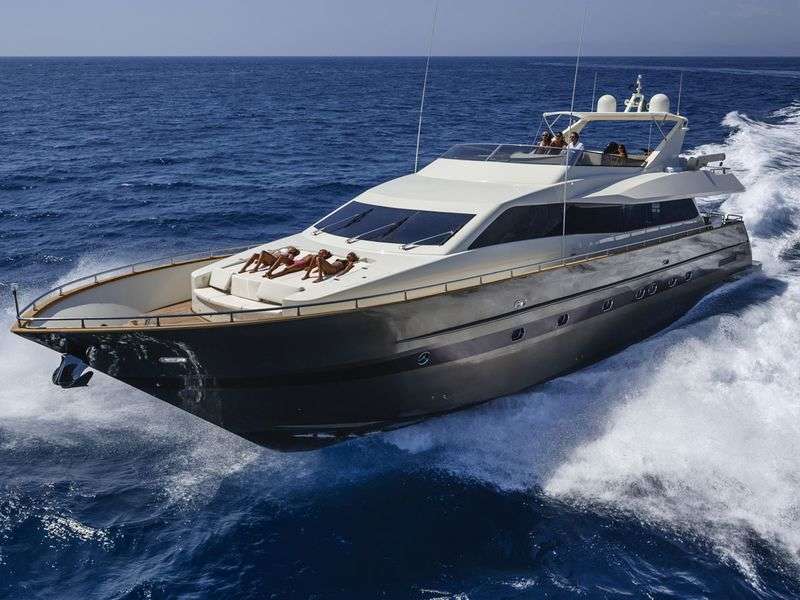
Why is motorboating fun?
Motor boat types: basic information, motor yacht types: the propulsion system of powerboats, before you start…, how to rent a motorboat.
Depending on the engine of the boat, we differentiate amongst several motorboats; there are types using the diesel engine, petrol engine or electric engine. Electric engines are becoming more popular these days due to their nearly zero-emission and low noise level. Motorized boats have many advantages. First, electric motorboats glide on the surface of the water smoothly, which is not the case with their loud diesel and petrol-powered counterparts. Skim across the waters with crazy speed and draw the attention of the people sunbathing on the beach, or just enjoy the sunshine yourself peacefully on the deck. Motorboats offer you the opportunity to access parts only available on the sea – you can explore all the hidden gems nature has to offer.
Benefits of renting a boat
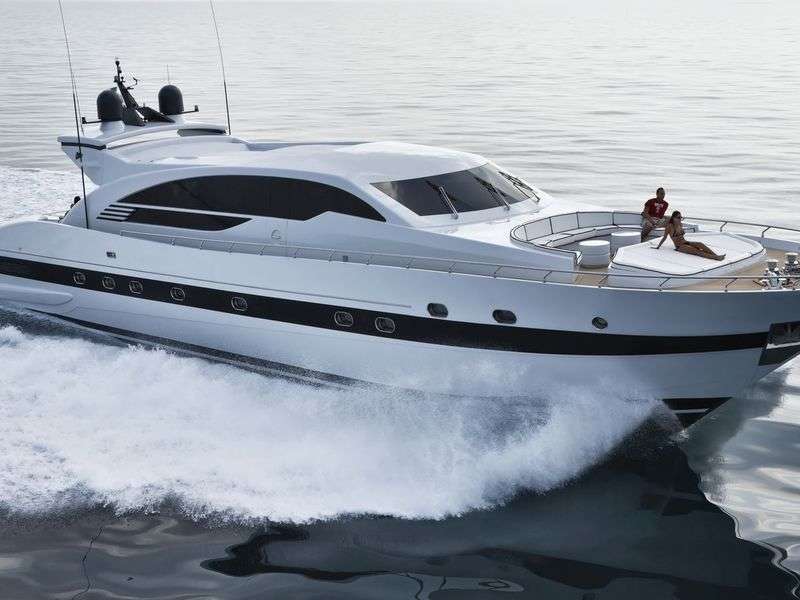
We distinguish the front part (bow) and the rear part (stern) of every powerboat and motorboat. Another part is the hull, which practically means the bottom of the boat, and there is also an upper part located above the hull. In addition to the ones mentioned above, every boat has its unique parts that all have a distinctive nautical name. Before delving into the topic of motorboat types, let us take a look at the basic components that constitute motorized vessels.
How are boats made?
The most advanced recreational motorboats are of fibre-reinforced plastic, or in other cases, aluminum. Larger boats such as motorized yachts and mega yachts are made of fiberglass, aluminum, or steel. Manufacturers use a casting mould during production. It is filled with resin amongst other materials. In some other cases, the vacuum is used to remove the excess resin. This is usually stronger and provides for a lighter hull. Fiberglass is extremely strong but needs to be applied in multiple layers for its full potential. This results in extra weight which can influence the performance of the powerboat. In order to solve this problem, manufacturers often insert a foam material between two layers of fiberglass.
There are typically five different propulsion systems when it comes to motorboats: straight inboard drives, inboard/outboard drives, pod drives, jet drives, and outboard drives.
Straight inboard drives
The straight inboard drive system consists of a petrol or diesel engine, a metal shaft, and a propeller. The engine is located inside the boat. It is connected to an external propeller via a fixed shaft that is fitted into the hull using a special method. As the engine spins the shaft, the propeller spins as well, which pushes the boat through the water.
Inboard / outboard (sterndrive)
An inboard/outboard system – often referred to as a sterndrive – consists of an engine and an outboard drive unit. The engine sits inside the hull, while the drive unit (consisting of the transmission, steering mechanism and propeller) is mounted externally. When the skipper turns the steering wheel, the entire drive unit turns, which also makes the boat turn.
This relatively new propulsion system, used in recreational power crafts, consists of an inboard engine mounted to a drive unit underneath the boat. Similarly to an inboard/outboard system, the transmission, propeller, and steering mechanisms are all part of the drive unit. Unlike inboard/outboard setups, pod drives are typically mounted on the bottom of the boat’s hull. They are able to swivel independently, which provides for superior vessel control.
The jet drive systems use an inboard engine; they spin a metal impeller inside a large water pump. This pump pushes the yacht forward at great speed by sucking up the water and using it for the process.
Outboard drives
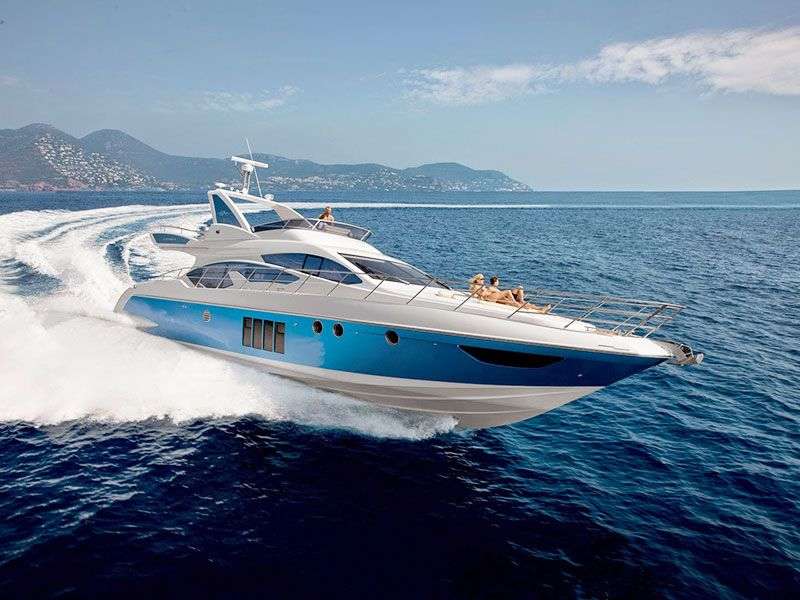
Motorboat types
Powerboats are available in several shapes and sizes. The smallest recreational boats are vessels such as pod engine boats, inflatable or personal watercraft. Larger recreational vessels include motor yachts and the so-called mega yachts.
Bass boats are typically used for freshwater fishing. They have low freeboard and a flat deck. Bass boats are ideal for fishing on inland lakes and rivers. They are quite expensive due to their special equipment and high-performance engine.
These vessels have a low freeboard, and their history goes back to medieval fishing. They are designed for use in shallow waters and shores, and near the coasts. During construction, it is taken into consideration that these vessels are usually used in saltwater. The boats are 18–24 ft long and are of fiberglass.
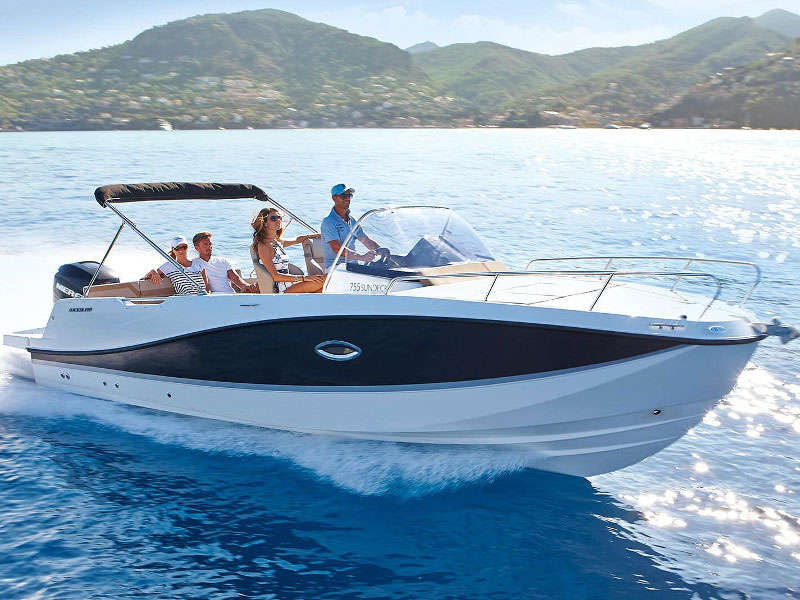
Center console boat
Center console boats are 13–45 ft long. As the name suggests, the steering wheel and the navigation system are in the middle. The open design helps fishermen walk along the deck. This modern construction allows the bow of the boat to emerge from the water when reaching a certain speed.
Cruisers are 21–45 ft long and have a small cabin in the bow. These cabins are usually sleeping accommodations. They are typically large enough to provide room for a small kitchen and several beds.
Cuddy cabin
Cuddy cabin boats have a small cabin and a seating area in their bow. They are usually 22–30 ft long.
Deck boats have a wide beam and a V-shaped design, which provides greater performance in terms of speed. The open deck is suitable for recreation for couples and families. They have an outboard or sterndrive system made of aluminum fiberglass. They are usually 25–35 ft long.
High-performance boat
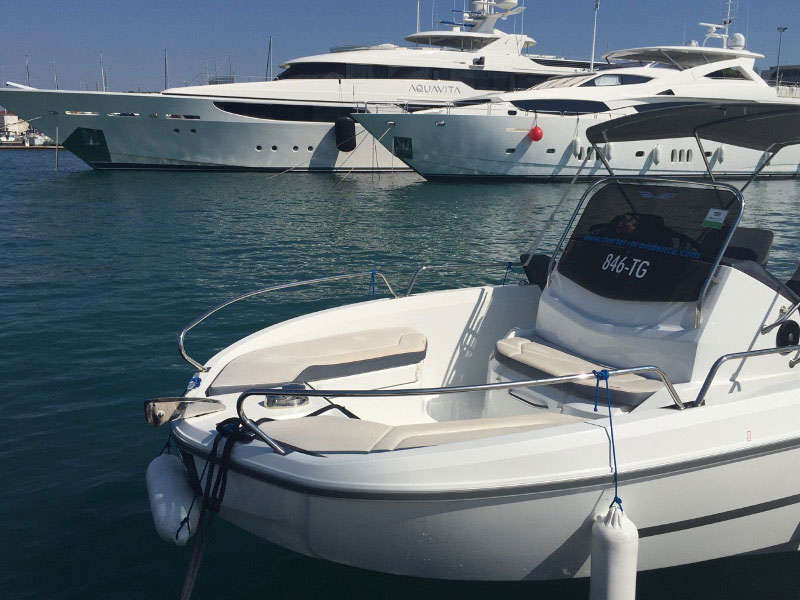
Jet boats have a single or multiple jet propulsion systems instead of a propeller. They are very agile. The small, 14–24 ft longboats are ideal for watersports.
Generally speaking, the Runabout boat is a small powerboat, they are 14–24 ft long. An outboard or a sterndrive system usually drives them. A Runabout is a multi-purpose vessel. It is ideal for watersports or fishing.
Choose a route! Get to know the destination before leaving the port! Read the guides, search for information about a route or contact the charter agency which will provide you with recommended routes in a graphical form. Take into consideration the duration of your rental. Plan your programs accordingly! We recommend cruising 3–6 hours a day. Taking into account the fuel consumption that depends on the weather, and the size and type of boat.
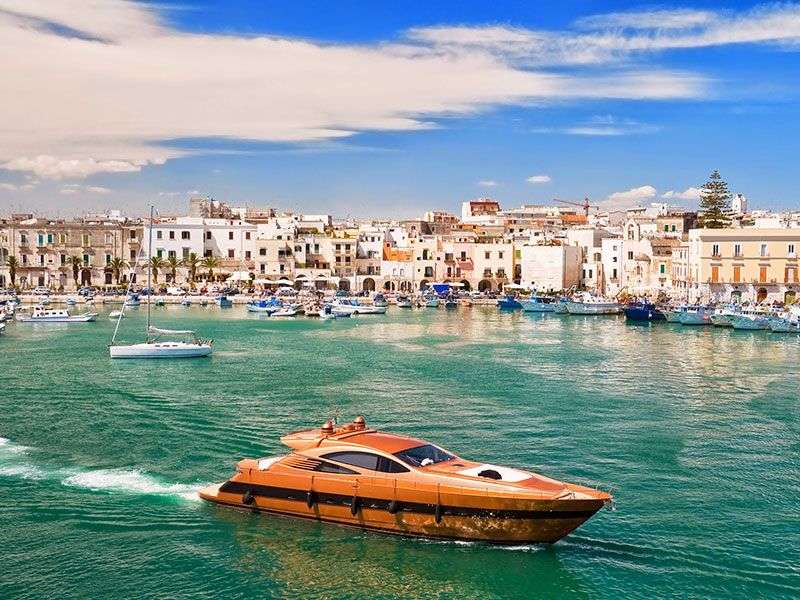
Safety first!
Sibenik - Croatia
wir durften vom 19.06. bis zum 26.06.2021 zum zweiten Mal einen wunderschönen Urlaub auf einer BoatTheGlobe-Yacht genießen.Mit dem wunderschönen Bali...
Anna und Günter (Austria)
Caorle - Italy
Amazing Luigi was a fantastic host, accessing all areas of the yacht. The deck was comfortable with lots of space to relax and sunbathe and drink in the amazing...
Sebastian (Belgium)
Ibiza - Spain
Very Impressed with the quality of service. We had a small malfunction of one of the yachts that we had on our charter and they repaired it right away. They truly went...
Mike (South Africa)
HELP ME TO CHOOSE THE PERFECT BOAT
Need to find the right boat with the help of an expert send us your needs and we will find the most suitable yacht for you we offer only boat rentals, 1-day cruises not.
- press the right mouse button on the e-mail received from us
- select the following from the options: Add sender to list of safe senders.
More information on our privacy policy and personal data protection .
BoatTheGlobe
"The best solution for your real time boat rental from experts you can trust!"
- Indian Ocean
- Pacific Ocean
- Sailing in … Sailing intineraries, ports, coasts & islands
Not to be missed!
Subscribe to our newsletter to be the first to know about discounted boat rental options!
What are the three main types of boats?
If you're considering buying a boat, you can choose from human-powered boats, sailboats, and motorboats. Once you've settled on a type of boat, pick a style or model suited to what you want to do and where you live. Some boats are better for lakes, for example, while others are good for the ocean.
Explore Progressive's editorial standards for Answers articles to find out why you can trust the insurance information you find here.
Types of boats
The following are some examples of different types of boats powered by wind, a motor, or human effort.
Sailboats use sails to catch the wind and propel them through the water. There are many types of sailboats and larger yachts, which people use for recreation, sports, and transportation over long distances. There are several different sailboat styles, and they're often classified by the design of the hull.
- Monohull : The most straightforward and most familiar design, monohull ships have a single, large body that sits low in the water and floats by displacing water
- Catamaran : This style has a wide construction of two small hulls joined by a deck, which gives more deck and cabin space and rides higher in the water
- Trimaran : Like a catamaran but with three hulls (hence the name). They’re like catamarans but more stable, thanks to the third hull. Within these hull types, sailboats can be further divided into day sailers, ketches, and cruisers.
Learn about protecting your investment with sailboat insurance .
Boats that use a motor for power are often classified by the activity they're best for as well as the way they're constructed. Powerboats come in various sizes and styles, and people often use them as tenders or accessory boats for larger vessels. Common types of powerboats include:
- Day cruisers : This category doesn't often include cabins.
- Cuddy cabins : Larger boats with a central cabin and enclosed deck.
- Bowrider : Open vessels with seating in the bow and wide, flat bottoms.
- Cabin cruisers : A medium-sized design that often includes an aft cabin with basic dining.
- Center consoles : A great choice for fishing boats because they have ample space for you to move around when wrangling a big fish. Center consoles are also seaworthy.
- Express cruisers : Similar to a cabin cruiser but include a seating area, galley, bathroom and sleeping space.
- Downeast boats : Boats with enclosed hard-top cabins, pointed bows, and exterior railings.
- Tow boats or ski/wakeboard boats : Boats used to pull water sports gear like water skis are called tow boats.
- Motor yachts : These powerboats are more than 40 feet long with accommodations for long-distance cruising rather than day cruising.
- Fishing boats : These are suited for casting a line, but some powerboats are better suited to fishing than others.
- Bass boats : Designed to make fishing easy with fish finders, swiveling seats, and more.
- Trawlers : Similar to motor yachts, but with a different hull design that trades speed for greater stability and comfort.
- Pontoon boats : Consists of a platform fixed to two or more buoyant metal tubes. Learn how pontoon boats work .
Learn about the differences between sailboats and powerboats and what kinds of recreational and sports activities each is best suited for.
Human powered boats
Common types of small boats include skiffs (simple, lightweight boats often used for recreational fishing) and dinghies (small, flat-bottomed, often inflatable boats). Small boats can be made of various materials, including wood, aluminum, and fiberglass, and some are even inflatable. The following are examples of small boats powered by wind, human effort, or a small outboard motor:
- Dinghy : A small boat often used as a tender for larger vessels. A dinghy can be propelled by a sail, small motor, or oars.
- Kayak : A narrow, human-powered boat propelled by a double-bladed paddle. You can paddle a kayak on lakes, rivers, or in the ocean
- Canoe : Another small, human-powered boat that is slightly wider than a kayak and uses a single-bladed paddle
- Jon boat : This is a flat-bottomed, shallow water boat with bench seats. It's a popular fishing boat for calm lakes and ponds.
- Skiff : This is another flat-bottomed small boat powered by oars, a sail, or outboard motor, often used as a tender or for fishing
- Inflatable boat : These small boats are lightweight and easy to store when deflated. Some have rigid floors to support an outboard motor.
Protect your boat and your assets
Although it's only required in a few states, a boat insurance policy can protect your investment. If you're buying a boat for the first time and financing it, your lender will typically require you to insure your boat. And if you dock at a marina, they may also require proof of insurance. Learn more about what boat insurance covers and how boat insurance works .
What are the best types of boats for lakes?
The size of the lake and your choice of recreational activities will determine the size and type of boat that will suit your needs. If you're spending time on big lakes with deep water, you might choose a boat that you could also use in the ocean like a cabin cruiser. If you spend most of your recreational time at smaller, shallow lakes, you may do better with a pontoon boat. Options for the best boats for lakes typically include:
- Day cruisers
- Pontoon boats
Some of these boats are best for families , and if you have a family, or if you entertain groups of friends, you might consider a boat with overnight accommodations on larger lakes, like an express cruiser.
What are common types of boats for the ocean?
You have many options regarding types of boats suitable for the ocean . In general, ocean-going vessels may need to be bigger than lake boats for more stability in handling waves and deeper or choppier waters. Good options for saltwater boats include:
- Cabin cruisers
- Express cruisers
- Motor yachts
- Center consoles
If you're buying a boat for the first time , learn more about the best first boats to buy and the best time of year to buy a boat .
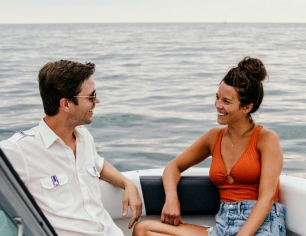
Enjoy life on the water with boat insurance from Progressive
- Get a quote
- Or, call 1-866-749-7436
Learn more about our boat insurance offering.
Have more questions? Browse articles by insurance type
See all articles by product

Car insurance

Home insurance

Renters insurance

Condo insurance

Motorcycle insurance

Boat & PWC insurance

RV/Trailer insurance

Life insurance

Pet insurance

IMAGES
COMMENTS
Learn about different motorboat types, hull shapes, construction, and propulsion systems. Find out how powerboats are designed for various purposes, such as fishing, cruising, watersports, and more.
Learn about different kinds of powerboats, from aft-cabin to yacht, and how they are used for various purposes on the water. Find out the features, sizes, and advantages of each type of powerboat with examples and pictures.
Bowrider. A bowrider has an open bow area designed for extra seats forward of the helm. Bowriders are usually 17'-30'. They are powered by either stern drive or outboard engines. Considered a family boat and can be used for fishing and water sports. A good choice for those new to boating.
Small motorboats between 14-24 ft. in length are known as runabouts. They can be used for water sports, cruising, or fishing; runabouts can be powered by a sterndrive engine or an outboard motor. The open boat has a steering wheel behind a windscreen as well as forward controls. Runabout motorboats can accommodate up to eight people.
Learn about the various kinds of motorboats, from small runabouts to superyachts, and their hull shapes, construction materials, and propulsion systems. Find out the advantages and disadvantages of displacement, semi-displacement, and planing hulls, and see examples of different powerboat types.
Three Main Types of Boats. When we look at boats, in general, there are three main types: Motorboats (power boats) Sailboats Man-powered boats. Sailboats rely on wind for their power while man-powered boats include personal watercraft like kayaks, rafts, and canoes. Motorboats, AKA speedboats, cover every type of boat with either an outboard or inboard motor.
Powerboat Types. Aft-Cabin: The aft-cabin boat has a stateroom on the stern of the boat. This type of boat has a ladder or stairs to access the cockpit as well as the helm. It is also a flybridge but there is a stateroom located on the stern of the boat. The inboard engine is centrally located, generally underneath the living room floor.
Motorboats offer a fun and convenient way to get out on the water and explore. Types of Motorboats. When considering which type of motorboat is right for you, there are several different types to choose from. Small outboard motorboats, such as Jon boats and dinghies, are great for fishing, duck hunting, and cruising around a lake or pond.
Motorboats come in many types. The outboard runabout, or motor launch, is a fairly small open boat with seats running laterally across the width of the craft and occasionally with decking over the bow area. Inboard runabouts are usually a bit larger and are either open or have a removable shelter top.
Depending on your vessel size, the planning hull may require more horsepower from the engine to reach the top speed. However, it quickly helps reach much higher speeds than other hull types. Watersports, performance boats, fishing vessels, and other recreational motorboats generally have planning hulls on them. 2. Displacement Hull
A motorboat is a small craft with one or more engines for propulsion. Motorboats are commonly used for work, recreation, sport, or racing . Boat engines vary in shape, size, and type. These include inboard, outboard (integrating, the engine, gearbox, and propeller in one portable unit mounted in the rear), and inboard-outboard (or "sterndrive ...
Types of motorboats. A speedboat is a small motorboat designed to move quickly. It is often used in races and for water skiing. Even inflatable boats and dinghies with a motor attached are classed as types of motorboats. The three popular variations of motorboats are: inboard, inboard / outboard and outboard. If the engine is fitted within the ...
Different Types of Motorboats Explained. Updated: Apr 17. As you venture into the world of boating, familiarizing yourself with various boat types becomes essential. Especially if you're inclined towards adventure sports and water activities, choosing the right boat is crucial to ensure you make a wise investment. To help you navigate this ...
Types of Motor Boats. Motorboats have surged ahead, outnumbering their sailboat counterparts. They navigate coastal waters, serene lakes, meandering rivers, and occasionally brave open oceans. The range is vast, from modest skiffs equipped with basic outboard engines to grandiose motorboats and cruisers wielding formidable power.
Types of Motorboats: River Cruiser River Cruisers are popular amongst Europe's inland waterways, comprising of fold-down screens, sliding coachroofs and consist of a flat-bottomed or shallow V-shaped hull. This design allows for maximum stability while the interior is designed to maximise living space and value for money.
Very stable and beamy (wide), pontoon boats are great for entertaining on lakes and rivers. Runabout boats: Runabouts can be used for fishing, cruising, watersports or as tenders to larger yachts. They're typically outboard-powered and 15-30 feet in length. Jet boats: Powered by jet drives rather than propellers, jet boats are usually under ...
Types of Motorboats: Straight Inboard Drives: A straight inboard drive system includes both a petrol and diesel engine type, a propeller, and a metal shaft. The engine is internally placed in the boat. A special method is used to connect the engine to an external propeller through a shaft that is fitted into the hull. The boat moves through the ...
In our gallery above we show the most common and important types in the world of motorboats! This article is part of a used boat special. You can find all other content here. The big BOOTE used boat special: The advantages and disadvantages of used boats; How to find the right boat;
The list of different types of motorboats is very long. When it comes to buying a boat, the regular arrival of new units on the market makes the search even more complex. To help you choose a boat, we will try to introduce you to the main types of motorboats. Become a motorboat owner.
There are many different kinds of motorboats, each with their own specific traits and designs. Learn all about powerboats right here. There are many different types of motorboats, from small runabouts to superyachts, with a vast array of hull shapes, construction materials, and propulsion systems. Sometimes referred to as powerboats, motor yachts, or superyachts (typically…
There are several types of motorboats and powerboats. There is a wide range of vessels available on the market; smaller ones and super boats, watercrafts built from different materials and driven by different propulsion systems. What is common in these boats is that they are motorized and do not have a sail that uses the wind to push them forward.
Cruiser sailboats have a minimum total sail area of 299 square feet, a maximum total sail area of 2,520 square feet and an average of 865 square feet. Daysailer Boats. Daysailer sailboats are medium-sized, trailerable, sailing vessels usually used for time-honored on-the-water activities such as day sailing and racing.
Discover three main types of boats: human-powered, sailboats, and motorboats and the best. Learn about the best boats for lakes, oceans. ... sailboats, and motorboats. Once you've settled on a type of boat, pick a style or model suited to what you want to do and where you live. Some boats are better for lakes, for example, while others are good ...
Hunter Type. Required for all resident motorboats and sailboats. Fee. $25.00. License Type Annual Aquatic Nuisance Species (ANS) Stamp. Hunter Type. Required for all non-resident motorboats and sailboats. Fee. $50.00. License Type. Annual Fishing License. Hunter Type. For resident adults aged 18 to 64. Fee. $41.83.